EXPLORING THE POTENTIAL OF NEBULISED BIOLOGICS
ENABLING HIGH-DOSE, HIGHLY RESPIRABLE POWDERS

EXPLORING THE POTENTIAL OF NEBULISED BIOLOGICS
ENABLING HIGH-DOSE, HIGHLY RESPIRABLE POWDERS




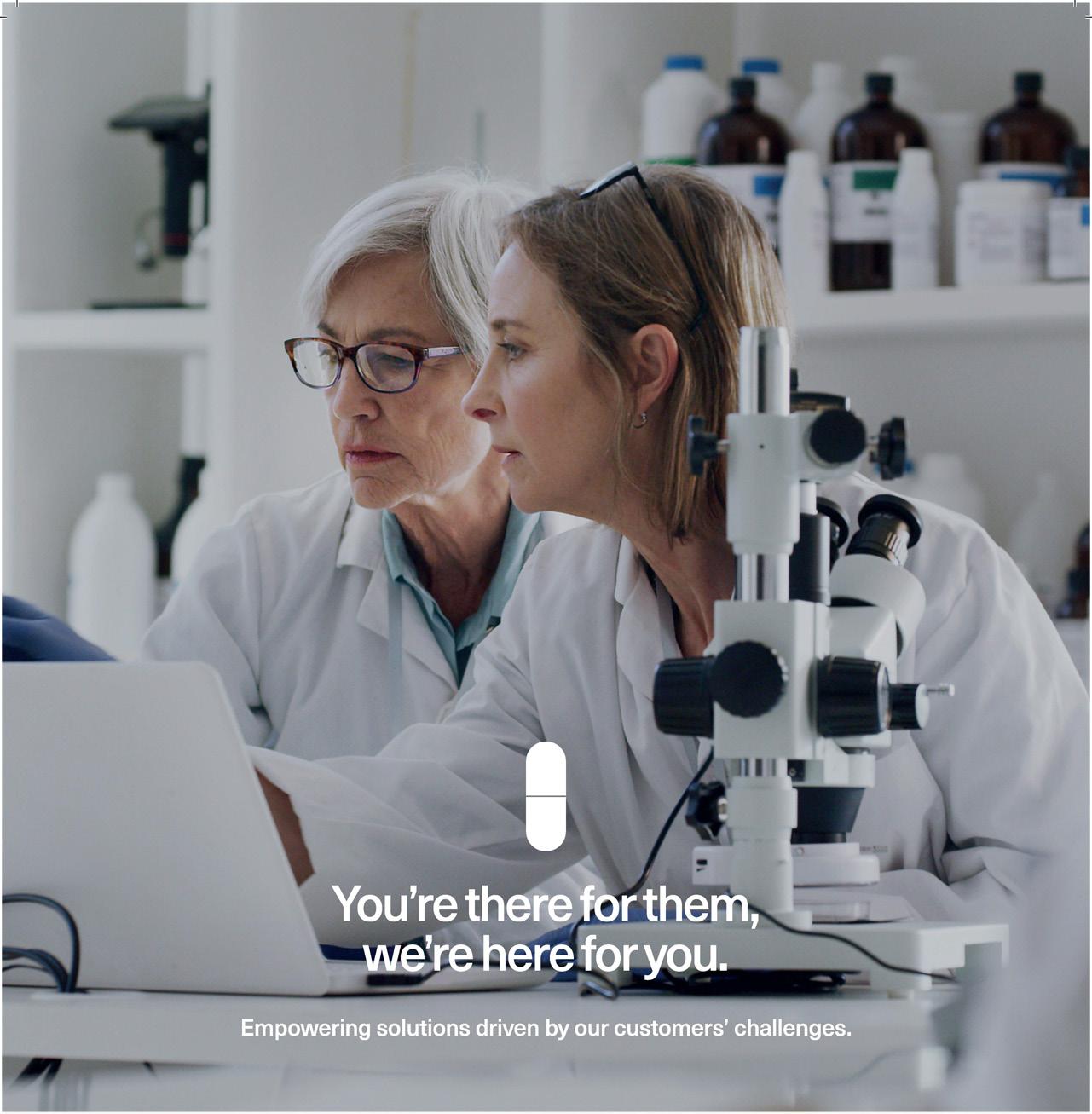
Quali-V®-1, the best solution to enhance the functioning of DPls.
With good mechanical properties, a low moisture content compared with gelatin capsules, and a controlled lubricated surface, these specifically designed capsules enhance the inhalation experience and ensure the successful delivery of inhaled medications.


• Very uniform spraying performance
• Exact half dose per nasal cavity
• Enables reconstitution
• Fast time to market
based on the proven Direct To Fill (D2F ™ ) pre-fillable glass syringe system
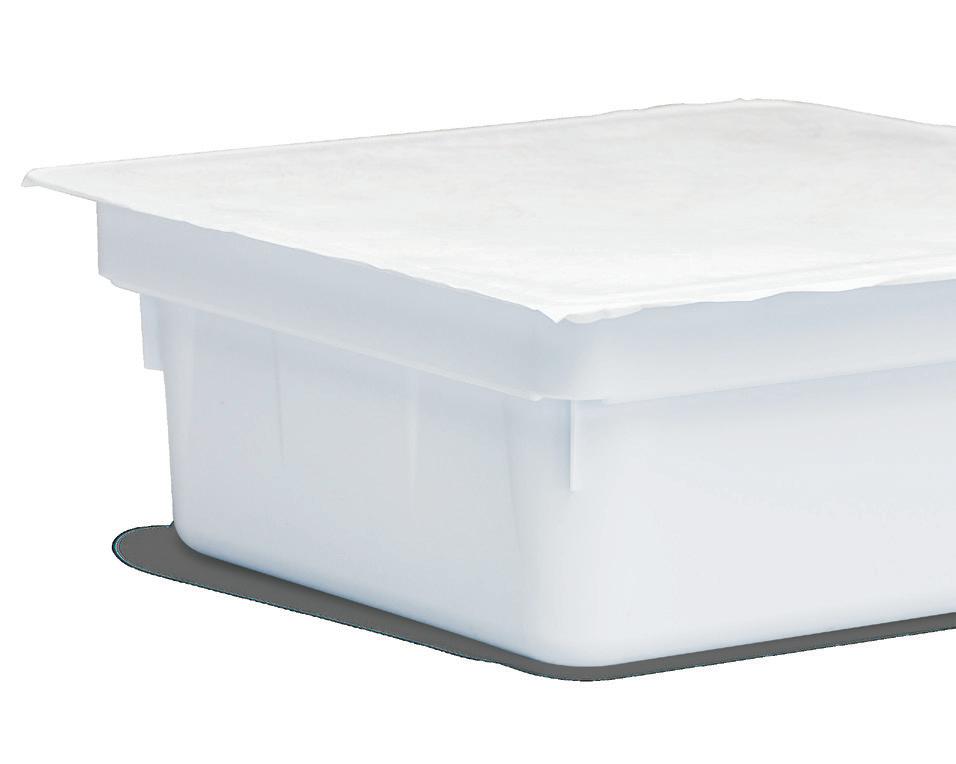



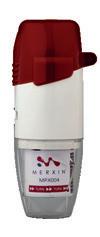

ONdrugDelivery Issue No 158, April 18th, 2024
This edition is one in the ONdrugDelivery series of publications. Each issue focuses on a specific topic within the field of drug delivery, and is supported by industry leaders in that field.
EDITORIAL CALENDAR 2024/25
Apr/May Drug Delivery & Environmental Sustainability
May Injectable Drug Delivery: Formulations & Devices
May/Jun Oral Drug Delivery
Jun Connecting Drug Delivery
Jun/Jul Industrialising Drug Delivery
Sep Wearable Injectors
Sep/Oct Drug Delivery & Environmental Sustainability
Oct Prefilled Syringes & Injection Devices
Nov Pulmonary & Nasal Drug Delivery
Dec Connecting Drug Delivery
Jan 2025 Prefilled Syringes & Injection Devices
Feb Skin Drug Delivery: Dermal, Transdermal & Microneedles
Mar Ophthalmic Drug Delivery
Apr Pulmonary & Nasal Drug Delivery
EDITORIAL:
Guy Furness, Proprietor & Publisher
E: guy.furness@ondrugdelivery.com
CREATIVE DESIGN:
Simon Smith, Creative Director (Freelance)
E: simon.smith@ondrugdelivery.com
SUBSCRIPTIONS:
Audrey Furness (subscriptions@ondrugdelivery.com)
Print + Digital subscription: £99/year + postage Digital Only subscription: free.
ADVERTISING:
Guy Furness (guy.furness@ondrugdelivery.com)
ONdrugDelivery is published by Frederick Furness Publishing Ltd
The Candlemakers, West Street, Lewes East Sussex, BN7 2NZ, United Kingdom T: +44 1273 47 28 28
Registered in England: Company No 8348388
ISSN 2049-145X print / ISSN 2049-1468 pdf
Copyright © 2024 Frederick Furness Publishing Ltd

ONdrugDelivery Magazine is printed sustainably by Newman Thomson Ltd, West Sussex, UK, using Forest Stewardship Council® certified recycled paper, vegetable-based inks, biodegradable laminates and carbon balanced materials offset via the World Land Trust™ following ISO140001 processes. ONdrugDelivery in print is sustainably shipped to events by DHL using GoGreen Plus whereby carbon insetting of at least 30% is achieved through the use of Sustainable Aviation Fuel (SAF), a biofuel substitute for traditional jet fuel, produced from renewable sources such as vegetable oils, animal fats, waste products, and agricultural crops. The magazine is mailed to individual readers around the world by DHL using GoGreen, which offsets 100% of CO2 emissions. 08 - 10
The ONdrugDelivery logo is a registered trademark of Frederick Furness Publishing Ltd.
The views and opinions expressed in this issue are those of the authors. Due care has been used in producing this publication, but the publisher makes no claim that it is free from error. Nor does the publisher accept liability for the consequences of any decision or action taken (or not taken) as a result of any information contained in this publication.
The Evolution of Pulmonary & Nasal Drug Delivery
Mike Needham, Global R&D Director; Product, Process and Device Development
Kindeva Drug Delivery 12 - 14
Exploring the Potential of Nebulised Biologics
Carolina Dantas, Manager of Medical and Scientific Affairs; and Ulf Krueger, Chief Executive Officer and Founder
Pulmotree Medical
Deep Breaths, Deep Dives: The New eFlow Integrated Nebuliser
Gesa Bräunlich, Portfolio Manager eFlow; and
Michael Hahn, Vice-President eFlow Partnering & Strategy
PARI Pharma
Bubble-Wrapped Remedies: How Lipid-Encased Therapeutics Could Transform Inhalation
Ethan Miller, Senior Biophysicist; and Heather Jameson, Senior Engineer
Springboard
Soft Mist Inhalers Versus Nebulisers: Delivery Equivalence & Future Therapies
Zaid Aqrawe, Business Development Manager; and Philippe Rogueda, Co-Founder & Chief Business Officer
Merxin Ltd
Darragh Murnane, Professor of Pharmaceutics
University of Hertfordshire
Bryan Eng, Doctoral Candidate in Pharmaceutical Sciences
University of Maryland
Interview
Sandy Munro, Senior Vice-President – Pharmaceutical Development
Vectura
Better in Vivo Prediction From OINDP Testing: a Goal Worth Pursuing?
Matthew Fenn, Head of Business Development; and
Clair Brooks, Applications Specialist
Copley Scientific
Advancing OINDP Clinical Trials with Speed and Efficiency: Strategies for Success
Julie Suman, Vice-President of Scientific Affairs
Aptar Pharma
Gemma Budd, General Manager
Nanopharm
ARCUS®: a Commercialised Technology Enabling High-Dose, Highly Respirable Powders
Alan Watts, Director of Innovation & Partnerships for Orally Inhaled Products
Catalent
Michael Tauber, Senior Director of Pharmaceutical Development
Acorda Therapeutics
High-Dose Delivery Platform for Crystalline DPIs
Susana Saldanha, R&D Manager – Inhalation and Advanced Drug Delivery; Lídia Santos, Analytical Scientist – R&D ; and Rui Churro, Senior Scientist – Inhalation and Advanced Drug Delivery
Hovione
Advancing Pharmaceutical Contact Applications with PEEK: Meeting Increasing Demands
Marcus Jarman-Smith, Head of Marketing – Medical; and Yann Tréguier, Global Drug Delivery Segment Leader
Victrex
Human Factors in the Absence of a Familiar Mental Model:
Challenges and Opportunities in Self-Administered Drug-Delivery Devices
Shai Assia, Head of Medical Device Development
Clexio Biosciences
Addressing CNS Therapies Through Nose-to-Brain Pathways
Alain Regard, Technology Product Manager;
Raphaële Audibert, Marketing Category Manager – Ear Nose Throat; and Audrey Chandra, Marketing Category Manager
Nemera
Interview – Exploring Nasal Casts in Nasal Drug Development
Julie Suman, Vice-President, Scientific Affairs
Aptar Pharma
How to Choose the Right Intranasal Vaccine Device
Nia Stevens, Consultant Mechanical Engineer
Team Consulting
The Path to Nasal Drug Product Commercialisation
Eric Kaneps, Vice-President of Sales & Marketing
Renaissance Lakewood


















Our inertia system for up to 30mg • Synchronised with patient breathing • Fits seamlessly with standard capsules • Easy to use, no training required • User independent •

























In this article, Mike Needham, Global R&D Director; Product, Process and Device Development at Kindeva Drug Delivery, takes a look at progress in inhalation technology and discusses what might lie ahead.
Physicians have treated illnesses with inhaled remedies for thousands of years. The pressurised metered dose inhalers (pMDIs) used today differ dramatically from the pipes, reeds and pots used centuries ago – but the benefits of inhalation devices have stood the test of time. As the inventor of the original pMDI, Kindeva draws on this legacy to develop the pulmonary and nasal innovations of the future.
The first known reference to therapeutic aerosol delivery dates to about 1554 BC. It describes Egyptians who were struggling to breathe fumes from heated plants. The delivery mechanism was a reed placed in a jar with a hole in the top. Plants were placed under the jar on hot rocks, then people inhaled the medicinal vapours through the reed.
Incense burners, pipes and funnels were popular mechanisms for inhaling herbs for medicinal and recreational use between about 1100 BC and the mid-1700s. These devices delivered a variety of inhaled treatments for asthma, cough and other lung and nasal problems.
The rise of manufacturing during the Industrial Revolution led to the first mass-produced therapeutic aerosols. Nebulisers and dry powder inhalers (DPIs) were introduced during this time. English physician John Mudge coined
the term “inhaler” in 1778. The Mudge inhaler, which looked like a teapot with a long nozzle, was the first known commercialised inhaler device.
Dr Auphon Euget-Les Bain developed the first atomiser in 1859 in France, but it involved directing a jet of mineral spring water against a spa wall. Nine years later, Jean Sales-Girons developed a portable version called the pulverisateur. The first plastic nebuliser arrived in the 1950s, shortly followed by other devices that used compressed gas.1
KINDEVA DELIVERS THE FIRST METERED DOSE INHALER
The early atomisers and nebulisers informed innovation through the 19th and 20th centuries. However, the pMDI’s debut advanced the landscape of therapeutic aerosol delivery. Kindeva (then called Riker Laboratories) introduced the first pMDI in 1956. Over the following decades, the industry experienced unprecedented growth, improving quality of life for hundreds of millions of individuals.
“The
pMDI’s debut advanced the landscape of therapeutic aerosol delivery.”

Mike Needham
Global R&D Director; Product, Process and Device Development E: mike.needham@kindevadd.com
Kindeva Drug Delivery
Building 39, Charnwood Campus Bakewell Road Loughborough
LE11 5RB
United Kingdom
www.kindevadd.com
A second wave of innovation occurred in 1987 with the signing of the Montreal Protocol on Substances That Deplete the Ozone Layer. That landmark agreement regulates the production and consumption of nearly 100 ozone-depleting substances. Inhaler technology has since diversified with enhanced delivery efficiency, updated DPIs and more advanced nebulisers. Kindeva played a significant role in this innovation with the launch of Maxair in 1986 and the Maxair Autoinhaler in 1992.
The inhalation technology space went through another round of innovation involving the elimination of chlorofluorocarbons (CFCs). Kindeva broke new ground in this space by getting the first US FDA-approved pMDI to use a hydrofluoroalkane (HFA) propellant on the US market in 1996. Since the last of the CFC propellants were phased out in the US around 2011, the industry has saved huge amounts of chlorine from entering the atmosphere and thereby greatly reduced the impact of inhalers on both ozone depletion and atmospheric warming. However, the journey continues as today’s pMDIs still use propellants with significant global warming potential (GWP), which can now be improved upon.
While the current HFA propellants have a much lower greenhouse impact than the original CFC propellants, standards change. The impact of these gases (over 1,000x that of CO2) is now unacceptable as the world works to reduce the human impact on the climate. The time has come for another change to the propellants used in pMDIs, and the industry is moving toward incorporating greener propellants into current and future products to create a sustainable future. Once again, Kindeva is leading the charge to bring these greener propellants to market.
“Unlike some CDMOs that have moved away from pMDI development, Kindeva believes their ongoing optimisation is essential.”

The move to the new generation of propellants requires significant investment in R&D capacity to accommodate not only the increased demand for these sustainable and reformulated products, but also for whatever developments come next. Unlike some CDMOs that have moved away from pMDI development, Kindeva believes their ongoing optimisation is essential to manufacturing more tomorrows for patients around the world (Figure 1).
With the introduction of greener HFA-152a and HFO-1234ze propellants, pharma companies have attractive alternatives, as these propellants have GWPs that are 90% and 99.9% lower, respectively, than P134a – the greenest pMDI propellant currently in use.2 To accommodate emerging demand, Kindeva has installed a pilot-scale manufacturing line capable of filling inhalers with HFA-152a or HFO-1234ze propellants. Clinical supply is already available, and the company is currently installing a commercial green
propellant line set to begin production in 2025, making Kindeva one of the first CDMOs to do so.
By helping sponsors bring greener products to market as early as possible without compromising safety and quality, Kindeva is helping to ease the transition to new HFA propellants without impacting the current availability of much-needed treatments. And, once these greener products reach pharmacy shelves, the odds are strong that physicians will prescribe the more sustainable option, driving market share.
A relatively new type of product is coming to inhalation that early adopters centuries ago could not have imagined: biologics. Small-molecule products will remain a staple for years to come, but large-molecule therapies are expected to become more prevalent and likely to come to dominate the market. This is as true for inhaled therapies as it is other routes of administration, the approach for pMDIs,
“Large-molecule therapies are expected to become more prevalent and likely to come to dominate the market.”
DPIs, nasal sprays and others will remain therapy specific, as it is today – and Kindeva expects to continue to be at the forefront of this innovative technology.
To develop and manufacture these products, changes to how materials are handled and analysed will be essential. Evaluations of stability and the resulting drug delivery adaptations will drive this
next product evolution. Kindeva is up to the challenge. With a long legacy of firsts in the pMDI space, the company is ready to scale and adapt to the next wave of inhalation innovation.
Do you have questions about green propellants, inhaled biologics or other pulmonary and nasal drug delivery platforms? Kindeva would love to connect with you.
Kindeva Drug Delivery is a global CDMO focused on drug-device combination products. It develops and manufactures products across a broad range of drug delivery formats, including pulmonary and nasal, injectable, and transdermal.
Kindeva’s service offerings span early-stage feasibility through to commercial-scale drug product fill-finish, container closure system manufacturing and drug-device product assembly. The company serves a global client base from its state-of-the-art manufacturing, research and development facilities located across the US and UK.
1. Stein SW, Thiel CG, “The History of Therapeutic Aerosols: A Chronological Review”. J Aerosol Med Pulm Drug Del, 2017, Vol 30(1), pp 20–41.
2. Fidler L, Green S, Wintemute K, “Pressurized metered-dose inhalers and their impact on climate change”. CMAJ, 2022, Vol 194(2).
Mike Needham is a Global R&D Director at Kindeva Drug Delivery, managing product, process and device development across all the company’s inhaled, intradermal, and transdermal technologies. Over a >30-year career in inhalation product development, he has cultivated deep expertise in pulmonary and nasal devices.


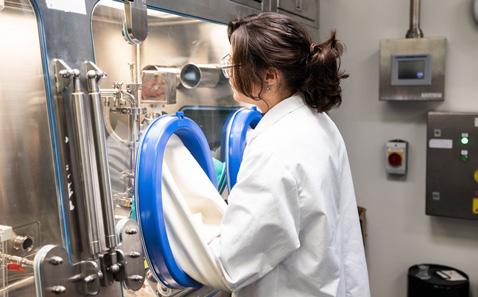

In this article, Carolina Dantas, MD, Manager of Medical and Scientific Affairs, and Ulf Krueger, Chief Executive Officer and Founder, both of Pulmotree Medical, consider the challenges when it comes to the successful delivery of inhaled biological drugs.
Biologics, administered via inhalation, offer the possibility of direct administration to the targeted site of activity. This route offers advantages such as direct drug delivery to specific lung regions, increased local concentrations, reduced systemic side effects and less-invasive treatments leading to improved patient adherence. As the pharmaceutical industry explores alternative routes for drug administration, the potential of nebulised biologics in treating respiratory and systemic diseases continues to garner attention, promising effective personalised treatments.
Generally, biologics are therapeutic proteins derived from living systems (such as bacteria, yeast, plants or animals) or blood that differ from “small molecules”, which are synthetic, or plant derived (see Figure 1). Examples of biologics include vaccines, growth factors, monoclonal antibodies and immune modulators. With their high target specificity and comparatively low toxicity, biologics are one of the fastest-growing therapeutic classes in the pharmaceutical industry.
Figure 1: Comparison of three different classes of biologic drugs with a typical small molecule. (Adaptation from Revers L & Furczon E, Canadian Pharmacists Journal, 2010.)
While traditionally administered via intravenous injection, advancements have sparked interest in exploring alternative routes, particularly inhalation, for the treatment of not only respiratory diseases but also systemic conditions.
In the context of respiratory diseases, biologics exert their therapeutic effects through different mechanisms of action, including modulation of immune responses, inhibition of inflammatory pathways and targeting specific cellular receptors involved in disease pathogenesis.
The growing interest in the inhaled route for biologics is related to:
• Direct drug delivery in the targeted lung region (e.g. locally in the lungs or systemic delivery)
• Increasing local drug concentrations with reduced doses
• Reduction of toxicities and side effects
• Non-invasive administration, leading to better patient adherence and convenience
• Reduction of costs and risks in clinical development.

Carolina Dantas
Manager of Medical and Scientific Affairs E: carolina.dantas@pulmotree.com

Ulf Krueger
Chief Executive Officer and Founder E: ulf.krueger@pulmotree.com
Pulmotree Medical GmbH
Steinheilstraße 3A
80333 Munich Germany
www.pulmotree.com
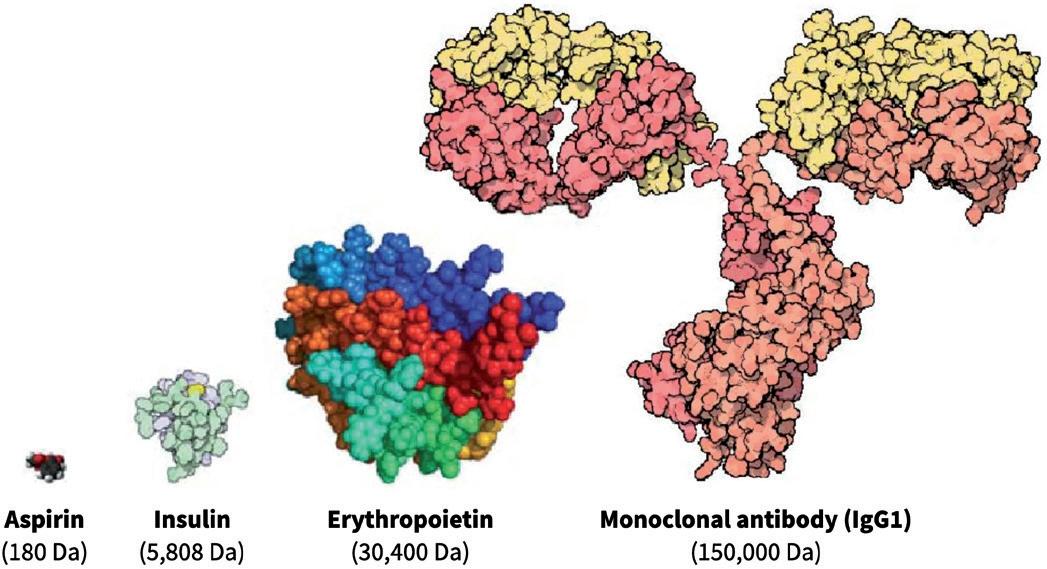
“The formulation of biologics for inhalation poses significant challenges due to their larger size, complex structure and unique properties.”
Despite these advantages, the formulation of biologics for inhalation poses significant challenges due to their larger size, complex structure and unique properties. Addressing these challenges requires thorough strategies because formulation modifications that target specific uptake routes increase mucus permeation, prevent degradation or improve resistance to aerosolisation. Froelich and Salar-Behzadi (2021) have highlighted several approaches to optimise formulations for the inhalation of biologics, emphasising the importance of tailored strategies to ensure therapeutic efficacy and safety.1
The successful delivery of inhaled biological drugs requires not only a specific formulation but also a device to generate aerosols. Due to the complex structure of biologics, the aerosolisation process needs to produce particles with aerodynamic properties suitable for inhalation and preserve the physical integrity and potency of the molecules at the same time.
Therefore, the selection of the appropriate device is critical as each device offers distinct advantages and disadvantages in terms of key performance parameters, which include precise and reproducible dosing, efficient delivery of high doses with minimal losses and a favourable lung deposition profile.
Given that approximately 75% of protein formulations intended for inhalation in clinical research are in liquid form,2 nebulisers – including jet, ultrasonic and vibrating mesh – are the most used devices for administering biologics to the lungs. This relates to their high efficiency, possibility of targeted lung deposition and compatibility with liquid formulations.1
For patients, nebulisers are generally suitable for all ages and disease stages, accommodating different inspiration flow rates and breathing capacities. However, the general process of nebulisation exposes
the proteins to physical stress, such as shear forces and heat. Additionally, the large air:liquid interface can alter protein conformation and structure, which is particularly relevant with jet and ultrasonic nebulisers.
By comparison, vibrating mesh nebulisers (VMNs) use a vibrating element connected to a mesh to generate aerosols in a single-pass process. This minimises the temperature increase and the shear stress that the molecule is subjected to, which is crucial for preserving the biological activity of macromolecules as biologics.3 Moreover, compared with other types of nebulisers, VMNs have increased nebulisation efficiency – higher drug delivery in less time – making them the preferred choice for the nebulisation of proteins.1
The inhalation of biologics is not a straightforward process as there are several challenges to overcome:
• The natural protective mechanisms of the lung
• The pharmaceutical properties of the formulation related to biologics delivery, such as protein stability, aggregation and the consequent potential for immunogenicity
• The interaction between the device and the drug, ultimately influencing its availability in the lungs.
Understanding and acknowledging these challenges is crucial for mitigating the risks associated with respiratory delivery of biologic drugs. The drug and the device should be optimised together to achieve a desirable aerosol performance and retain the molecular integrity of biologics.
Optimising lung delivery for biologics requires early strategies in preclinical development to tailor specific nebuliser features to refine device and formulation according to each target and indication. By effectively delivering drugs directly to the site of action within the lungs, aiming for either local or systemic delivery, higher intended drug concentrations are achieved, while reducing losses and exposure in non-desired areas. This is particularly relevant for biologics, which are usually expensive drugs. Using a nebuliser, targeted drug delivery can be achieved through the intentional adjustment of
influential parameters on lung deposition, including the breathing manoeuvre and the aerosol characteristics within the patient’s respiratory system. Existing devices, such as the Kolibri mesh nebuliser, use innovative inhalation feedback technology to guide the patient’s inspiratory manoeuvre and an aerosol generator tailored to each specific drug product. Ultimately, this approach requires selecting the right nebuliser for maximising therapeutic efficacy while minimising risks.
There have been significant advances in aerosol delivery technologies in the last two decades since the approval of two of the most relevant examples of inhaled biologics: inhaled insulin and dornase alfa.
The systemic delivery of biologics through the lungs is exemplified by inhaled insulin in dry powder. Despite being a global breakthrough in biotherapeutics, the first marketed inhaled insulins faced challenges due to issues with dosing, low device acceptability and portability, leading to low sales and their withdrawal soon after. These drawbacks diminished the market interest and since then only one other dry powder insulin was approved in 2014, with improved formulation technology, dosing flexibility and a much more portable device.
Dornase alfa, an inhaled recombinant human deoxyribonuclease I (rhDNase) for the management of cystic fibrosis, was initially approved only for jet nebuliser/air compressor combinations but later also for a VMN, considering the advantages related to higher efficiency, shorter treatment times and patient preference.
These lessons highlight the importance of technological advancements in formulation and device, as well as patient acceptance in inhaled biologic product success.
Currently, several inhaled biologic formulations for different respiratory and systemic disorders are advancing through
“Currently, several inhaled biologic formulations for different respiratory and systemic disorders are advancing through clinical development.”
clinical development. Liang et al (2020) provide a comprehensive table with a summary of the clinical trials with inhaled biologics and the chosen device.4 Most of the listed programmes are with nebulisers, and many clearly state the use of VMNs. The majority target respiratory diseases, such as chronic obstructive pulmonary disease, cystic fibrosis, respiratory viral infections and asthma, but also systemic disorders, such as diabetes and anaemia.
Future advancements for inhaled biologics hold promise for enhanced therapeutic outcomes. Research is currently focused on refining drug characteristics to improve the delivery of biologics, addressing challenges such as molecular stability, lung absorption and aerosol performance of biologics formulations. For an optimal aerosolisation
process, focus on the device is key. Nebulisers that allow customisation and adjustment to each specific biologic drug can represent a future advantage, as well as other important patient-centric features, including inhalation guidance technology and connectivity for user and clinical development support. These initiatives underscore the evolving panorama of nebulised biologics, paving the way for personalised and more effective treatments in the future.
Pulmotree Medical is a Munich, Germanybased life sciences company specialising in the development of drug delivery systems with targeted deposition of drugs into specific areas of the lung. Pumotree supports pharma partners with comprehensive services around the product lifecycle of drug and device combinations.
1. Froehlich E, Salar-Behzadi S, “Oral inhalation for delivery of proteins and peptides to the lungs”. Eur J Pharm Biopharm, 2021, Vol 163, pp 198–211.
2. Bodier-Montagutelli E et al, “Designing inhaled protein therapeutics for topical lung delivery: what are the next steps?”. Expert Opin Drug Deliv, 2018, Vol 15(8), pp 729–736.
3. Matthews AA, Ee PLR, Ge R, “Developing inhaled protein therapeutics for lung diseases”. Mol Biomed, 2020, Vol 1(1), p 11.
4. Liang W et al, “Pulmonary Delivery of Biological Drugs”. Pharmaceutics. 2020, Vol 12(11), p 1025.
Carolina Dantas (MD) brings her expertise as a pulmonologist to Pulmotree, providing the valuable insight of both physicians and patients. Specialising in respiratory infectious diseases and lung-related indications, such as cystic fibrosis and bronchiectasis, she has vast hands-on clinical experience with inhaled drug therapies. As Manager of Medical and Scientific Affairs, her search for innovation in healthcare matches Pulmotree’s forward-thinking approach to the evolution of respiratory therapies. Besides her knowledge in clinical research, Dr Dantas is an accomplished communicator in science, with several published scientific papers, a book chapter and several original presentations at international conferences. Dr Dantas holds a master’s degree in Medicine, and is a member of the Sociedade Portuguesa de Pneumologia, the European Respiratory Society (ERS) and the International Society for Aerosols in Medicine.
Ulf Krueger’s deep knowledge in respiratory drug delivery combined with his strong management skills and innovative entrepreneurial vision are the foundation of Pulmotree. His comprehensive experience involves key areas across the nebuliser industry lifecycle, from R&D, through corporate strategy to successful commercialisation. In his former position as Director - Fox Nebuliser Programs at Vectura, he was responsible for the entire sector of mesh nebulisers. Previously, he held various positions in the R&D department of PARI. He is a graduate biomedical engineer and a certified senior project manager (IPMA® Level B) and is a member of The Aerosol Society, the European Respiratory Society and the International Society for Aerosols in Medicine.

* using Forest Stewardship Council® certified recycled paper, vegetable-based inks, biodegradable laminates and carbon balanced materials offset via the World Land Trust™ following ISO140001 processes.
** by DHL using GoGreen Plus carbon insetting of at least 30% through the use of Sustainable Aviation Fuel (SAF), a biofuel substitute for traditional jet fuel, produced from renewable sources. Mailed to individual readers around the world by DHL using GoGreen, which offsets 100% of CO2 emissions.



In this article, Gesa Bräunlich, Portfolio Manager eFlow, and Michael Hahn, Vice-President eFlow Partnering & Strategy, both at PARI Pharma, discuss the company’s new eFlow integrated nebuliser.
With so many different nebulisers on the market – and with numerous highly advanced technological features to consider and even more devices appearing on the horizon – how do you make the right decision to meet the different needs of all stakeholders?
It is important to get this decision right. And yet, for pharmaceutical and biotech companies looking for a suitable delivery solution for an innovative drug formulation, the decision-making process has never been more complex. As Jones & Veasey (2023) have reminded us, “The benefits of getting it right can be enormous, and the consequences of getting it wrong can be dire.”1
It is a difficult balancing act. We value proven and reliable technology to help reduce the risks of clinical development. But we must also look to new technologies
“We must look to new technologies to help improve clinical performance, tackle existing limitations, enhance the user experience and ensure future-proof capability.”
to help improve clinical performance, tackle existing limitations, enhance the user experience and ensure future-proof capability, even after many years of clinical development.
When it comes to next-generation delivery solutions, PARI believes it is best to focus on three fundamental elements:
• Optimise the efficiency of drug delivery because many drug formulations are extremely costly
• Enhance usability to help improve the overall patient experience and contribute to enhanced adherence
• Develop smartphone apps to complement smart devices – as in many other industries, this has considerable potential to support patients and inhalation therapies in multiple ways while generating helpful data-based insights.
Typically, for nebulisers, the higher the volume to reach the lung and the lower the delivered dose, the longer the nebulisation time. The laws of physics cannot be changed. But, to ensure efficiency of nebuliser devices, three separate but interacting parameters can be optimised:
• Delivered dose
• Nebulisation time
• Breathing pattern.

Gesa Bräunlich Portfolio Manager eFlow E: gesa.braeunlich@pari.com

Michael Hahn Vice-President eFlow Partnering & Strategy E: michael.hahn@pari.com
PARI Pharma GmbH Moosstr 3 82319 Starnberg Germany
www.pari.com
A common approach to increase the delivered dose is to add a breath-trigger function. Breath-triggered nebulisers have been available for around 25 years.2 These types of nebulisers produce aerosols only during – in fact, as part of – the inspiration phase of the breathing cycle. This results in minimised aerosol losses, specifically during the exhalation phase and, therefore, makes efficient use of medication in the nebuliser by delivering high amounts of drug to the patient.3
Cost of goods for innovative drug products, such as antibodies, peptides and nucleotides in the form of antisense oligonucleotides, siRNA or mRNA, can be high. The efficient use of such precious drug products is therefore essential. A further consideration is that toxicology assessments are typically carried out based on the nominal filled dose.4,5 So, in situations where the amount of drug delivered to the patient is not efficacious and the filled dose cannot be increased due to toxicity concerns, a nebuliser with a higher delivered dose may result in an effective dose while not exceeding the maximum allowable clinical dose.
To maximise the delivered dose, PARI has developed a new breath-triggered nebuliser platform based on the proven eFlow technology with its actively vibrating laser-drilled membrane. The applied trigger algorithm enables delivered dose rates of up to 95%.
Due to the nature of breath-triggered devices, aerosol is only produced during part of the breathing cycle, resulting in relatively long treatment times. In particular, for patients who suffer from chronic conditions, long treatment times increase the burden and need to be reduced to improve the acceptability of therapy.6 An optimal nebuliser delivers drug product with high efficiency –i.e. integrates a high delivered dose and a short nebulisation time.
Achieving short nebulisation times with breath-triggered nebulisers is a universal challenge for which PARI has discovered a solution by taking two approaches:
1. Since aerosol is only produced during inhalation, it is necessary to make best use of this short period of time and
deliver as much aerosol as possible. This can be achieved by increasing the output rate. Significant improvements made by PARI in the laser drilling process allow aerosol output rates in the range of 1 to 2 mL/min (measured under constant flow conditions – i.e. without a breath trigger) while the particle size of the aerosol remains substantially below 5 µm.
2. Short nebulisation times are achieved through an optimised breathing pattern involving a prolonged inhalation time in which more aerosol can be delivered during each breath. Longer inhalation durations –increasing the inspiration:expiration (I:E) ratio – can be achieved by an inspiratory flow resistance that encourages the patient to breathe more slowly.
Finally, it is important to take into account that the breathing pattern also has a profound impact on aerosol distribution and deposition in the lungs, which, in turn, fundamentally influences drug effectiveness and patient outcomes.7,8
For high peripheral lung deposition and short nebulisation times, patients should be guided towards a slow deep inhalation with low flow rates. In contrast, high inspiratory flow rates lead to more turbulence in the central airways, which leads to unintended drug deposition in the upper airways.9,10 Importantly, this can be limited by increasing inspiratory resistance.11
There are two main considerations for defining the right inspiratory resistance. While high resistance will successfully decrease inspiratory flow, it might simultaneously have a negative influence on therapy acceptance and adherence due to
“It is a balancing act to find the ideal compromise between optimal reduction of inspiratory flow and a convenient breathing mode which is tolerable for the patient.”
possible to allow for passive exhalation. It is a balancing act to find the ideal compromise between optimal reduction of inspiratory flow and a convenient breathing mode that is tolerable for the patient.
With the development of the new eFlow Integrated nebuliser, PARI has implemented an innovative breath-guiding approach and a novel nebuliser platform that supports and guides the patient to inhale slowly and deeply. Three factors have been successfully combined to optimise the breathing pattern accordingly (Figure 1):
• Built-in resistance
• Visual and haptic feedback
• App-based breath-guiding.
First, and most importantly, a unique built-in flow resistance limits the peak inspiratory flow. While flow resistance is higher during inhalation to limit flow rates, it is reduced during exhalation to allow optimal work of breathing and tolerability. This is the result of the specific geometry of an innovative built-in resistance termed fluidic diode. The overall aim is to limit patients’ inspiratory flow, as this helps increase lung deposition and reduce nebulisation time.


visualisation of inhalation. This can guide the user to inhale slowly and deeply, which, in turn, can increase the I:E ratio and lead to shorter nebulisation times. Such feedback also informs the patient that the inhalation manoeuvre has been performed correctly (Figure 3).
A more detailed inhalation report is given within the app at the end of each therapy to inform patients about their inhalation technique and therefore strengthen their engagement and self-management. This can support patients in their effective inhalation to promote the best possible therapy outcomes. With this new digital feature, PARI sends feedback to guide the patient to an optimal breathing pattern.
The second element to guide patients’ breathing patterns is the user interface on the device. By providing intuitive instructions directly via an illuminated mouthpiece assembly and a vibrating controller, PARI’s new eFlow integrated nebuliser platform effectively trains the patient on the correct breathing pattern during inhalation. A pressure sensor collects real-time data from the inspiratory flow, translating this information into haptic and visual signals that inform the user on whether or not the inhalation is optimal (Figure 2).
Feedback is simultaneously visualised within the new PARI Breath Guide app, which, as an optional feature, is connected to the eFlow Integrated nebuliser via Bluetooth. The visualised breathguiding feature trains a slow, controlled inspiration. The app uses transferred data to provide real-time feedback and a helpful
“With this new digital feature, PARI sends feedback to guide the patient to an optimal breathing pattern.”
The development of a new nebuliser is highly dependent on patient understanding and patient acceptance. As a result, from the very beginning of development, human factors studies have played a significant role in shaping the entire product concept and continuously improving various device features and the user interface. The learnings from this design process resulted in a user-friendly nebuliser, which includes an integrated controller and which considers the specific characteristics of target users with the ergonomic nebuliser design, the conical grip for different

hand dimensions and the secure stand for easy filling of the reservoir. Specific user characteristics were also considered when implementing the user interface of the breath-guiding features (Figure 4).
The eFlow integrated nebuliser

“The novel nebuliser platform optimises drug delivery with an innovative breathguiding approach.”
registrations of drug-device combination products and shorten lead times for partner-specific configurations.
The novel nebuliser platform optimises drug delivery with an innovative breathguiding approach. With its patient-centric approach, PARI has made significant advances in optimising the device platform and the entire patient experience to drive adherence and improve performance and clinical use – factors that can translate into clinical success. Beyond this innovative product design, the well-established eFlow aerosol generator, which is a core component, is produced on proven commercial-scale production equipment in two independent manufacturing sites. With the new eFlow Integrated nebuliser, PARI has achieved a high level of integration – the successful blend of:
1. High delivered doses achieved in short nebulisation times
2. An ergonomic and intuitive nebuliser design combined with a useful smartphone app 3. Innovation based on the proven eFlow technology.
The new eFlow Integrated nebuliser is still under final development, while it has already confirmed expectations during the first in vitro studies with innovative drug products.
Martin Guppy, PhD, participated in the writing and proofreading of the manuscript.
PARI is a world leader in the development of aerosol delivery devices. PARI Pharma focuses on pharma licensing partnerships and offers under one roof a complete device and service portfolio comprising customisable nebulisers based on eFlow Technology, development and analytical know-how, as well as extensive manufacturing and supply chain capabilities. eFlow Technology is a vibrating membrane nebuliser platform that provides optimised aerosol performance for a wide range of drug formulations and is available with short lead times. eFlow Technology devices are designed to reduce the burden of treatment for patients with severe respiratory diseases. As of today, five commercial drug-specific eFlow Technology nebulisers are available in North America, Europe and Japan.
1. Jones M, Veasey R, “Due diligence – the key to success in drug delivery device selection”. ONdrugDelivery, Issue 145 (Apr 2023), pp 20–24.
2. Denyer J, Dyche T, “The Adaptive Aerosol Delivery (AAD) technology: Past, present, and future”. J Aerosol Med Pulm Drug Deliv, 2010, Vol 23(Suppl 1), pp S1–10.
3. Hardaker LE, Hatley RH, “In vitro characterization of the I-neb Adaptive Aerosol Delivery (AAD) system”. J Aerosol Med Pulm Drug Deliv, 2010, Vol 23(Suppl 1), pp S11–20.
4. Forbes B et al, “Challenges in inhaled product development and
opportunities for open innovation”. Adv Drug Deliv Rev, 2011, Vol 63(1–2), pp 69–87.
5. Tepper JS et al, “Breathe In, Breathe Out, Its Easy: What You Need to Know About Developing Inhaled Drugs”. Int J Toxicol, 2016, Vol 35(4), pp 376–392.
6. Dobler CC et al, “Treatment burden should be included in clinical practice guidelines”. BMJ, 2018, Vol 363, p k4065.
7. Nikander K et al, “Mode of breathing-tidal or slow and deepthrough the I-neb Adaptive Aerosol Delivery (AAD) system affects lung deposition of (99m)Tc-DTPA”. J Aerosol Med Pulm Drug Deliv, 2010, Vol 23(1), pp S37–43.
8. Van Velzen AJ et al, “The influence of breathing mode on tobramycin serum levels using the I-neb AAD system in adults with cystic fibrosis.”. J Cyst Fibros, 2015, Vol 14(6), pp 748–754.
9. Dolovich MA, “Influence of inspiratory flow rate, particle size, and airway caliber on aerosolized drug delivery to the lung”. Respir Care, 2000, Vol 45(6), pp 597–608.
10. Laube BL et al, “Targeting aerosol deposition in patients with cystic fibrosis: effects of alterations in particle size and inspiratory flow rate”. Chest, 2000, Vol 118(4), pp 1069–1076.
11. De Boer A et al, “Inhalation characteristics and their effects on in vitro drug delivery from dry powder inhalers Part 1. Inhalation characteristics, work of breathing and volunteers’ preference in dependence of the inhaler resistance”. Int J Pharmaceut, 1995, Vol 130(2), pp 231–244.
Gesa Bräunlich joined PARI in 2022 and is responsible for the strategic management of the eFlow Technology portfolio and the product management of new developments within the eFlow Technology platform. She previously held various positions as Product and Portfolio Manager within the healthcare industry, focusing primarily on the development and commercialisation of medical devices. Mrs Bräunlich earned a master’s degree in Business Administration from the University of Bamberg (Germany).
Michael Hahn heads up a team of business development, project, contract and portfolio managers, responsible for building and maintaining long-lasting relationships with PARI’s pharma partners. Mr Hahn joined PARI in 2006 and held different positions in research and development, and business development, with increasing responsibility. He earned a master’s degree in Electrical Engineering and an MBA, both from Technical University of Munich (Germany).
In this article, Ethan Miller, PhD, Senior Biophysicist, and Heather Jameson, PhD, Senior Engineer, both at Springboard, shed light on some of the intricacies that lipid-encapsulated therapeutics bring to the realm of inhalation therapies, and some considerations on how the type of inhalation device selected may help to mitigate issues around formulation stability and efficient delivery to target cells.
In the post-covid-19 era we have witnessed a notable shift in vaccine development with the advent of lipid nanoparticle (LNP) vaccines, representing a groundbreaking approach to immunisation, opening new avenues for developing vaccines against various pathogens and reshaping the future of preventive medicine. LNPs offer a means of “bubble-wrapping” therapeutic cargo, protecting it from degradation and facilitating its internalisation into cells. Additionally, RNA-carrying LNPs provide a unique opportunity to treat respiratory diseases resulting from inherited anomalies, using techniques such as gene editing, silencing or replacement therapies to treat the root cause of the diseases.1
The systemic delivery of LNP therapies via intravenous (IV) injection has significant challenges for pulmonary disorders; the first being the coating of LNPs with apolipoprotein E (ApoE) protein in blood plasma. This ApoE coating causes LNPs to be preferentially delivered to the liver rather than desired pulmonary tissues. Such challenges in IV injection of pulmonary therapies make inhalation a promising avenue for LNP delivery.
However, the delivery of lipidencapsulated therapies via inhalation is not without its own challenges, with mucus2 and lung surfactant1 impacting the efficacy of LNP therapeutic delivery to target cells. Further challenges are presented by the mechanical or thermal stresses exerted on LNPs during the aerosolisation or drying processes. This article will explore some of the recent developments that are aiming to overcome these challenges, and unlock the potential of inhaled LNP therapeutics.
NANO CARGO SHIPS:
LNPs are tiny particles typically ranging from 10 to 200 nanometres in diameter. These nanoparticles can be designed to target specific tissues or cells, release their cargo in response to specific triggers (such as pH or enzymes), and improve the bioavailability and efficacy of therapeutic compounds.
LNPs can be used to encapsulate therapeutic compounds, such as drugs or genetic material (like RNA or DNA). The LNP provides a protective shell for nucleic acids and other therapeutic cargos,

Dr Ethan Miller
Senior Biophysicist
T: +44 1223 856463
E: ethan.miller@springboard.pro

Heather Jameson
Senior Engineer
T: +44 1223 607467
E: heather.jameson@springboard.pro
Springboard Pro Ltd,
a Sanner Group Company
St John’s Innovation Centre Cowley Road
Cambridge CB4 0WS
United Kingdom
its constituent components. Based on illustrations from Albertsen (2022).3
www.springboard.pro
Figure 2: Methods for nebulisation. (A) Vibrating mesh nebuliser; a flexible mesh mounted on an actuator that stretches and vibrates to aerosolise the contained liquid. (B) Imping jet nebuliser: two jets collide at a high velocity, breaking up into small droplets. (C) Rayleigh break-up: fluid is pushed through a thin nanopore membrane at low pressure, creating multiple jets that subsequently break up in equally sized droplets. Based on illustrations from van Rijn et al (2023).6
as illustrated in Figure 1, preventing enzymatic degradation until the cargo is successfully delivered to the target cells.3 The successful delivery of the nucleic acid cargo into the target cell is known as “transfection”.
A wide variety of therapeutics can be delivered via LNP encapsulation, including small molecule drugs, nucleic acids (such as DNA, RNA, siRNA), vaccines, proteins, peptides, imaging agents and gene editing tools. The approach has applications not only for drug delivery and gene therapy but also in diagnostics and imaging. LNP encapsulation can enable the development of more effective and targeted therapies for various diseases and conditions, offering potential improvements in efficacy, safety and patient outcomes.
SHEAR BRILLIANCE:
MITIGATING THE IMPACT OF SHEAR STRESS ON LNPS
Nebulisers and soft-mist inhalers aerosolise liquid formulations, generating a fine mist that the patient inhales to achieve direct delivery of therapeutics to the respiratory tract. The aerosolisation process may subject the LNPs to high shear forces, especially during nebulisation or when passing through narrow orifices. These forces can cause structural alterations or complete rupture of the lipid bilayer, leading to the premature release of encapsulated agents and, consequently, a significant loss of efficacy.4
“To mitigate the impact of shear forces on LNP rupture and loss of efficacy, extensive research is underway into shear-reducing aerosolisation techniques.”
Nebulisation Mechanisms
To mitigate the impact of shear forces on LNP rupture and loss of efficacy, extensive research is underway into shear-reducing aerosolisation techniques. Vibrating mesh nebulisers (Figure 2A) appear to be a more suitable method of gene therapy delivery compared with jet and ultrasonic nebulisers.4 Conventional jet nebuliser designs (Figure 2B) often require a baffle in the aerosolisation mechanism, creating large shear forces in the aerosolised product as it exits the nozzle. Instead, vibrating mesh nebulisers use a microscopic mesh vibrating at ultrasonic frequencies to create a fine mist from liquid medications. The absence of baffles within the vibrating mesh nebulisers reduces shear stress and damage to the LNPs and their cargo.5 Future vibrating mesh nebuliser technologies will likely incorporate bespoke mesh technologies tailored for specific drugs and therapies, optimising drug delivery for the particular formulation of LNP encapsulated therapy.
In addition to the established nebuliser aerosolisation mechanisms, two further mechanisms have been employed in softmist inhalers: impinging jets (Spiriva
Respimat (Boehringer Ingelheim, Ingelheim am Rhein, Germany)) and Rayleigh break-up (Medspray (Enschede, the Netherlands)). A study comparing three nebulisation techniques, including vibrating mesh, impinging jets (Figure 2B) and a novel design employing Rayleigh break-up (Figure 2C), found that reducing the energy level required to aerosolise the formula is critical to safeguarding the integrity of the LNP and cargo.6 The Rayleigh breakup mechanism requires much lower energy input to aerosolise the formula (2 J/g verses >20 J/g for other mechanisms), and hence was found to be the most successful. However, the nanoscale pores required may present manufacturing and maintenance challenges.
The optimisation of lipid composition for increased resilience and developing novel formulations with inherent protective properties against mechanical stress is also a strategy under investigation. A recent study showed optimising LNP composition could improve mRNA transfection after aerosolisation via a mesh nebuliser, by switching the ionisable lipid for a more
saturated variant. This resulted in the aerosolised LNP being more effective at transfecting gene therapies to lung tissues in mouse models.7
The promising developments in nebulisation technology and optimisation of lipid composition suggest that the challenges associated with the mechanical stresses of nebulisation are not insurmountable. Hence, we should expect that liquid formulations and their associated inhaler devices will remain relevant in the future development of inhaled LNP drugs.8
In addition to the challenge of shear forces, formulation in a liquid state increases the tendency of premature protein drug degradation during storage. The alternative to liquid nebulisation is to first formulate as a dry powder and deliver using a dry powder inhaler (DPI). DPIs have the benefit of convenience compared with nebulisers, being generally smaller and more portable, as well as cheaper. Compared with pressurised metered dose inhalers, they do not require propellant, which would need to be compatible with the drug.
Spray-drying is a common method employed for producing therapeutics as powders. The lipid solution containing the API is atomised into fine droplets using a nozzle. These droplets are dried rapidly in a heated chamber, resulting in the formation of solid LNPs encapsulating the drug, suitable for pulmonary delivery through DPIs.
Spray-dried LNP formulations have been shown to be able to achieve low residual moisture levels (below 0.5%).
“Studies have shown that the optimisation of the excipient, the inactive vehicle of the LNP with the dry powder formulation, can significantly improve formulation characteristics.”
“Advances
in nanotechnology, such as the development of functionalised nanoparticles for targeted drug delivery and imaging, hold promise for synergistic approaches to disease diagnosis and treatment.”
When inhaled, the dry powders form particles sized between 1 and 5 µm, which are ideal for deep inhalation into the lung and deposition in the alveolar region. Importantly, recent studies have shown that spray-dried LNPs retain their capability for transfection and can be used to deliver gene therapies.9 Advanced drying techniques are also being developed, with one study preparing siRNA-encapsulated solid LNPS by thin-film freeze-drying showing promising results.10
Studies have shown that the optimisation of the excipient, the inactive vehicle of the LNP with the dry powder formulation, can significantly improve formulation characteristics. The combination of both mannitol and leucine has been found to create much smoother and spherical LNPs when observed through a scanning electron microscope, and the addition of ethanol in the inlet feed aided in reducing the particle size of the dry powder product.11
Historically, the choice of excipients approved for inhalation has been limited, with lactose and magnesium stearate being, by far, the most widely used compounds in inhaled drug products.12 Diversification of approved excipient compounds will aid the future development of stable inhaled LNP therapeutics.8
PUFFING PROGRESS:
FUTURE CONSIDERATIONS FOR LNP IN INHALATION DEVICES
LNP therapeutics and inhalers are poised to drive innovation in pulmonary drug delivery, enhancing efficacy, safety and the patient experience. As highlighted in this article, one method of advancement lies in the refinement of LNP formulations to optimise their physicochemical properties for targeted lung delivery. This involves tailoring lipid composition, surface modifications and encapsulation strategies to improve stability, bioavailability and cellular uptake within the lungs.
In parallel, advances in nanotechnology, such as the development of functionalised nanoparticles for targeted drug delivery and imaging, hold promise for synergistic approaches to disease diagnosis and treatment. By combining LNP-based therapeutics with imaging agents or nanoparticles, clinicians can gain insights into disease progression, monitor treatment response and tailor therapy for optimal outcomes.
The integration of innovative technologies in the inhalation devices is also promising, for example, the incorporation of microfluidics architectures. A recent study demonstrated a microfluidic system for producing aerosolised nanoparticles for inhaled mRNA therapy.13 The particles were generated by individual microfluidic nozzles for precise droplet ejection, allowing for the low shear generation of droplets with minimal LNP disruption, aggregation or cargo leakage.
Overall, the future of LNP therapeutics and inhalers lies in multidisciplinary collaboration, technological innovation and a patient-centric approach to respiratory care. By harnessing the potential of LNPs and inhalation devices, researchers and clinicians can revolutionise the management of lung diseases, improving quality of life and clinical outcomes for patients worldwide.
Springboard is an engineering consultancy that specialises in developing devices from concept to manufacture for regulated markets. The company is an expert in creating innovative yet robust designs and solving difficult technical problems quickly. As part of the Sanner Group, Springboard also has access to expertise in design for manufacture and mass manufacturing capabilities to help scale up from prototyping to full-scale production.
1. Kassab G et al, “Inhalable Gene Therapy and the Lung Surfactant
Problem”. Nanoletters, 202, Vol 22, pp 10099–10102.
2. Kim J et al, “Engineering Lipid Nanoparticles for Enhanced Intracellular Delivery of mRNA through Inhalation”. ACS Nano, 2022, Vol 16(9), pp 14792–14806.
3. Albertsen CH et al, “The role of lipid components in lipid nanoparticles for vaccines and gene therapy”.
Adv Drug Deliv Rev, 2022, Vol 188, p 114416.
4. Arulmuthu E et al, “Studies on Aerosol Delivery of Plasmid DNA Using a Mesh Nebulizer”. Biotechnol Bioeng, 2007, Vol 98(5), pp 939–955.
5. McCarthy S, González H, Higgins B, “Future Trends in Nebulized Therapies for Pulmonary Disease”.
J Pers Med, 2020, Vol 10(2), p 37.
6. Van Rijn CJM et al, “Low energy nebulization preserves integrity of SARS-CoV-2 mRNA vaccines for respiratory delivery”. Sci Rep, 2023, Vol 13(1), p 8851.
7. Lewis M et al, “Optimization of ionizable lipids for aerosolizable mRNA lipid nanoparticles”. Bioeng Transl Med, 2023, Vol 8(6), p e10580.
8. Leong EWX, Ge R, “Lipid Nanoparticles as Delivery Vehicles for Inhaled Therapeutics”. Biomedicines, 2022, Vol 10(9), p 2179.
9. Zimmermann CM et al, “Spray drying siRNA-lipid nanoparticles for dry powder pulmonary delivery”.
J Control Release, 2022, Vol 351, pp 137–150.
10. Wang J-L et al, “Aerosolizable siRNA-encapsulated solid lipid nanoparticles prepared by thin-film freeze-drying for potential pulmonary delivery”.
Int J Pharm, 2021, Vol 596, p 120215.
11. Sarode A et al, “Inhalable dry powder product (DPP) of mRNA lipid nanoparticles (LNPs) for pulmonary delivery”.
Drug Deliv Transl Res, 2024, Vol 14(2), pp 360–372.
12. “Accelerating excipient development for inhalable dosage forms with QbD”. Manufacturing Chemist, May 8, 2021.
13. Kim J et al, “Microfluidic platform enables shear-less aerosolization of lipid nanoparticles for messenger RNA inhalation”. 2024, bioRxiv Preprint.
Ethan Miller, PhD, is an experimental biophysicist with a background in developing synthetic biological systems and high-resolution imaging. His previous academic work focused on the influence of support substrates on lipid membrane behaviour. He can quickly grasp new concepts and break down complicated problems, allowing him to discover innovative solutions. His experience includes medical device development, manipulation of synthetic bio-membranes with microfluidics, and nanoscale surface characterisation.
Heather Jameson, PhD, is a Senior Engineer at Springboard, taking a leading role in planning and executing both design and test projects and has worked on the design and development of several drug delivery devices. She read Engineering at the University of Cambridge (UK), before completing a PhD in Fluid Mechanics at the Whittle Laboratory. She continues to play an active part in university relations in addition to her public speaking engagements on STEM and outreach.
SMI.London 2024 will carry on the conversation on soft mist inhalers started in 2023, register your interest today. info@smi.london
Here, Zaid Aqrawe, PhD, Business Development Manager, Philippe Rogueda, PhD, Co-Founder and Chief Business Officer, both at Merxin Ltd, Darragh Murnane, PhD, Professor of Pharmaceutics at the University of Hertfordshire, and Bryan Eng, Doctoral Candidate in Pharmaceutical Sciences at the University of Maryland School of Pharmacy, discuss the opportunity presented by soft mist inhalers as an alternative delivery device to nebulisers for inhaled therapies, contrasting the two device categories across multiple factors.
In exploring the landscape of respiratory drug delivery, the comparison between nebulisers and soft mist inhalers (SMIs) emerges as a subject of keen interest. These devices (Figure 1), pivotal in managing various respiratory conditions, have evolved to meet the diverse needs of patients.1 SMIs, in particular, represent a significant advancement, offering unique benefits over traditional nebulisation therapy. In considering their operational mechanisms, usage and efficacy, it becomes clear that SMIs offer clear advantages in various aspects of pulmonary drug delivery. At the heart of this analysis is the principle of delivery equivalence and the ability to deliver biologics – the therapies of the future – juxtaposed with patient-centric considerations, such as ease of use, environmental impact and cost-effectiveness. While both SMIs and nebulisers aerosolise medication for inhalation, SMIs excel by providing precise, unit-dose delivery with superior lung deposition.2–4 This article delves into the scientific and practical advantages of SMIs,
demonstrating their potential to enhance treatment outcomes, patient adherence and overall quality of life for individuals with respiratory conditions.
SMIs and nebulisers both aerosolise liquid formulations, with the key difference being that dose delivery for an SMI occurs within seconds, as opposed to minutes for a nebuliser. Taken in tandem with the superior ability of SMIs to achieve deep lung deposition and aerosolise medications with a high fine particle fraction (FPF) (Table 1), it is reasonable to conclude that, if a drug can be formulated as a solution
Dr Zaid Aqrawe
Business Development Manager
T: +44 1553 403070
E: zaid@merxin.com
Dr Philippe Rogueda
Co-Founder & Chief Business Officer
T: +44 1553 403070
E: philippe@merxin.com
Merxin Ltd
1 Innovation Drive
King’s Lynn Norfolk
PE30 5BY
United Kingdom www.merxin.com
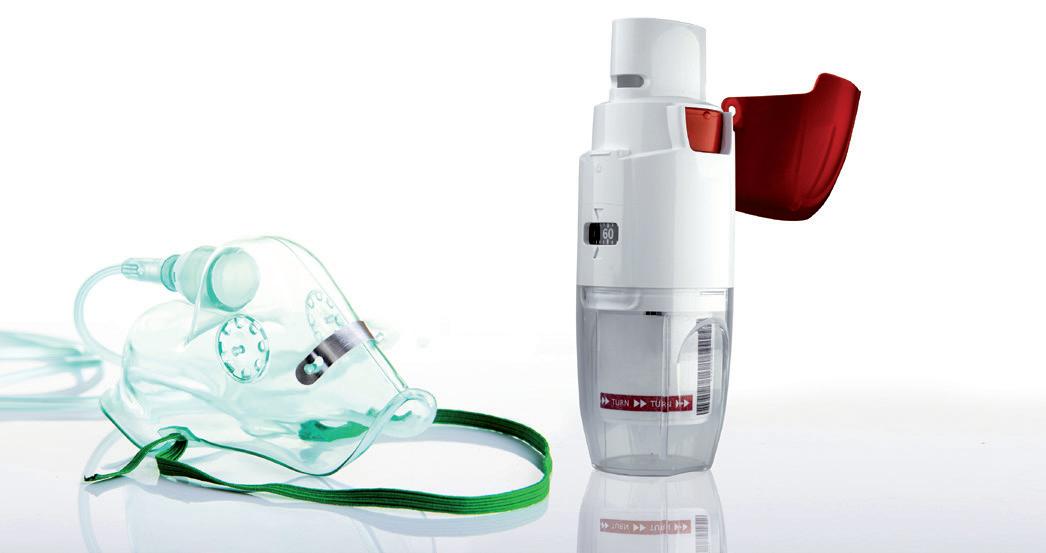
Professor Darragh Murnane Professor of Pharmaceutics
Department of Clinical, Pharmaceutical and Biological Sciences
School of Life and Medical Sciences
University of Hertfordshire College Lane
Hatfield
United Kingdom
Bryan Eng
Doctoral Candidate in Pharmaceutical Sciences
University of Maryland
School of Pharmacy
20 North Pine Street
S345, 3rd Floor
Baltimore MD 21201
United States
“In the world of biologics, prime candidates for making the transition from nebulisers to delivery with an include mRNA, vaccines, oligonucleotides and other therapeutic proteins, some in LNP formulations.”
for a nebuliser, it is highly likely that that same drug can be formulated for and delivered by an SMI. Going beyond this, SMIs have the added capability to deliver drugs solubilised in ethanolic solutions or other solubilising media, widening the scope of delivery to molecules that are insoluble in aqueous media.
An example of the nebuliser to SMI transition is the successful and equivalent
aerosolisation of salbutamol nebules with an SMI (MRX004), for which a single breath FPF<5µm of 63.2 ± 2.1% was achieved.9
In the world of biologics, prime candidates for making the transition from nebulisers to delivery with an SMI include messenger ribonucleic acid (mRNA), vaccines, oligonucleotides and other therapeutic vaccines, some in lipid nanoparticle (LNP) formulations. One example of this potential is dornase alfa.
Delivery of Dornase Alfa via an SMI Dornase alfa is a cystic fibrosis medication delivered via nebuliser and is a clear candidate for delivery via SMI. A study conducted by Merxin Ltd and Intertek (Melbourn, UK)10 found that an aqueous solution of dornase alfa, delivered via MRX004, demonstrated a high FPF and only minimal loss of enzymatic activity (Figure 2). Data from tests using a nextgeneration impactor showed an FPF (<5 µm) of 59.4%. The study concluded
that an SMI was capable of successfully and efficiently delivering dornase alfa, with a retention of 90% of the enzymatic activity compared with the nebule.
Aerosolising mRNA & Nanoparticle Formulations
A study conducted by Miao H et al (2023) examined the ability of SMIs and nebulisers to deliver an mRNA-LNP vaccine formulation, and concluded that the SMI compared favourably with the nebuliser technologies in a number of ways.4 The SMI provided a softer method of aerosolisation than nebulisation, with the structure of the LNPs remaining unchanged after delivery with an SMI from jet, vibrating mesh and ultrasonic nebulisers. Laser diffraction of the emitted aerosol showed that the SMI was able to generate a finer aerosol than was seen with a vibrating mesh nebuliser, and so was more suitable for lung delivery. Furthermore, the LNP structures tended to be deconstructed and reassembled by vibrating mesh nebulisation leading to poorer mRNA encapsulation than when aerosolised using an SMI.
Other advantages of aerosolisation using an SMI rather than a nebuliser included a superior entrapment efficiency for the SMI aerosol and greater biological activity of the mRNA after delivery with the SMI. The biological activity was examined by both ex vivo and in vivo fluorescence imaging, which suggested that SMI administration resulted in an mRNA concentration approximately four times greater than administration with a vibrating mesh nebuliser.
In practice, SMIs have proven popular with a wide range of patients, citing increased ease of use and convenience when compared with nebulisers. Three key factors that contribute to this preference are the portability of SMIs, which are of a comparable size to MDIs and DPIs; relative speed and simplicity of operation, requiring four straightforward steps – “open, twist, press/inhale, dose” – with the dose delivered in 10 seconds,1 whereas nebulisers require 14 steps;11 and their significantly lower maintenance requirements, needing only simple and infrequent cleaning, such as washing the mouthpiece once a week, while nebulisers have relatively intensive cleaning requirements, need extensive assembly (chamber, tubing, mask, nasal clip, etc), require parts to be changed out and need the patient or carer to fill the formulation chamber for each use session.
However, it is important to remember that SMIs are not a simple one-size-fits-all replacement for nebulisers – specific patient demographics will still find nebulisers preferable based on their needs. Nebulisers remain the preferred option for paediatrics and geriatrics, where their ability to deliver high doses over an extended period of time, combined with a lack of need to
“SMIs are cheaper than nebulisers on a per-device basis and, as they are purely mechanical as opposed to electronic, have a lower operating cost.”
co-ordinate inhalation with activating the device, better suits their needs. On the other hand, more active patients who are regularly mobile, especially outside the home, will find the portability and speed of delivery offered by SMIs is much better suited to their lifestyle. Additionally, the superior deep-lung penetration of SMIs may suit patients who require consistent and effective management of chronic respiratory conditions.
A key deciding factor as to whether a patient demographic is better suited to an SMI or a nebuliser is whether they can master the necessary co-ordination between breath and device activation. Studies suggest, however, that this may not be an onerous ask with proper training and facilitation. For example, it has been shown that children under five years old can use SMIs with near 100% accuracy if a valve holding chamber is employed.12,13
Environmental impact is an increasingly prominent factor in the minds of patients,
payers and regulators when considering drug delivery devices. In order to combat climate change, societies worldwide are looking to reduce the carbon footprint of current technologies or replace those currently in use with less environmentally damaging alternatives. Here, SMIs stand out as a favourable alternative to both MDIs and nebulisers, as they require neither propellant nor electricity.
Comparing the carbon footprints of SMIs and nebulisers, SMIs have a noticeable advantage over nebulisers (Table 2). Therefore, drug developers looking to meet their net zero targets would be wise to consider formulating their respiratory medicines as an SMI.
Cost of ownership is always going to be a key consideration for any drug delivery device. If a medication is overly expensive for a patient, it is possible that there will be a negative effect on adherence, lowering the efficacy of the treatment overall. In a survey conducted by Asthma + Lung UK, patients reported that using their nebuliser during an energy crisis was a point of anxiety.16 SMIs are cheaper than nebulisers on a per-device basis and, as they are purely mechanical as opposed to electronic, have a lower operating cost (Table 3). Furthermore, SMIs may provide a cost saving at the healthcare provider level, due to the lower amount of training required to familiarise a patient with their device.
In current respiratory drug development, nebulisers are the standard during preclinical animal studies,21 due to the control over the dosage and properties of the aerosol. Many development programmes then continue to use a nebuliser as they progress to clinical trials, even if it is not the ideal device for human use nor the anticipated final form of the product, postponing the point at which the final device is decided on. While it may seem initially appealing, this paradigm leads to increased costs down the road as clinical
“By
adopting the final device as early as possible during the development process, it is possible to largely eliminate the replication of work that is necessary if the device is changed further into the process, during Phase II or even Phase III.”
work must be repeated with the new device. This pitfall can be avoided by using an SMI.
Because of the similarities between SMIs and nebulisers, the nebuliser data gathered during the preclinical phase will still be applicable to clinical studies using an SMI – as both devices deliver a solution-based formulation as a soft aerosol, the difference in variables is minimised. This means that the pharmacokinetic and pharmacodynamic preclinical data can be smoothly transitioned into clinical trials with a more patient-friendly and cost-effective device. Bringing forward the point at which the drug formulation is transitioned to a device intended for commercial launch also offers significant improvements to the clinical trial process, smoothing the pathway from preclinical studies to regulatory submission. By adopting the final device as early as possible during the development process, it is possible to largely eliminate the replication of work that is necessary if the device is changed further along in the development programme, during Phase II or even Phase III. With an SMI, this transition is possible much sooner than it would be with other categories of inhaler, even from as early as the first clinical study. This means getting vital medications to patients sooner and at a lower cost.
These advantages are particularly relevant to biologic therapies. These novel biomolecules are typically synthesised in aqueous media, which means that they can be seamlessly formulated for SMI delivery without the need for expensive and time-consuming reformulation into another medium, as would be the case with other inhaler types. Combined with the fact that SMIs cause significantly less damage to these delicate molecules than
nebulisers, it is evident that SMIs are the natural fit for delivering biologics, and transitioning to SMI delivery as early as possible in development will enable developers to get the best out of their drug formulations.
There is a clear opportunity in pharmaceutical development to reassess the place of nebulisers in respiratory product development, both at the transition from preclinical to clinical trials and as a commercial device in the hands of patients. SMIs are, for many patients, a more convenient and desirable device that compare favourably with nebulisers across a wide variety of factors and are able to deliver many of the same formulations. Forward-thinking drug developers looking to reduce costs, smooth the development pathway and stand out in the market would be wise to consider the potential benefits that using an SMI could bring to their project.
Merxin Ltd makes inhaler devices, including multidose dry powder inhalers (DPIs), capsule DPIs and SMIs. MRX004 ( www.mrx004.com ) is Merxin Ltd’s soft mist inhaler. Customers combine Merxin Ltd’s devices with their drug formulations to make final dosage forms that are supplied to users and patients. Merxin Ltd is certified as meeting the requirements of ISO 13485:2016 for the design, development and supply of inhalers. Merxin Ltd accesses manufacturing expertise across the globe, an international client base and is adding more products to its portfolio as it rapidly expands.
1. Pleasants RA, Hess DR, “Aerosol Delivery Devices for Obstructive Lung Diseases”. Respir Car, 2018, Vol 63(3), pp 708–733.
2. Talwar D et al, “The emerging role of nebulization for maintenance treatment of chronic obstructive pulmonary disease at home”. Lung India, 2021, 38(2), pp 168–173.
3. Wang H et al, “Tunable rigidity of PLGA shell-lipid core nanoparticles for enhanced pulmonary siRNA
delivery in 2D and 3D lung cancer cell models”. 2024, J Control Release, Vol 366, pp 746–760.
4. Miao H et al, “Optimization of formulation and atomization of lipid nanoparticles for the inhalation of mRNA”. Int J Pharm, 2023, Vol 640, Article 123050.
5. Hsiao S et al, “A Novel Contacttriggered Vibrating Mesh Nebulizer: Aerodynamic Performance and Drug Distribution of Suspension Drug Delivered with MicroBase μSMI”. RDD 2018, 2018, Vol 2, pp 459–462.
6. Pham S et al, “In Vitro Characterization of the eFlow Closed System Nebulizer with Glycopyrrolate Inhalation Solution”. J Aerosol Med Pulm Drug Deliv, 2018, Vol 31(3), pp 162–169.
7. Wei X et al, “In Vitro Tests for Aerosol Deposition. VI: Realistic Testing with Different MouthThroat Models and In Vitro-In Vivo Correlations for a Dry Powder Inhaler, Metered Dose Inhaler, and Soft Mist Inhaler”. J Aerosol Med Pulm Drug Deliv, 2018, Vol 31(6), pp 358–371.
8. Ciciliani A-M, Langguth P, Wachtel H, “In vitro dose comparison of Respimat® inhaler with dry powder inhalers for COPD maintenance therapy”. Int J Chron Obstruct Pulmon Dis, 2017, Vol 12, pp 1565–1577.
9. Antoniak D et al, “Transitioning pMDIs to SMIs: salbutamol as a case study”. Poster Presentation at DDL 2023, 2023.
10. Antoniak D et al, “Inhaled biologics: from nebules to SMIs – Dornase alfa in MRX004”. Poster Presentation at DDL 2023, 2023.
11. “Home Nebulizer”. Cleveland Clinic, Web Page, Accessed Mar 2024.
12. Kamin W et al, “A Handling Study to Assess Use of the Respimat® Soft Mist™ Inhaler in Children Under 5 Years Old”. J Aerosol Med Pulm Drug Deliv, 2015, Vol 28(5), pp 372–381.
13. Watchel H, Jensen B, Kamin W, “Soft Mist Inhalers, from which age can they be used and what are the limitations?”. Presentation at DDL 2017, 2017.
14. Woodcock A et al, “The environmental impact of inhaled
therapy: making informed treatment choices”. Eur Respir J, 2022, Vol 60(1), Article 2102106.
15. Goulet B, Olson L, Mayer BK, “A Comparative Life Cycle Assessment between a Metered Dose Inhaler and Electric Nebulizer”. Sustainability, 2017, Vol 9(10), Article 1725.
16. “Cost of living crisis: 1 in 5 people with asthma surveyed say price hikes causing asthma attacks”. Asthma + Lung UK, Sep 2022.
17. Ortsäter G et al, “Incorporating the
Environmental Impact into a Budget Impact Analysis: The Example of Adopting RESPIMAT® Re-usable Inhaler”. Appl Health Econ Health Policy, 2020, Vol 18(3), pp 433–442.
18. Dal Negro RW, Povero M, “Acceptability and preference of three inhalation devices assessed by the Handling Questionnaire in asthma and COPD patients”. Multidiscip Respir Med, 2016, Vol 11, Article 7.
19. Kendrick AH, Smith EC, Wilson RS, “Selecting and using nebuliser equipment”. Thorax, 1997,


Zaid Aqrawe , PhD, qualified as a pharmacist from the University of Auckland in New Zealand, Dr Aqrawe completed his PhD on the delivery of bioactive molecules from implantable drug delivery systems. He then specialised in adapting these drug delivery systems for neurological conditions, such as spinal cord injury. His area of expertise and interest lies in the delivery of biomolecules through complex medical devices.
Philippe Rogueda, PhD, Co-Founder and Chief Business Officer of Merxin Ltd, is an inhaled formulation expert with a global reputation and enviable track record in developing pMDIs, DPIs, nebules, nasal sprays and SMIs for both generic and originator companies. He recently founded Anthocan Ltd, a company dedicated to inhaled cannabinoid therapies. His current interests are inhaled biologics, inhaled cannabinoids, nicotine replacement therapies and inhaled psychedelics for therapeutic uses.

Vol 52(Suppl 2), pp S92–S101.
20. Dal Negro RW, Povero M, “The economic impact of educational training assessed by the Handling Questionnaire with three inhalation devices in asthma and Chronic Obstructive Pulmonary Disease patients”. Clinicoecon Outcomes Res, 2016, Vol 8, pp 171–176.
21. Vizzoni L et al, “Biopharmaceutical Assessment of Mesh Aerosolised Plasminogen, a Step towards ARDS Treatment”. Pharmaceutics, 2023, Vol 15(6), Article 1618.

Professor Darragh Murnane qualified as a pharmacist from Trinity College Dublin and completed his PhD at King’s College London on the crystallization of inhalation APIs. He leads a research group in all aspects of inhalation therapy, including formulation, manufacture, patient factors and testing. Since 2019, Prof Murnane has been Deputy Director of the EPSRC Centre for Doctoral Training in Aerosol Science (UK), a national centre for integrating research and training across all fields of aerosol research.
Bryan Eng is a completing his PhD in pharmaceutical sciences at the University of Maryland, Baltimore (MD, US). He has experience and expertise in medical device and drug development, gained from his time in the biopharmaceutical industry, ORISE fellowship at the US FDA, President’s Entrepreneurial Fellowship at Isoprene Pharmaceuticals and his independent consulting. He is passionate about providing safe and efficacious medicines globally and advancing personalised medicines.



In this exclusive interview with ONdrugDelivery’s Guy Furness, Sandy Munro, PhD, of Vectura discusses his extensive career, focused on respiratory drug delivery. He shares his insights into current trends within the industry, including the growth of biologics, systemic delivery via inhalation, the potential of mesh nebulisers and connectivity in clinical trials.

Sandy Munro, PhD, Senior Vice-President – Pharmaceutical Development, has been at Vectura since 2008 in a variety of pharmaceutical development leadership roles focused on dry powder inhaler (DPI) and smart nebuliser product development, as well as leading novel inhaled technology development programmes and defining the company’s technology strategy.
Prior to joining Vectura, Dr Munro enjoyed a 20-year career at GSK, joining as an analytical scientist in 1987, progressing through a number of roles to become GSK’s Global Director of Inhaled Science and Technology. During his time there, he played a leading role in the transition from chlorofluorocarbon (CFC) to hydrofluoroalkane (HFA) propellants for pressurised metered dose inhaler (pMDI) products, was a long-term member of the organisation’s leadership team and led a variety of projects in next-generation inhaler systems development, including novel excipients for pMDIs and DPIs.
He holds a chemistry degree from the University of Edinburgh (UK) and a PhD in synthetic organic chemistry from the University of East Anglia (UK). He is also an honorary life member of The Aerosol Society of Great Britain.
QPlease could you give us an overview of Vectura as a company, its industry offering, and your role in the organisation?
AToday, Vectura is a CDMO specialising in inhaled product development, offering those services to other companies across various inhalation technology platforms. We can help customers develop DPIs, nebuliser products – including those using handheld vibrating-mesh devices – pMDIs and also intranasal products.
We have a strong record in inhaled prescription medicine development. There are 13 products currently on the market,
launched by our partners and licensees, that Vectura has either developed, or that use technologies that we’ve developed. Our products include a range of DPIs, such as our 60-dose Gyrohaler®, and the flutiform® pMDI, which is marketed by licensees. In addition, leading pharma companies use our formulation technology in their proprietary DPIs, and we have also developed the Breelib smart nebuliser, marketed by a licensee, which uses our device technology.
Looking further back, Vectura has its origins in the late nineties. It was originally a spin-out from the University of Bath (UK), starting out as a CDMO providing formulation development services,
primarily focused on the development of inhaled products. Over the years we’ve generally pursued a hybrid model, comprising CDMO services, co-development partnerships and our own proprietary product development programmes.
There aren’t many companies out there that can say that they’ve had as much of a hand in all these different technology platforms as Vectura has, including bringing products to market using all of these different platforms.
In terms of my career, I’ve been at Vectura for nearly 16 years, coming from a chemistry background. After leaving academia, I began work at Glaxo, starting off as an analytical scientist, which is how I see myself to this day. I may do a very different job these days, but I think there’s still a lot of that datadriven analyst within me.
I worked on a wide range of inhaled products during the first two decades of my career. I spent a long time working in pMDIs, which were transitioning from CFC to HFA propellants. After that, I started to work on more diverse technologies, such as DPIs and smart nebuliser devices. After Glaxo merged with SmithKline Beecham, I took another role in the inhalation space, where I was responsible for leading the evaluation of new technologies. Ultimately, I became Global Director of Inhaled Science & Technology.
I joined Vectura as a departmental head, working on a range of product development programmes. I now head the Technology Science and Innovation team, which, similar to the work I did at my previous company, involves evaluating new technologies in the inhalation space, as well as progressing product development programmes.
QCan you expand on your experience of working at Vectura?
AI feel lucky to have had the experience of working in organisations of different scales. In my early career, we were interested in which technologies might enable the next generation of products and, back then, some of the technologies that Vectura was developing interested me. That’s one of the things that made me think of Vectura as an organisation that I might want to work for – it is a high-calibre company that specialises in the inhalation space.
“When you’re working for a CDMO like Vectura, you work with very diverse organisations, large and small, with all kinds of different entities, all of which are interested in developing medicines, often in disease areas that other companies have less focus on.”
One of the great things about working at Vectura is the breadth of activities that I – and other employees – can be involved in, compared with working at much larger companies. And, of course, when you’re working for a CDMO like Vectura, you work with very diverse organisations, large and small, with all kinds of different entities, all of which are interested in developing medicines, often in disease areas that other companies have less focus on.
QLet’s discuss Vectura as a CDMO. What is Vectura’s offering to partners?
AAlong with that strong track record in device development, we also have an equally strong track record in formulation development – we have more than 200 scientists engaged solely in the development of inhaled products. That is a large group, comparable to the number of people you might see working on the pharmaceutical development of inhaled products for a large organisation. So, while we are a company of about 450 people overall, in my view, we have the same size and power in pharmaceutical development chemistry, manufacturing and control as you might expect to see in a much larger organisation. We have real strength in formulation development, including both for liquids and dry powders, using lactose blending or spray drying to produce engineered particles, which is important for the formulation of biologics.
This is one of the things that makes Vectura special. We’ve designed, developed and brought to market a number of our own device technologies, both in the dry powder space and in the smart nebuliser space. Because of this, we have a proven track record in taking devices literally all the way from cardboard prototypes through to, with the support of partners, fully realised devices in commercial production, prescribed to millions of patients globally. Examples of our marketed devices include the Gyrohaler® and the FOX® handheld, breath-activated, smart vibrating-mesh nebuliser (Figures 1&2).
While innovating with device and formulation is important, it helps have to have the ability to translate that expertise into working at scale, which is where Vectura’s experience of working with partners to bring products to market really comes into play. If you look at DPIs,
which is our most mature platform, we have the ability to work at small scale with tiny amounts of powder; progressively scale up to produce clinical trial supplies for early-phase trials; move on to equipment that’s fully representative of commercial manufacturing for producing late-phase clinical supplies; and finally conduct technical transfer to a commercial manufacturing organisation that will then make the final product.
In addition, we have real strength in regulatory affairs for product development, specifically in increasingly complex devices. Our regulatory team has decades of combined years of experience in this area, highly specialised in inhaled product development.



QDelving a little deeper into the analytical side of things, could you talk about why the gap between standard lab testing and the reality of how patients use a device matters, as well as how Vectura’s approach to testing addresses that gap?
AInhaled product testing is onerous (Figure 3). It’s mostly manual. It’s difficult to automate. It generates huge numbers of samples and, therefore, huge quantities of data. There are certain ways in which we’re expected to evaluate inhaled products, in terms of standard regulatory testing. And what most of the testing is about is: “Did the dose come out of the inhaler?” or “What was the particle size distribution of the aerosol delivered from the device?” The size of the aerosol is crucial, of course, as it has a direct bearing on how deeply the medicine may penetrate into the lungs.
Most of that standard testing is done using a pump, which sucks the powder or the liquid out of the device at a fixed flow rate and delivers it into the equipment that you’re going to use to capture the dose. So, all that data is generated by flicking a switch and turning a pump on and off. Often, however, it’s not at all representative of what a patient really does when they use a device, let alone a patient who might have impaired lung function or a restrictive lung disease.
Also, I think the other thing about all of that routine testing is that the volumes of air that you are using to suck the dose out of the device are not always representative of patient lung volumes. For example, if
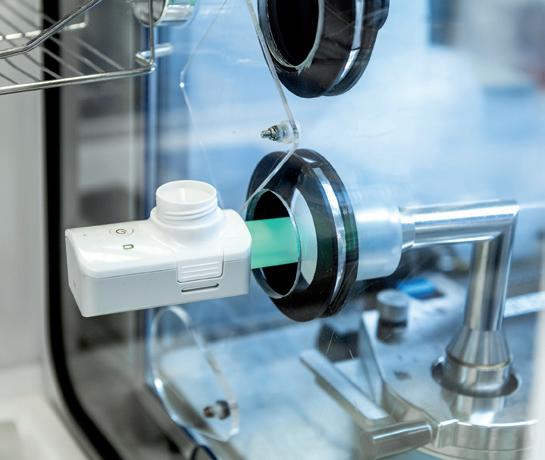
you’re doing standard cascade impaction testing, you typically suck four litres of air through the equipment. It’s difficult to imagine a person of any size with a fourlitre inhalation volume, so it’s not that representative of the patient-use case.
As soon as you’re thinking about evaluating an inhaler in an early clinical study, you want to know what might happen when a patient uses the device. To really understand what’s going on, you need to use more realistic testing using all the previously mentioned tools together
with in silico tools, such as lung deposition modelling, where you introduce the aerosol into a mathematical model to represent the set of patient lungs, or even a “real” lung model derived directly from patient CT scan to get a much better feel for lung deposition. It’s now possible to get a comprehensive picture of what happens when a patient uses the device and develop an understanding of how that potentially translates to blood levels. Building this understanding can save an enormous amount of time and money during development.

“Having the required disciplines under the same roof can really help to solve problems by having experts from device development, formulation, analysis, manufacturing and scale-up all in the same room. Vectura can offer all this.”
QOutsourcing development is a highly competitive space, including in the inhalation space – what makes Vectura stand out amongst the competition?
AAt Vectura, we have all the disciplines needed to progress an inhalation project from the very early stages of development to ready for commercialisation. We are effectively a one-stop shop for our customers.
Having the required disciplines under the same roof can really help to solve problems by having experts from device development, formulation, analysis, manufacturing and scale-up all in the same room (Figure 4). Vectura can offer all this, with our expertise spanning DPIs, nebulisers and pMDIs. We’re also currently moving into the intranasal sector as well.
When someone approaches us with an idea for a product, we can look at their target product profile and give them our best, unbiased advice, even if that means using a third-party device instead of one of ours. I think that’s another strength we have – we’re not constrained to going down a particular approach, we will propose what we think is best for the programme regardless.
QFor a long time, asthma and COPD were seen as the mainstay of the respiratory sector. However, in recent years, the industry has showed increasing interest in using the inhalation route to tackle a much wider range of disease areas –can you offer us any insights on this trend?
AThere is, of course, the massive trend towards biologics. We use pipeline analysis databases to view all of the inhaled products currently in development, so we can work out what that says about the future. Broadly speaking, there are usually 700 or more inhaled products in development across the world at any one time. We track how those change and evolve over the years and, last year, for the first time ever, we saw a switch from small molecules to the majority being
biologic products. Also important to note is that around a third of those products are intranasal, which says something about the massive opportunity intranasal delivery represents.
There are good medicines in mainstream asthma and COPD now. There are definitely still some intractable areas of those diseases, so there is still scope for innovation, but in mainstream healthcare, the issues relate more to people taking their medicine regularly or to having access to good education to enable them to use their inhaler device correctly. Hence we see interesting things happening with regard to connectivity and education to improve adherence and inhaler-use outcomes.
Currently, there seems to be interest in systemic delivery via the lung alongside niche and orphan respiratory diseases getting a lot of attention from smaller biotech companies. The covid-19 pandemic generated interest in treatments that could potentially alleviate symptoms for people suffering from severe diseases, and covid-19 got people thinking about all sorts of different potential therapeutics.
There’s also interest in vaccine delivery via the nose or lungs. There could be some major advantages to the delivery of vaccines to the respiratory system, such as removing the need for cold chain storage. If you can have a room-temperature-stable dry powder that you can ship all over the world and inhale via a simple, low-cost device, that’s going to be hugely beneficial in difficult-to-reach regions.
QLet’s move on to another current trend in inhalation, this time on the device side. As you’ve mentioned, Vectura has developed a proprietary smart mesh nebuliser, FOX. Why is there such heightened interest in mesh nebulisers and soft mist inhalers?
AA lot of the interest is driven by two things. One thing is the desire to get excellent deposition in the lung and, in particular, the small airways. Say you’re trying to treat idiopathic pulmonary
fibrosis, the disease is deep down in the lungs, so you have to get the therapy as deep into the lungs as you can. The second thing is that biologics tend to be aqueous soluble, which means that, if you want to get to the clinic for a fast proof of concept, ideally you’re going to want a device that can deliver an aqueous solution. That way, there’s no need to pursue a complex formulation that might require huge amounts of material –you’ve got your liquid solution, you stick it in the device and you give it to people. It’s fast, it’s simple, it’s cost effective and it maximises the probability of success via excellent lung deposition.
Those are, in my opinion, the two main reasons why there’s a massive interest in Vectura’s FOX technology and mesh nebulisers more generally, as distinct from jet nebulisers, which are noisy and bulky. Also, the mesh nebulisation process is more gentle, which is important when you’re dealing with fragile complex biologic molecules.
On top of that, FOX has a number of unique features compared with other mesh nebulisers. For example, a standard mesh nebuliser constantly produces aerosol, regardless of whether the patient is breathing in or breathing out, which means half of the medicine is wasted with those devices. FOX, on the other hand, only generates aerosol when the patient is inhaling, so there’s none of that waste.
The other thing that FOX does is guide the patient to inhale at a fixed flow rate, typically 15 L/min, to maximise lung deposition. Compare that with normal, continuously producing nebulisers, where patients sit with the device mouthpiece constantly in their mouth and do tidal breathing, which is a relatively shallow inhalation manoeuvre.
“A
standard mesh nebuliser constantly produces aerosol, regardless of whether the patient is breathing in or breathing out, which means half of the medicine is wasted with those devices. FOX, on the other hand, only generates aerosol when the patient is inhaling.”
What FOX is trying to get the patient to do is draw the aerosol as deep down into their lungs as they can to get the best results from their medication. To achieve this, FOX has to have some resistance to air flow, which is variable – the harder the patient tries to suck on the device, the more the device restricts flow. This results in the patient ending up in a comfortable space for their optimised inhalation flow, and there are lights in the mouthpiece of the device to help guide the patient to be as close to 15 L/min as possible. We’ve also implemented Bluetooth connectivity in FOX, which enables it to be connected to an app to transfer data, which can be used in a clinical trial or commercial setting.
It isn’t a one-size-fits-all solution for every medicine in development – that doesn’t exist – but, at certain stages of development or for certain kinds of medicines where maximising lung deposition is important, we think FOX is an excellent solution.
QTo wrap up, please could you share your thoughts on the major changes and innovations you expect the respiratory sector to see over the coming years?
AI think connectivity is a big thing. If you look at conferences over the past five years, there’s been a significant focus on connectivity – it’s something people are very interested in. However, I think there are still some questions around who’s going to pay for it. I also think the strongest case for it is in the clinic to start with, where connectivity can help you understand what individual patients have done during the study, which can
“There’s
substantial interest in the intranasal route for vaccines, but there’s also excitement around using intranasal for acute care applications.”
help you decide how usable their data is – if they haven’t used the device properly, it could mean that their data is poor, and connectivity can tell you why.
High-dose therapies is an area that I think could be key in the respiratory space. We’re already moving towards higher doses, partly driven by biologic therapies, so you are delivering tens or hundreds of milligrams instead of 50 or 500 μg, which is the dose for a potent asthma molecule. This means that there’s a step change in how much you have to deliver.
Another driver is the sheer diversity of different kinds of illnesses and medicines that companies are evaluating these days. We’ll see a lot more biologic therapies coming through the pipeline. And, as I’ve said, there’s substantial interest in the intranasal route for vaccines, but there’s also excitement around using intranasal for acute care applications. Opioid overdose is a key example, where the patient may be unconscious and the easiest way to deliver emergency recovery medicine is for a caregiver to spray it up the patient’s nose.
Lastly, I’d note that there’s growing interest in using the inhalation route for psychiatric medicines – treatments
for autism, for example, and the use of psychedelics in conjunction with intensive therapy to help people overcome things like addiction and post-traumatic stress disorder. There are lots of ideas out there for new and different kinds of medicines. It’s a truly exciting area to be working in.
Vectura is a leading specialist inhalation CDMO that provides innovative inhaled drug delivery solutions that enable customers to bring their medicines to market. With differentiated proprietary technology and pharmaceutical development expertise, Vectura has the device, formulation, and development capabilities to deliver a broad range of complex inhaled therapies. Vectura has contributed to the success of 13 inhaled medicines launched by its partners and licensees.
Dr Sandy Munro
Senior Vice-President –Pharmaceutical Development E: sandy.munro@vectura.com
Vectura Group Ltd
One Prospect West Chippenham
Wiltshire
SN14 6FH
United Kingdom
www.vectura.com

In this article, Matthew Fenn, Head of Business Development, and Clair Brooks, PhD, Applications Specialist, both at Copley Scientific, consider the motivation for adopting more clinically representative test set-ups in orally inhaled and nasal drug product development and, more specifically, for the demonstration of bioequivalence, as well as the practicalities of doing so and the tools available to support such efforts.
As recently released information from the US Pharmacopeia (USP) Expert Panel on New Advancements in Product Performance Testing (EP-NAPPT) indicates, there is scope for metrics for orally inhaled and nasal drug products (OINDPs) measured using compendial methods to become more clinically meaningful – if how predictive they are of in vivo lung delivery can be improved.1 This observation highlights some important issues for the OINDP community, for both innovator and generic product development. For example, how easily can the clinical relevance of established test methods be improved? And what value is there in doing so if such testing is not yet required by regulators?
Relative to in vivo testing, in vitro methods are faster, less expensive and more reproducible. Enhancing them to better support in silico modelling, and to minimise reliance on pharmacokinetic (PK) and pharmacodynamic (PD) studies, could therefore be highly beneficial.
Regulatory guidance calls for in vitro testing for extensive product characterisation, including the measurement of critical quality attributes (CQAs) such as delivered dose uniformity (DDU) and aerodynamic particle size distribution (APSD).2,3 Implemented under standardised, well-controlled conditions, in vitro tests are simple, easy to validate
“Relative to in vivo testing, in vitro methods are faster, less expensive and more reproducible.”
and low cost, relative to in vivo testing. However, robust in vitro-in vivo correlations (IVIVCs) are scarce for OINDPs, in large part due to the impact of patient-to-patient variability with respect to technique, physiology and disease state/lung impairment.
While in vivo studies are also required for all NDAs, the situation with regards to accelerated NDAs (ANDAs) is more nuanced. The EMA proposes a “stepwise” approach to generic submissions that allows for acceptance on the basis of in vitro data alone, provided that demanding criteria are met.4 Recent guidance has reiterated this approach for the specific case of metered dose inhaler (MDI) reformulation with lower global warming potential (GWP) propellants.5
In contrast, the US FDA’s 505(j) and 5050(b)(2) pathways used for generics and supergenerics respectively call for a “weight of evidence” approach, involving PK (comparative systemic exposure studies) and PD studies, alongside in vitro testing (Figure 1). That said, the FDA has stated that it is openly supportive of “novel bioequivalence (BE) approaches”,6 and there are a growing number of product-


Dr Clair Brooks Applications Specialist
Copley Scientific Ltd Colwick Quays Business Park Nottingham NG4 2JY
United Kingdom
T: +44 1159 616229
E: sales@copleyscientific.co.uk
www.copleyscientific.com

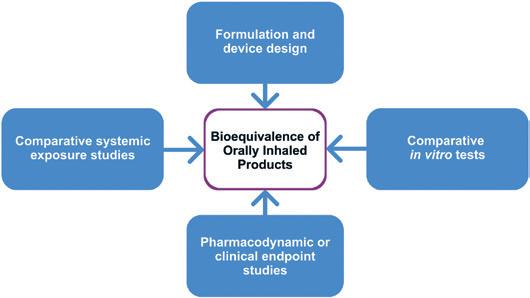
Bioequivalence of orally inhaled products
“Though most regulatory submissions will undoubtedly continue to rely on both compendial methods and in vivo data, better IVIVCs could shift the balance with respect to the extent to which they do so, especially for ANDAs.”
specific guidances that include routes to approval via in vitro data alone, such as fluticasone propionate and mometasone furoate nasal spray,7,8 or without PD studies, such as beclomethasone dipropionate metered aerosol.6
Against this backdrop, the motivations for improving the clinical relevance of in vitro methods come into focus. For both ANDAs and NDAs, better IVIVCs would facilitate a Quality by Design (QbD) approach to development, making it easier to identify CQAs and knowledgeably manipulate formulation and device towards clinical success. Design of experiment (DoE) studies, such as that reported by Lock et al to develop enhanced description of the performance of the dry powder inhaler (DPI) Breo® Ellipta™ (fluticasone furoate and vilanterol, GSK), exemplify this approach.9 On the other hand, for ANDA submissions, better IVIVCs equate with the ability to robustly confirm BE in vitro, increasing the likelihood of approval via in vitro routes alone and reducing reliance on in vivo data.
This last point is especially important, as clinical studies have well-recognised limitations. The therapeutic relevance of PK studies is questionable for OINDPs targeting local efficacy as opposed to systemic action; although by reliably confirming equivalence with respect to total systemic bioavailability, test and reference, they do support claims of
equivalent safety. PD studies, on the other hand, are challenging to implement due to the need to work with a diseased, and consequently variable, patient population and to identify a suitable biomarker; high variability and poor sensitivity are both commonplace. Moving away from clinical endpoint PD studies for ANDAs is therefore highly desirable.
In summary, although most regulatory submissions will undoubtedly continue to rely on both compendial methods and in vivo data, better IVIVCs could shift the balance with respect to the extent to which they do so, especially for ANDAs. Potential gains include faster development, better clinical study design and interpretation and, ultimately, a lower risk of failure in the clinic.
In emphasising IVIVCs, it is helpful to acknowledge that this represents a divergence in intent from compendial methods. These were established to safeguard the quality of pharmaceutical products, so their development therefore prioritised simplicity, repeatability, broad applicability and sensitivity, rather than specific clinical exactness.
The gap analysis carried out by the EP-NAPPT highlights several areas where there is scope for productive modification of compendial methods to accelerate product development and provide supplementary
data to strengthen submission packages, pointing to the potential benefits of using:1
• More realistic mouth-throat models and inspiratory flow profiles to make APSD measurement more representative of in vivo delivery to the lung
• More realistic nasal inlets and air flow rates to make assessments of off-target drug delivery – pulmonary as opposed to intranasal – more reliable
• Nasal casts to assess regional deposition within the nasal cavity
• In vivo-relevant dissolution testing to provide a better understanding of local and systemic exposure in both the nose and lung
• Morphologically directed Raman spectroscopy (MDRS) to measure drugspecific particle size distribution data for “as delivered” nasal suspensions in place of a clinical endpoint study.
The issue of mouth-throat models provides a good example of how, with the right tools, clinical relevance can be improved without compromising the reproducibility and utility of test methods. The European Pharmacopeia (PhEur) and USP induction port specified for APSD measurement of orally inhaled products (OIPs) was developed to provide a robust representation of the throat but clearly lacks physiological realism and is known to underpredict deposition in the upper respiratory tract.10 An anatomically precise throat cast is the obvious alternative, but inter-subject variability, along with the practicalities of manufacture and routine use, are major limitations. Rather, the better option is a mouth-throat model that is simplified as far as possible, within the constraint of realistically reflecting deposition behaviour across a broad patient population, as exemplified by the Alberta Idealised Throat (AIT), which is depicted in Figure 2.
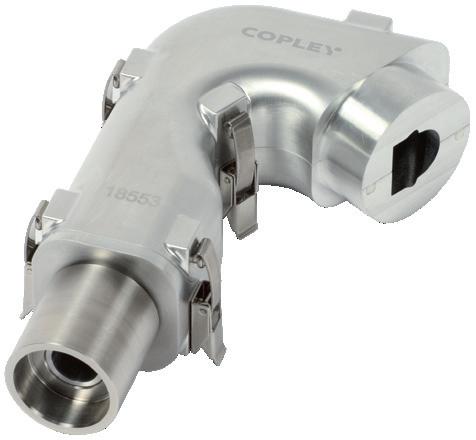
However, establishing better IVIVCs relies not only on improved representations of patient physiology but also on the assessment of device handling and use characteristics. For example, EMA guidance for the demonstration of BE for MDIs specifically references the “cold freon” effect – the chilling sensation associated with impaction of the aerosol plume at the back of the throat and propellant evaporation. Since this effect can cause a patient to alter, or even abort, an inhalation manoeuvre, parity is highly relevant to the interchangeability of MDI products.4 MDIs are also necessarily tested with facemasks, depending on the target patient population, as detailed in USP <1602>, which covers testing for MDIs with spacers and valved holding chambers.11
Figure 2: The AIT is an easy-to-use accessory for APSD measurement that provides a more clinically realistic representation of the upper respiratory tract than the standard USP and PhEur induction port.

air flow rate through the cascade impactor. The separation efficiency of cascade impactors is a function of air flow rate, which must be known and constant for reliable measurement.
As researchers become more aware of the merits of better IVIVCs, the test apparatuses already available to achieve them are becoming better understood, more mainstream and more widely used, making it easier to assess the potential benefits.
PROGRESS TOWARDS BETTER IVIVCS
Investigating the Impact of Inhalation Profile
Since drug delivery with a DPI is driven solely by the inhalation manoeuvre of the patient, in vitro investigations of the impact of different patient inhalation profiles are especially valuable for this class of OIPs. For example, they allow researchers to determine whether or not a specific patient group will receive a clinically effective dose, and whether test and reference products are equally sensitive to patient technique. Figure 3 shows a cascade impactor set-up for an APSD measurement incorporating an AIT, a breathing simulator for application of a specific inhalation profile rather than the square wave associated with compendial methods and a mixing inlet to simultaneously maintain a constant
Work by Abadelah et al to assess the impact of inhalation profile on drug delivery with an Onbrez Breezhaler® (indacaterol maleate, Novartis) exemplifies the studies that these set-ups can enable.12 Inhalation profiles of patients with chronic obstructive pulmonary disease (COPD) were quantified in terms of peak inspiratory flow (PIF), inhalation volume and initial acceleration rate as they inhaled through an empty Breezhaler in accordance with instructions in the patient information leaflet. APSD
measurements were then taken using an IVIVC test set-up and the resulting patient inhalation profiles. Total emitted dose (TED), fine particle dose (FPD) and mass median aerodynamic diameter (MMAD) were all found to be dependent on PIF and inhalation volume, with the most unproductive profiles producing a TED of 61% of the nominal dose and an FPD of just 19%.
Interestingly, a comparable study of the performance of Breezhaler with a once-daily long-acting muscarinic antagonist (LAMA) glycopyrronium formulation indicated more robust performance with higher TED and FPD values and less variability across inhalation profiles representative of COPD patients.13 Such results underline the formulation- and product-specific nature of flow-rate sensitivity and the corresponding need for testing.

For generics, analogous testing is helpful in demonstrating equivalence with respect to device handling and robustness to patient physiology, as exemplified by work from Shepherd et al in assessing the performance of Wixela Inhub® (fluticasone propionate and salmeterol, Mylan Pharmaceuticals), a generic version of Advair Diskus (fluticasone propionate and salmeterol, GSK).14 The Wixela Inhub was shown to exhibit low flow rate dependency, delivering a relatively consistent dose across inhalation profiles representative of COPD patients and, crucially, to deliver comparable performance to Advair Diskus in this regard (as assessed from published data). Similarly, Chrystyn et al investigated the performance of DuoResp Spiromax® (budesonide and formoterol, Teva Pharmaceuticals) relative to Symbicort Turbuhaler® (budesonide and formoterol, AstraZeneca), finding Spiromax to be more robust with respect to inhalation profile but more sensitive to mouth-throat geometry.15
As noted, DPIs are typically the focus of studies into the impact of the inhalation profile, but there is also evidence that nebuliser testing may benefit from similar refinement. Svensson et al found that using a breathing simulator and mixing inlet to apply a patient-representative breathing pattern across a nebuliser during APSD measurement resulted in a fine droplet dose equal to only 72% of that obtained with
Clinically Relevant Assessment of the Safety of Nasal Drug Products
The requirement for nasal inlets to assess deposition in the nasal cavity and to measure off-target deposition in the lungs is analogous to the need for more realistic mouth-throat models, and comparable solutions are evolving. For example, the same team that developed the AIT has designed the Alberta Idealised Nasal Inlet (AINI), shown in Figure 4, an accessory that is similarly easy to use and representative of a broad patient population. Using the AINI in a cascade impactor test setup allows researchers to simultaneously investigate regional deposition in the nasal cavity and the risk of pulmonary delivery, an important safety concern for nasal drug products.
In a study by Potts et al, the AINI was used to determine the <10 µm fraction for three spray-dried caffeine formulations with different particle size characteristics.17 For all three formulations, less than 2.5% of the sample deposited in the impactor, suggesting a minimal safety risk, even though laser diffraction measurements indicated a <10 µm fraction of ~95% for the finest formulation. This important result underlines the value of using a clinically representative nasal inlet in combination with an aerodynamically relevant particle sizing technique to robustly assess the
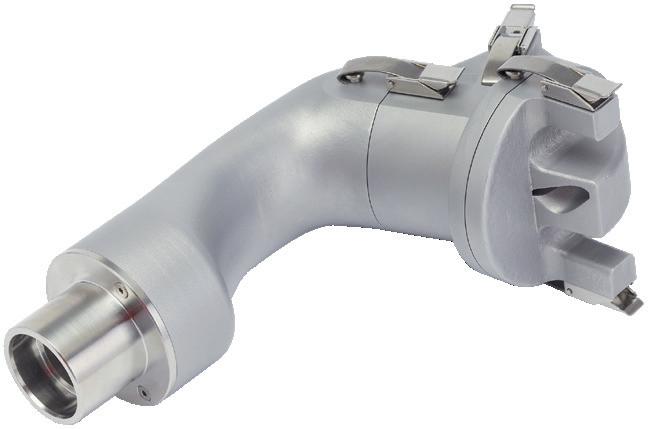
“The buoyancy of the OINDP marketplace is stimulating both interest and innovation in testing practice.”
safety of nasal drug products. The particle size of the formulation was also shown to influence regional deposition within the nasal cavity, a potentially important factor for product developers seeking to optimise clinical efficacy.
Nasal drug product testing practice is arguably less well established, relative to that for OIPs, but evolving quickly; interest in the application of inhalation profiles is similarly emerging in the drive to make both deposition and off-target delivery studies as representative as possible. More broadly, the buoyancy of the OINDP marketplace is stimulating both interest and innovation in testing practice. The robust reproducibility and sensitivity of compendial methods is crucial for product quality control, but working towards better IVIVCs is widely recognised as an important goal to strengthen the utility of in vitro methods for product development and regulatory submissions.
Figure 4: The AINI is a clinically validated accessory for investigating regional deposition in the nasal cavity and the risk of off-target drug delivery to the lungs.

Copley Scientific is recognised as a leading manufacturer of inhaled drug test equipment. Products include delivered dose-sampling apparatus, Andersen and next-generation impactors, critical flow controllers, pumps, flow meters and inhaler testing data analysis software. Copley Scientific also supplies novel systems for improving productivity and in vitro-in vivo correlations, including automation ancillaries, abbreviated impactors, breath simulators and the Alberta Idealised Throats and Nasal Inlet. Training, calibration, maintenance and impactor stage mensuration services are also available. Founded in 1946 in Nottingham, UK, Copley Scientific remains family owned and managed. The company continues to work closely with industry groups and leading experts to bring relevant new products to market, with all equipment backed by expert training and lifetime support.
1. Sakagami M, Fotaki N, “Testing the In Vitro Product Performance of Inhalation and Nasal Drug Products: Views of the USP Expert Panel”. Pharmaceutical Forum 48(5), Sep–Nov 2022.
2. “Draft Guidance for Industry: Metered Dose Inhaler (MDI) and Dry Powder Inhaler (DPI) Drug Products--Quality Considerations”. US FDA, Apr 2018.
3. “Guideline on the Product Quality of Inhalation and Nasal Products”. EMA, Jun 2006.
4. “Guideline on the requirements for clinical documentation for orally inhaled products (OIP) including the requirements for demonstration of therapeutic equivalence between two inhaled products for use in the treatment of asthma and chronic obstructive pulmonary disease (COPD) in adults and for use in the treatment of asthma in children and adolescents”. EMA, Jan 2009.
5. “Questions and answers on data requirements when transitioning to low global warming potential (LGWP)
propellants in oral pressurised metered dose inhalers”. EMA, Nov 2023.
6. “Draft Guidance on Beclomethasone Dipropionate”. US FDA, May 2019.
7. “Draft Guidance on Fluticasone Propionate”. US FDA, May 2023.
8. “Draft Guidance on Mometasone Furoate”. US FDA, May 2023.
9. Lock DJ, Watkins A, Munro A, “DPI Performance Modelling Using an Inhalation Simulator and Oropharyngeal Model: A more Patient-Relevant Approach for Device Development”. Presented at DDL 25, Dec 2014.
10. Zhang Y, Gilbertson K, Finlay WH, “In vivo-in vitro comparison of deposition in three mouth-throat models with Qvar and Turbuhaler inhalers”. J Aerosol Med, 2007, Vol 20(3), pp 227–235.
11. “<1602> Spacers and Valved Holding Chambers Used with Inhalation Aerosols—Characterization Tests”. United States Pharmacopeia, 2023.
12. Abadelah M, Chrystyn H, Larhrib H, “Use of inspiratory profiles from patients with chronic obstructive pulmonary disease (COPD) to investigate drug delivery uniformity and aerodynamic dose emission of indacaterol from a capsule based dry powder inhaler”. Eur J Pharm Sci,
2019, Vol 134, pp 138–144.
13. Zanker D et al, “‘In Vitro Dose Delivery Performance of Glycopyrronium using Representative Inspiratory Flow Profiles derived from COPD Patients”. Presented at DDL 23, Dec 2012.
14. Shepherd T et al, “In Vitro Performance of the Wixela Inhub Inhaler Using Severe Chronic Obstructive Pulmonary Disease Patient Inhalation Profiles.” J Aerosol Med Pulm Drug Deliv, 2022, Vol 35(3), pp 154–165.
15. Chrystyn H et al, “Effect of inhalation profile and throat geometry on predicted lung deposition of budesonide and formoterol (BF) in COPD: An in-vitro comparison of Spiromax with Turbuhaler”. Int J Pharm, 2015, Vol 491(1–2), pp 268–276.
16. Svensson M et al, “Laboratory Study Comparing Pharmacopeial Testing of Nebulizers with Evaluation Based on Nephele Mixing Inlet Methodology”. AAPS PharmSciTech, 2018, Vol 19(2), pp 565–572.
17. Potts JC et al, “Investigations into the Relationship Between Spray Dried Powder Particle Size and Deposition in Nose and Lung Analogues when Actuated from a Nasal Device”. Resp Drug Deliv, 2023, Vol 2023, pp 431–436.
Matthew Fenn has nearly 20 years of experience in the healthcare sector. He joined Copley at the start of 2023, coming from Jabil, the world’s largest manufacturing solutions provider for the healthcare industry. With a background in medical devices, pharmaceutical delivery systems and consumer health products that includes a long spell at 3M Health Care, Mr Fenn has specialist technical and sales support knowledge ideal for supporting customers across a wide range of pharmaceutical testing applications.
Clair Brooks, PhD, is an Applications Specialist for Copley Scientific. Providing in-depth application support to those working with OINDPs and other pharmaceutical dosage forms, including tablets and capsules, Dr Brooks helps scientists to ensure regulatory compliance during R&D and quality control assessments. As an accomplished life sciences professional with extensive experience supporting the start-up and operation of heavily regulated testing labs across both industry and academia, Dr Brooks offers support on how best to apply Copley products and services to support pharmaceutical development and manufacture to help maximise return on investment. She also leads Copley's comprehensive user-training programme, run on-site and at Copley HQ.
Improve correlations between in vitro OINDP testing and in vivo performance
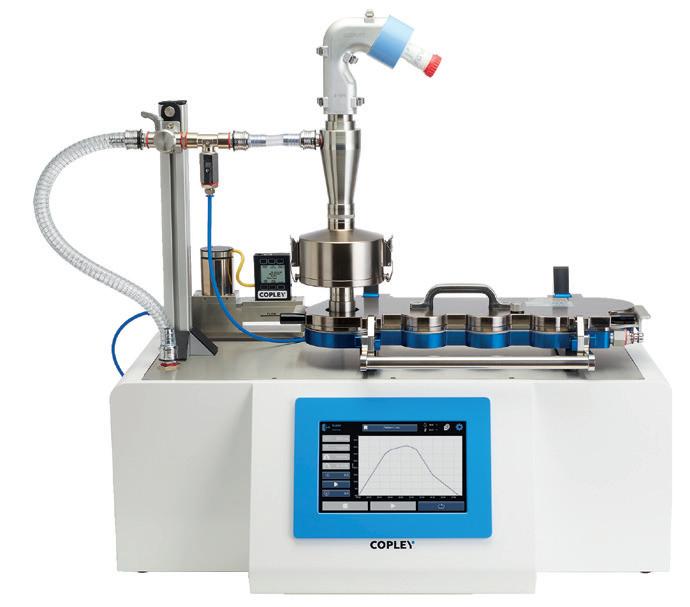

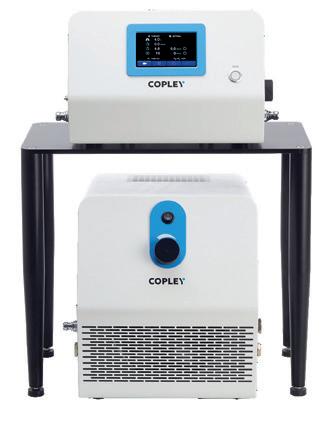
Enhance the clinical realism of in vitro testing with our range of solutions for:

In this article, Gemma Budd, General Manager at Nanopharm (an Aptar Pharma company), and Julie Suman, PhD, Vice-President of Scientific Affairs at Aptar Pharma, consider the key issues that preclinical and clinical trials for orally inhaled and nasal drug products must address within the context of the information that regulators are looking for, providing insight, strategies and advice for both novel and generic products in this sector.
As inhaled and nasal drug delivery becomes increasingly popular, more drug developers are facing the challenge of taking complex orally inhaled and nasal drug products (OINDPs) through clinical trials. This is no easy task, especially with the relevant expertise and capabilities in relatively short supply. Understanding informational requirements and how best to invest scarce resources to de-risk and accelerate progress is vital.
To set the informational requirements for preclinical and clinical trials in context, it is worth considering the multiple regulatory pathways by which OINDPs currently proceed to market. NDAs for small molecules are approved via the 505(b)(1) route – an arduous, high-risk pathway that calls for full preclinical and clinical studies. Biologics are a growing area of research activity, and the biologics licence application (BLA) brings additional requirements for such products.
The NDA 505(b)(2) route, or “hybrid application” in EMA terms, is for new formulations of existing drugs and streamlines progress to market on the merits of existing data. This is the route pursued for drug repositioning, which is a notable trend in the OINDP space. Generic OINDPs are approved via the abbreviated NDA (ANDA) 505(j) pathway,
“The preclinical stage of OINDP development is a lengthy iterative process that establishes whether or not a drug is worth taking from discovery into human trials and if it is safe to do so.”
with the most popular targeting localised action in the nose and lung. Approval for a prescription to over the counter (OTC) switch can also be obtained via this route. These routes are all associated with slightly different requirements when it comes to preclinical and clinical studies. However, there are fundamental similarities and overlaps, notably with respect to chemistry, manufacturing and controls (CMC).
ESTABLISHING A ROBUST FOUNDATION FOR CLINICAL TRIALS
The preclinical stage of OINDP development is a lengthy iterative process that establishes whether or not a drug is worth taking from discovery into human trials and if it is safe

Dr Julie Suman
Vice-President of Scientific Affairs
T: +1 410 455 5909
E: julie.suman@aptar.com
Aptar Pharma
250 North Route 303 Congers
New York 10920
United States
www.aptar.com/pharmaceutical

Gemma Budd
General Manager
T: +44 1633 372 200
E: g.budd@nanopharm.co.uk
Nanopharm
Franklin House Grange Road Cwmbran NP44 3WY
United Kingdom
www.nanopharm.co.uk
to do so. Therefore, the primary goals are to evaluate clinical efficacy realistically and rigorously assess safety.
The key questions to answer with respect to establishing clinical efficacy include:
• How will the drug achieve efficacy?
• Is the intention for local or systemic action and how will the drug reach the target site?
• Will the delivery system significantly influence drug product performance –during in vitro testing, in animal studies and, ultimately, in human use?
• What devices should be used for animal testing, and can they be used for human trials?
• How can animal testing be made as representative as possible?
With respect to safety and toxicology, there is a need to establish the limits associated with use of the drug substance, as well as for any functional excipients being used for the first time or at levels beyond approved limits. Toxicology studies call for the capability to confidently define the identity, strength, purity and quality of functional drug product constituents, taking account of the potential for degradation and recognising that – for OINDPs – the strength of the formulation on the shelf is not the same as what is delivered. Put simply, these studies are about demonstrating the ability to confirm that the chosen analytical and manufacturing processes can securely deliver a drug product of suitable quality for clinical trials and, ultimately, commercial use (Box 1).
At the preclinical stage, animal testing and product development – including formulation and device characterisation –proceed in tandem, with both presenting the potential for difficulties.
Animal testing with OINDP devices is made complicated by both the inability to control the “technique” of the animal and the species-dependent geometries of the nose and lung. Using specific device actuators for animals and paediatric devices can help but, even with robust data, translation to performance in humans is relatively poor with few reliable models.
This intensifies the need for physiologically based pharmacokinetic


Figure 1: Aptar Pharma’s devices suitable for animal dosing include the PADA and fine mist sprayer (top) for mice, the Unidose (UDS) liquid and powder paediatric (bottom left and middle) and the VP7-232NE paediatric, a multidose nasal spray (bottom right).
Aptar Pharma has a broad range of proprietary drug delivery platforms for the development of OINDPs, along with expertise and drug delivery technologies to accelerate and de-risk development. For example, Aptar Pharma offers a range of devices for animal testing, from dedicated solutions such as its fine mist sprayer and powder administration device for animals (PADA), which are suitable for testing with mice, through to single and multidose devices for paediatrics, which are also suitable for dosing medium to large animals (Figure 1). These devices have similar, though not identical, spray performance to commercial products and enable far more representative assessment than pipettes and droppers. Aptar Pharma can also introduce partners to specialised CROs with OINDP expertise in preclinical studies.
Aptar Pharma also offers the SmartTrack™ platform, a combination of clinically representative in vitro test methods and in silico tools, including computational fluid dynamic (CFD) and PBPK models. SmartTrack delivers good in vitro-in vivo correlation and can help product developers define the required dose, set an effective quality target product profile and understand the impact of formulation characteristics on the clinical outcomes, including local and systemic pharmacokinetics and regional deposition in the site of action.
(PBPK) models and robust deposition studies, both of which can help to elucidate performance. The timing of animal studies is crucial as, although simple, early formulations (drug and buffer) may be inadequate for proofof-concept – they do little to securely prepare the ground for human trials and may give misleading data about a drug’s safety and efficacy.
With respect to product development, early priorities include the need to achieve viable drug stability and bioavailability by:

• Identifying the most appropriate dosage form – powder or liquid
• Assessing the effect of alternative excipients – on stability, retention at the deposition site and/or permeation
• Determining the impact of the deposition profile and the ability of different devices to achieve the desired delivery
• Investigating the effect of patient technique.
Liquid-based formulations tend to be easier to develop, for both intranasal and pulmonary delivery, but the merits of dry powder formulations can be compelling: higher drug loading, greater stability and increased retention at the deposition site. For certain drugs, such as those that are poorly soluble or labile biologics, these benefits may be pivotal to the realisation of a commercially viable product.
Solubility or stability enhancers may facilitate a liquid formulation, but there is a distinct lack of approved candidates for these delivery routes. The lack of permeation and retention enhancers (mucoadhesives) is similarly problematic for all dosage forms. While the use of novel excipients is an option, this will add time and risk to the product development process. Currently, there is no requirement for OINDP
“At the preclinical stage, stability requirements only extend to ensuring the consistency of the product for the duration of clinical trials, which could potentially be just a few months.”
formulations to be sterile, but the need to maintain microbial limits in line with regulatory guidelines routinely necessitates the inclusion of preservatives, which may negatively impact stability, adding to the complexity of the formulation process.
At the preclinical stage, stability requirements only extend to ensuring the consistency of the product for the duration of clinical trials, which could potentially be just a few months. However, given that a poorly stable product will inevitably need to be reworked, should clinical trials prove successful, it is worth the investment to achieve robust stability early, so as to minimise risk and timelines.
On the other hand, when it comes to the regulatory tests associated with OINDP characterisation, there is scope for discernment versus the full CMC guidance from the regulators, most notably during Phase I clinical studies. There is a balance to be struck between gathering enough data to help make decisions or justify changes down the line and doing everything too soon, then having to repeat it again later. Figure 2 differentiates critical tests from those that are nice to have, helping to focus efforts to achieve the maximum effect. Time and cost can also be saved by adopting a strategy of “phase-appropriate method qualification”, where there is no need to fully validate analytical methods at this stage, though they must, of course, be robustly fit for purpose.
A primary focus going into clinical trials is setting a schedule for gathering the remaining information required for regulatory submission. Unfortunately,
for OINDPs, such efforts are hampered by a lack of harmonised and, in some instances, up-to-date guidance. This situation is at its worst for nasal powders, where there is only minimal specific information available.
Planning out how much drug product and how many units will be needed to implement clinical trials, and how they will be made, is a crucial task for early-stage clinical studies. Even though the clinical study is small, it is easy to underestimate how many units are needed for the method qualifications, release and stability studies.
For OINDPs, the manufacture of drug substance and drug product are often discrete processes with no stated requirement for sterility in the assembled OINDP. Manual filling and assembly at the clinical trial site is therefore an option for Phase I, provided that there is sufficient expertise to do so. This approach can be advantageous if, for example, stability is poor or not yet known, or if drug cost or scarcity prohibits early commercial-scale processing.
Ensuring that a suitable reference standard is in place for the drug substance as early as possible is also helpful, particularly for new molecular entities. Without this, there is a risk of delays in establishing effective analytical protocols, as well as the potential to undermine confidence in the ongoing stability of that product, particularly as the drug substance and drug product manufacturing processes scale up and advance through the clinical stages.
Phase II marks the point at which commercially representative processes become essential and the demand for drug product begins to grow quickly,
with larger scale stability studies getting underway alongside more extensive product characterisation. Extractables and leachables studies should be on the radar at this point, as the material for such studies is most efficiently produced as part of the registration batches. Data relating to extractables should be available from component suppliers, but leachables studies are product-specific and may be required even for generics.
Now is also the time to investigate in detail how patients will use the device, as regulators will expect to see evidence that human factors have been considered in the device choice and in the development of effective instructions for use. The goal is to demonstrate that patients can use the device as instructed and, if they do, that it delivers well-defined performance.
Moving into Phase III, manufacturing ramps up considerably. Representative registration batches are typically produced at 1/10th commercial scale, with additional batches produced in association with pilot-scale studies, scale-up and for process validation. Batch release testing requirements rise correspondingly, and full-method validation becomes necessary in accordance with USP/ICH guidelines.
A stability programme to establish shelf life is an important aspect of Phase III trials that calls for the testing of three batches (even for ANDAs) under room temperature, accelerated and intermediate storage conditions. Furthermore, there is a need to assess the impact of device orientation during storage, which doubles the amount of product required for testing.
Lastly, this is the point at which oneoff product characterisation studies for OINDPs are necessarily implemented. For nasal sprays, for example, such tests include robustness (drop and vibration testing/cleaning), temperature cycling,
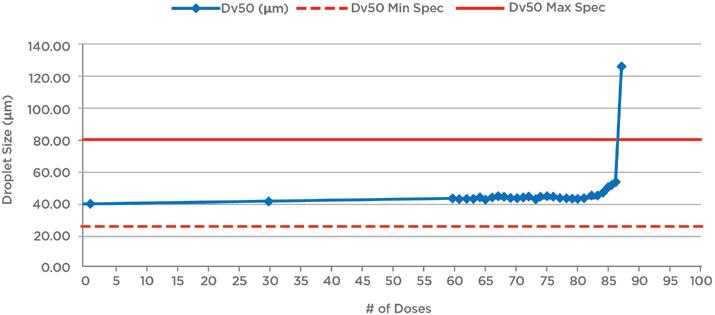
Figure 3: Example tail-off data for a nasal spray shows that performance is maintained for an additional 25 doses beyond label claim (60 doses). Reducing fill levels for the device would therefore reduce waste and the risk of confusion for patients; a relatively short tail-off is preferable.
“In the early stages, when there are few units to test and the product is subject to change, it can be advantageous to designate data for characteristics unassociated with product safety, such as nasal spray pattern, as “for information only” and delay specification setting.”
priming/repriming, photostability, effect of dosing orientation and tail-off or profiling (Figure 3).
One issue to consider in clinical trials is when to establish specifications for the product, and for which characteristics. In the early stages, when there are few units to test and the product is subject to change, it can be advantageous to designate data for characteristics unassociated with product safety, such as nasal spray pattern, as “for information only” and delay specification setting.
Regarding product changes, the likely commercial device should ideally be in
use for Phase II – preferably in Phase I, as well – but device changes are sometimes unavoidable and can be managed, however, having solid characterisation data to support the bridging will help a lot. For example, Phase I trials may indicate a need for dose escalation, necessitating a switch from a single-dose to a multidose device, or amplify the benefits of powder formulation. Unfortunately, any change in the device may change in vivo deposition behaviour and, by extension, may impact clinical efficacy, so this will need to be evaluated. Robust characterisation of whatever device and formulation is taken into the clinic provides the best possible foundation for justifying any such change, should it prove necessary, and can therefore be a worthwhile upfront investment.
The number of product units required to implement OINDP clinical trials is considerable, and routinely underestimated. The schedule shown in Table 1 indicates the number of products needed for just one test – aerodynamic particle size distribution (PSD) – for a single nasal spray batch, for a three-year stability programme; 25°C/60% relative humidity (RH) is the room temperature condition, 40°C/75%RH is the accelerated condition, 30°C/65%RH is the intermediate condition and 30°C/75%RH is an additional test condition associated with the ambition of marketing the device in tropical climates (ICH Zone 4).
Aptar Pharma’s experience indicates that it is realistic to expect to need at least 15,000 units for multidose devices for Phase III trials, more if using unit dose, with material-hungry tests, such as microbiological testing and the assessment of leachables, adding to this requirement. It is key to plan out these requirements sufficiently early to secure registration batches of the required size and establish efficient routes for production, as any failure to do so can have a major impact on progress to market.
OINDPs are arguably the most challenging class of pharmaceutical product to make, and relatively few contract design and manufacturing organisations are equipped to support the transition from R&D into a GMP environment. Be sure to determine whether a potential partner rigorously understands specific drug sensitivities, the intricacies of the device and the analytical demands associated with the product before committing to avoid compromising clinical trials.
The amount of product required for OINDP clinical trials may well surprise developers more familiar with alternative dosage forms, as indeed might the many and diverse issues associated with bringing OINDPs to market. The complex interplay between device, formulation and patient that drives drug delivery via the nose and lungs presents a major challenge; understanding how to manipulate device and formulation characteristics to propel a promising drug candidate to success remains an expert task. There is significant and exciting clinical potential in this field, and growing interest in exploiting it. Experienced, specialist, integrated CROs and contract design and manufacturing organisations can help
Table 1: An example for the number of units required solely for DSD measurements associated with a stability test for a nasal spray illustrates how the number of units required for clinical trials builds up.
product developers to invest well, at the right time and in the most productive way to reduce the risk associated with these routes and accelerate successful products to market.
For pharma customers worldwide, Aptar Pharma is the go-to drug delivery partner, from formulation to patient, providing innovative drug delivery systems, components and active material solutions across the widest range of delivery routes, including nasal, pulmonary, ophthalmic, dermal and injectables. Aptar Pharma Services provides early-stage to commercialisation support to accelerate and de-risk the development journey. With a strong focus on innovation, Aptar Digital Health is leading the way in developing digital health solutions to help improve the
patient treatment experience. With a global manufacturing footprint of 14 manufacturing sites, Aptar Pharma provides security of supply and local support to customers. Aptar Pharma is part of AptarGroup, Inc.
Nanopharm, an Aptar Pharma company, is a leading provider of tailored analytical and drug development services, with a focus on orally inhaled and nasal drug products. The company’s unique processing technologies and formulation development tools enable seamless translation of preclinical development through to clinical manufacturing. Nanopharm’s integrated development services in materials characterisation, formulation development and inhaled biopharmaceutics aids successful product development by understanding how material properties and processing conditions influence product functionality.
Julie Suman, PhD, is the Vice-President of Scientific Affairs for Aptar Pharma. She holds a BSc in Pharmacy and a PhD in Pharmaceutical Sciences. Dr Suman is co-editor for Respiratory Drug Delivery Proceedings and an Affiliate Assistant Professor in the Department of Pharmaceutics at Virginia Commonwealth University (VA, US).
A past Chair of the AAPS Inhalation Technology Focus Group, Dr Suman has published in several peer-reviewed journals and presented at numerous international meetings.
Gemma Budd is the General Manager of Nanopharm, an Aptar Pharma company, responsible for formulation development and analytical services of orally inhaled and nasal drug products. With a degree in biomedical sciences, Ms Budd has over 12 years of experience in the pharmaceutical industry in both research and commercial positions, from materials science and analytical services to formulation technology and drug delivery devices, primarily for oral and inhaled dosage forms.

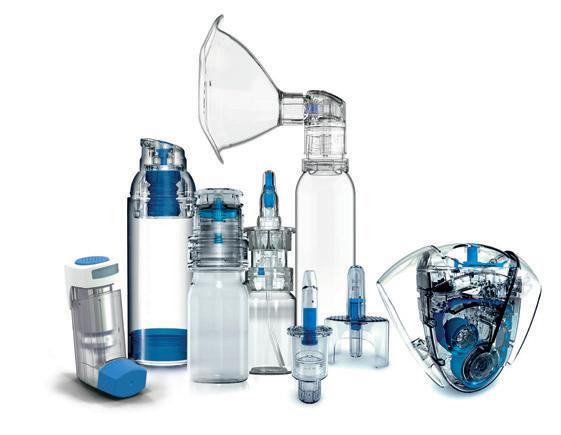
Here, Alan Watts, PhD, Director of Innovation & Partnerships for Orally Inhaled Products at Catalent, and Michael Tauber, Senior Director of Pharmaceutical Development at Acorda Therapeutics, discuss the requirements and benefits of using spray-dried powders for inhalation, and how ARCUS, used for the successfully commercialised Inbrija® dry powder inhaler, is a prime example of this technology in action.
After more than 20 years of academic research, formulation development, clinical trials and industrial scale-up, a combination product for Parkinson’s patients – Inbrija® (Acorda Therapeutics) – comprised of dry powder particle-engineered levodopa and a breath-actuated device was approved by the US FDA in 2018. This product is one of several commercial orally inhaled products that use spray drying as a means to produce a highly respirable powder capable of efficiently and conveniently delivering a drug payload to the airways (Table 1).
The spray-dried particle engineering technology used for Inbrija – ARCUS® –enables dosing of 42 mg of API in a single size 00 capsule while minimising excipient
content (<8 mg). These engineered powders are consistently taken up into inspired air by a single breath, due to their low density. Unlike traditional lactose-blended dry powder inhaler (DPI) formulations, high respirable fractions of >60% of the nominal dose can be achieved by these spray-dried powders over a broad range of inspiratory flow rates. Clinical data has indicated rapid absorption and improved consistency in plasma concentrations compared with oral formulations. Inbrija uses a device designed for a size 00 capsule, which allows for high powder volume in a single capsule, whereas approximately three size 3 capsules would be required for an equivalent dose from a typical capsule-based DPI.

Dr Alan Watts
Director of Innovation & Partnerships for Orally Inhaled Products
T: +1 512 689 2982
E: alan.watts@catalent.com
Catalent Pharma Solutions
160 Pharma Drive Morrisville NC 27560
United States
www.catalent.com
Breztri (AstraZeneca)
Bevespi (AstraZeneca)
(AstraZeneca)
Podhaler (Viatris)
(Acorda Therapeutics)
(Chiesi)
Table 1: Commercial spray-dried products for inhalation.

Michael Tauber
Senior Director of Pharmaceutical Development
T: +1 781 466 3929
E: mtauber@acorda.com
Acorda Therapeutics
283 Bear Hill Road Waltham MA 02451
United States
www.acorda.com

The ARCUS technology was initially developed in the labs of Dr Robert Langer at the Massachusetts Institute of Technology (MA, US) and Dr David Edwards at Harvard University (MA, US). This initial development of large porous particles was described in a landmark 1997 Science article titled “Large Porous Particles for Pulmonary Drug Delivery”.1 Shortly after this publication, a start-up company, Advanced Inhalation Research, was launched and began using this approach to develop drug products for systemic drug delivery via the lung. Through various acquisitions and spin-outs, the technology eventually found its home with Acorda Therapeutics in 2014.
The drive to develop this technology stemmed from the need to overcome some of the inherent challenges faced when developing dry powders for inhalation delivery. For fine particles (those <5 µm in diameter) intended for lung delivery, cohesiveness is governed by electrostatic and van der Waals forces more so than gravitational or inertial forces. Dispersion of these fine particles can take a lot of energy.
“Pulmonary delivery of particles made with ARCUS requires significantly less energy to disperse the powder into an inhalable aerosol, due to decreased interfacial interactions.”
Historically, DPIs have used blends with a carrier excipient, such as lactose monohydrate, to keep these small particles separated, with them adhering to the larger lactose particles rather than each other. Additionally, lactose carriers have served as a bulking agent, allowing for the metering of microgram quantities of API as a blended powder. ARCUS allows for the delivery of drug powder to lungs while minimising and, to some extent, overcoming these inherent challenges (Figure 1).
Using a spray drying process, ARCUS generates engineered particles that are easily dispersible, low density and porous, with a mean aerodynamic diameter of ~3 µm. The aerodynamic diameters of these particles are similar to those of conventional aerosol particles, yet their lower density and larger geometric diameter (~10 µm) requires much less energy for powder dispersal, allowing for use by patients with compromised lung function. This improved dispersibility is enabled through a proprietary spray drying process and excipient selection, resulting in low-density particles. Due to the lowdensity and porous nature of the ARCUS particles, these geometrically large particles exhibit the aerodynamic behaviour of smaller particles.
Pulmonary delivery of particles made with ARCUS requires significantly less energy to disperse the powder into an inhalable aerosol, due to decreased interfacial interactions – specifically, a reduction in particle-particle interactions, including van der Waals forces and electrostatic forces. This reduction in particle-particle interactions reduces agglomeration and leads to improvements in powder flow, dispersion and, ultimately, aerosol generation from a patient-powered DPI device.
From a manufacturing perspective, volumetric metering of small masses is enabled by low bulk density, where a smaller mass will occupy a given metering cavity. However, low-density powders also present filling operation challenges, where special consideration must be given to reduced powder flowability. Complexities and instabilities leading to powder blend heterogeneity are avoided by spray drying composite particles, where each particle contains the same API load. Therefore, bulk powder segregation during manufacture, shipping and storage is of little concern for spray-dried powders.
Solid-State Control
Spray drying approaches often use hydrophobic excipients to improve flow and prevent moisture ingress by preferentially including them on the exterior surface of the particle. ARCUS particles can be made physically stable in an amorphous form with or without a hydrophobic crystalline shell. Within an amorphous powder formulation, excipient selection is dictated by the ability of the particles to maintain a stable glass transition temperature with no evidence of crystallisation or molecular mobility.
As a general rule, a glass transition temperature (Tg) that is approximately 50°C above the formulation’s intended storage conditions is necessary to reduce molecular mobility and minimise the potential for recrystallisation. When matrix material has a lower Tg, closer to the storage temperature, the molecular mobility of the material will increase and molecules will begin to rearrange and self-assemble, which can lead to nucleation, recrystallisation and instability. For Inbrija, a Tg value at or above 75°C is generally observed, making it suitable for storage at room temperature.
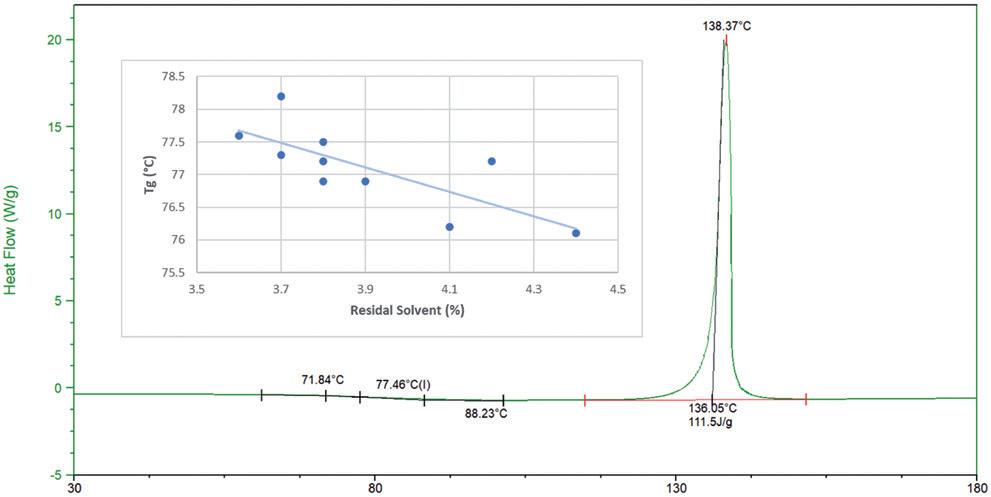
Protection from the plasticising effects of residual water, solvent and high relative humidity during manufacture and storage is critical for maintaining the amorphous solid state of these powders. As expected, ARCUS formulations demonstrate an inverse correlation between Tg and residual solvent level (Figure 2). In cases where a Tg is less than 75°C, special considerations for composition, manufacture, packaging and, ultimately, environmental conditions can still facilitate stability.
An amorphous formulation also improves the dissolution rates of poorly water-soluble drugs, which can help improve the rate and extent of absorption. The importance of solubility for pulmonary drugs is reflected in the growing attention to the physiological relevance of dissolution rate-limited APIs that are currently delivered as powders.2 Improvement of solubility through amorphous stabilisation of an inhaled corticosteroid could provide improved efficacy in the lungs and reduce off-target exposure.3
For protein and polypeptide therapeutics, an amorphous state is essential to maintaining conformational and biological stability. The underlying theories supporting stability of a large molecule in an amorphous glass matrix are water replacement and vitrification. Within the particle matrix, excipients that maintain a stable amorphous structure are chosen, which may also be surrounded by a crystalline hydrophobic shell that can combat moisture uptake.
In ARCUS formulations, excipients are selected for their role in:
1. Enabling the formation of the particle shell
2. Enhancing porosity, dispersibility and aerosolisation
3. Maintaining chemical stability.
One key differentiator between ARCUS and other DPI technologies is the ability to administer high doses. High doses for dry powder inhalation are enabled by a formulation capable of achieving high potency (limited API–excipient ratio) and high repeatability within a single unit dose

Table 2: Influences of formulation approach on total lung dose (mg), assuming that half the capsule body is filled with powder (0.45 mL and 0.18 mL). Inbrija is 90% API, 0.1 g/cm3 density, 60% FPF; typical ARCUS powder is 50% API, 0.1 g/cm3 density, 60% FPF; lactose blend is 10% API, 0.5 g/cm3 density, 20% FPF.
of powder. Compositions ranging from 10–90% active loading have been developed with ARCUS technology, with typical formulations consisting of ≤ 50% active.
In addition to formulation, the FDAapproved ARCUS device (Figure 3) uses a size 00 capsule, offering over three times the powder capacity of a standard size 3 capsule. Several calculations of total lung dose are given in Table 2 to estimate the quantity of drug load delivered in a single dose of Inbrija, a hypothetical ARCUS powder and a standard coarse blend from the ARCUS size 2 and 00 devices.
While engineering a spray-dried formulation clearly improves efficiency and enables a higher lung dose, the capacity of the ARCUS 00 device can enable a high lung dose even with a standard lactose blend. It should be noted, however, that 90 mg and 225 mg of bulk blended powder would need to be loaded into size 2 and 00 capsules to achieve these lung levels with the given assumptions. This quantity of powder could require multiple inhalations to clear from a single capsule as the amount of powder that an adult can comfortably inhale in a single breath is approximately 50 mg.4 It should also be noted that these quantities may be poorly tolerated by the patient. If jet milled material were used to produce a high dose product, it might be more effective to use neat powder, avoiding lactose blending completely.5
ARCUS has been used to develop a preclinical-stage dry powder synthetic lung surfactant aerosol that has shown potential as a surfactant therapy for pre-term infants supported by non-invasive respiratory support.6 The lung surfactant formulation showed viability for long-term storage as a powder with a stable fine particle fraction (FPF) up to six months at 40°C and one year at 5°C. ARCUS has also demonstrated
utility in stabilisation and delivery of nucleic acid payloads as an aerosol without the use of non-viral vector encapsulation, such as in lipid nanoparticles. Future work will focus on the physiological efficacy, uptake and expression of these new modalities.
When evaluating any pharmaceutical technology, it is important to understand its ability to scale to meet clinical and commercial demands, as well as ensuring that a fit-for-purpose manufacturing facility is available. For ARCUS powders, not only is such a facility available, but it has an established track record of regulatory inspection and approval. Catalent Boston acquired Acorda’s 90,000 square-foot manufacturing site in early 2021 and continues to produce and release commercial Inbrija, as well as other clinical-stage spray-dried and encapsulated products.
Spray Drying, Encapsulation and Blistering
Spray-drying capacity within the Catalent Boston site is shown in Figure 4 and includes specialised capabilities for the production of ARCUS powders in addition to other widely used particle engineering approaches. As noted by the PSD-4 and PSD-7 scales, there is ample capacity to produce very large quantities of spraydried material even in the 1–3% solids loading range, as is typical for inhalation feedstocks. While suitable batch sizes for early clinical trials and orphan-disease commercial products can be obtained using a pilot scale PSD-1, evaporation capacity peaks at approximately 5 kg/hr and limitations of multi-day process stability and resourcing must be considered. Batch sizes in the 10s or 100s of kilos will find a better fit at the PSD-4 and PSD-7 scales, respectively.

“Many spray-dried powders benefit from, or require, specialised facilities capable of maintaining an extremely dry production environment.”
For ARCUS and other spray-dried powders for inhalation, encapsulation is often used to contain powders in premetered unit doses that are compatible with a variety of multi-use DPI devices, including the ARCUS size 00 and 2 devices. While spray drying yields highly respirable powders with low to moderate levels of excipients required, these powders often have poor flow properties. With no large, coarse particles to improve flow and the need for low fill weights, the filling operation can often be challenging with traditional encapsulators.
At the Catalent Boston site, drum filling technology with specialised powder feeding systems has been designed to accommodate high Carr’s index powders at fill rates of up to 100,000 capsules per hour. At mid-speed, this could encapsulate a 5 kg batch of 20 mg filled capsules in five hours. As many inhalation APIs are categorised as potent, enclosures to protect from dust generated by the filling operation are also in place for this unit operation.
Special consideration must be given to the handling and exposure of bulk and even encapsulated powders at this step in the manufacturing process. Because unprotected filled capsules are not fully protected from the environment, rapid blistering in a single controlled manufacturing setting is also desirable, and is completed at the site prior to sleeving for shipping to a secondary pack assembler.
Many spray-dried powders benefit from, or require, specialised facilities capable of maintaining an extremely dry production environment. Moisture exposure during production, even momentarily, can render moot the careful controls placed over bulk spray-dried powder and capsule dryness. Catalent Boston maintains a relative humidity (RH) less than 20% throughout encapsulation and blistering operations to ensure that sensitive powders are not exposed to destabilising moisture. Lower controls (<10% RH) have also been demonstrated in designated suites for operations with extreme moisture sensitivity.
Spray drying to manufacture powders for inhalation is now a well-established practice in the pharmaceutical industry that allows for the production of highly respirable, high-dose formulations. ARCUS technology incorporates the benefits of spray drying with a capsulebased high-capacity device. As one of only three commercially approved technologies for spray drying inhalable powder, ARCUS provides an opportunity to design an inhalation product with an established and successful regulatory track record.
With development, commercial-scale manufacturing and analytical equipment
already in place at a single site, the supply chain is simplified, and tech transfers are largely eliminated. With the approval of Inbrija in 2018, the 20-year-long path from invention to market was completed, creating a de-risked and, likely, more timely opportunity for follow-on products.
Catalent’s offering in the field of drug delivery is vast and spans the oral, inhalable and injectable routes, among others. It is a development, delivery and supply partner with a large range of solutions for small molecules and biotherapeutics, including numerous proprietary drug delivery technologies.
Acorda Therapeutics is a biotechnology company that develops therapies to improve neurological function in people with Parkinson's disease, multiple sclerosis and other neurological disorders. It manufactures and markets the drugs Inbrija (levodopa inhalation powder) and Ampyra (dalfampridine) in the US.
1. Edwards DA et al, “Large porous particles for pulmonary drug delivery”. Science, 1997, Vol 276(5320), pp 1868–1871.
2. Hastedt JE et al, “iBCS: 1. Principles and Framework of an Inhalation-Based Biopharmaceutics Classification System”. Mol Pharm, 2022, Vol 19(7), pp 2032–2039.
3. AboulFotouh K et al, “Amorphous solid dispersion dry powder for pulmonary drug delivery:

Catalent is your preferred CDMO for pulmonary delivery, with over 30 years of dry powder inhalation expertise. Our capabilities in drug development, scale-up and commercial manufacturing for spray dried and carrier-based powders can accelerate the time to market of your inhaled therapy.
Our state-of-the-art facility in Boston, MA has the largest capacity worldwide, supporting manufacturing, encapsulation and blistering of dry powders from clinical supplies through commercial scale.


Advantages and challenges”. Int J Pharm, 2020, Vol 587, Article 119711.
4. Son Y-J, Miller DP, Weers JG, “Optimizing Spray-Dried Porous Particles for High Dose Delivery with a Portable Dry Powder
Inhaler”. Pharmaceutics, 2021, Vol 13(9), Article 1528.
5. Brunaugh AD et al, “Excipient-Free Pulmonary Delivery and Macrophage Targeting of Clofazimine via Air Jet Micronization”. Mol Pharm, 2017, Vol 16(11), pp 4019–4031.
6. Walther FJ et al, “Efficacy, dose-response, and aerosol delivery of dry powder synthetic lung surfactant treatment in surfactant-deficient rabbits and premature lambs”. Respir Res, 2022, Vol 23(1), Article 78.
Alan Watts, PhD, is Director of Innovation & Partnerships for Orally Inhaled Products at Catalent. He has nearly 15 years’ experience in the development of inhalation products in both industrial and academic settings. Prior to Catalent, Dr Watts was Associate Director of Pharmaceutical Development for Savara Pharmaceuticals, leading combination product development, and Research Assistant Professor at the University of Texas at Austin, where he oversaw an aerosol research lab, taught Pharmacy courses and co-invented a novel dry powder inhalation platform. Dr Watts has a PhD in Pharmaceutics from the University of Texas at Austin and a BS in Biomedical Engineering from Louisiana Tech University.
Michael Tauber is Senior Director of Pharmaceutical Development at Acorda Therapeutics. Since 2002, he has worked in various areas of pharmaceutical development, including early- and late-stage development, pre-formulation and formulation for solid oral development, formulation and scale-up of spray-dried engineered particles for inhalation delivery and management of chemistry, manufacturing and controls (CMC) related activities supporting the development and commercialisation of Inbrija (levodopa inhalation powder). Additionally, Mr Tauber has served as the solid-state chemistry technical lead on numerous projects over the years and has established solid-state labs, as well as instructed many peers on this topic. He also managed all aspects of the extractables and leachables programme for Inbrija through NDA/MAA approval. Mr Tauber holds a BS in Chemistry from UMass Boston and an MS in Chemistry from Northeastern University.

• Implementing ISO 10993-17 & ISO 10993-18 Standards
•
• AETs and Response Factor Variation for E/L Studies
•
• Uncertainty Factors Reconsidered: Toxicological & Chemistry Perspectives


•
• David Saylor,
• Chandana Kolluru, Boehringer Ingelheim
•
• Jakob Lange, Ypsomed AG
• Arne Kloke, Schott Pharma
• David Seitz, Formerly Amgen
• Nicole Soucy, Boston Scientific • Ping Wang, Janssen R&D • Dujuan Lu, SGS
In this article, Susana Saldanha, PharmD, R&D Manager – Inhalation and Advanced Drug Delivery, Lídia Santos, PhD, Analytical Scientist – R&D, and Rui Churro, PhD, Senior Scientist, all of Hovione, discuss the benefits of crystalline formulations for inhalation devices.
Respiratory drug delivery has diversified the pipeline and portfolio of diseases that can be treated through this route, including already approved anti-infective medicines for cystic fibrosis or influenza patients, and others in development for pulmonary arterial hypertension, idiopathic pulmonary fibrosis and other rare lung diseases. Also, the doses and molecules delivered to
“High concentrations of drug at the site of action could enable a reduction in dose and dosing frequency, and, subsequently, potential side effects.”
the lungs have increased in the last years from a few micrograms to milligrams, as seen in Figure 1.1,2 This growth in the delivery of high doses has been observed in pharmaceutical compounds, such as antibiotics, vaccines, proteins and peptides, as well as for the treatment of acute emergency indications via the inhalation route.3
High concentrations of drug at the site of action could enable a reduction in dose and dosing frequency, and, subsequently, potential side effects.4 Dry powder inhalers (DPIs) are frequently employed delivery systems for the pulmonary administration of high drug loads of APIs. The majority of DPIs are developed as carrier-based mixtures in which a coarse inert carrier is mixed with the micronised drug substance, with a particle size in the respirable range (< 5 µm). Blending the API with an
Dr Susana Saldanha R&D Manager – Inhalation and Advanced Drug Delivery
T: +351 219 829 000
E: ssaldanha@hovione.com
Dr Lídia Santos
Analytical Scientist – R&D
T: +351 219 829 000
E: lsantos@hovione.com
Dr Rui Churro
Senior Scientist – Inhalation and Advanced Drug Delivery
T: +351 219 829 000
E: rmchurro@hovione.com
Hovione PharmaCiência, SA Campus do Lumiar Edifício R Estrada do Paço do Lumiar 1649-038 Lisboa
Portugal www.hovione.com
excipient that acts as a carrier improves the aerodynamic performance for low API loads but, as excipient-API interaction is saturated, API-API interaction may result in aerodynamic performance variability.5
Carrier-free dry powder formulations for inhalation are widespread solutions for overcoming these challenges and efficiently deliver the API to the lungs. Particle engineering by spray drying of high load formulations from a solution, can result in a product with adequate performance; however, it often necessitates more restrictive storage and handling conditions due to the amorphous state of API and excipients. Additionally, to successfully stabilise the API amorphous form, relatively high loads of stabilising excipients, such as glass-forming sugars, may be required, reducing the drug product potency. Further, depending on the quality target product profile, namely the dose and dosing frequency, crystalline formulations may be required to avoid a fast release and clearance, as observed in amorphous counterparts.
Developing a crystalline formulation with enhanced aerodynamic performance can present a challenge because there is a greater dependency on the physical characteristics and performance of the API. To overcome this challenge, a formulation platform was developed by Hovione (WO2011131947A). This platform technology enables the wet micronisation of the API to the target particle size distribution and the addition of a force control agent to the API suspension, aiming to improve the aerodynamic performance of the drug product, even when the drug load is high (>80% w/w).
There are several force control agents that can be selected, depending on the API characteristics and desired performance. The main cohesion mechanisms and forces of spray-dried particles that impact powder cohesion and flowability are derived from van der Waals forces, electrostatic forces and capillary forces, if there is humidity present. Force control agents (FCAs) can act as powder dispersibility modulators by changing the particles’ surface and consequently impacting van der Waals forces and cohesion.6
Some examples of force control agents that can be used are distearoylphosphatidylcholine (DSPC), dipalmitoylphosphatidylcholine (DPPC), lecithin or leucine. The force control agent most suitable for a certain product will be dependent on API properties as well
“Manufacturing methods aimed at achieving consistent particle size distribution for crystalline drugs entail a diverse array of approaches.”
as on the desired critical quality attributes (CQAs), namely intended emitted dose and fine particle fraction (FPF).
Crystalline drugs are often used in inhalation formulations owing to their unique and key advantages that contribute to the effective development of safe therapies for the treatment of respiratory diseases and systemic conditions.
When developing crystalline inhalation products, the challenge faced by manufacturers is often related to obtaining uniform crystalline drug particle distribution in a reproducible, controlled and scalable process. Manufacturing methods aimed at achieving consistent particle size distribution for crystalline drugs entail a diverse array of approaches. These include conventional techniques, such as dry or wet milling, categorised as top-down methods, as well as emerging bottom-up strategies, such as controlled crystallisation.
Hovione has showcased the efficacy of these techniques in controlling the particle size distribution of crystalline drugs and, subsequently, the aerodynamic performance. Among these, top-down strategies, such as wet polishing, stand out as techniques that are robust and scalable. Although bottom-up approaches, such as controlled crystallisation using microfluidisation, have garnered traction, they are still in the early stages of development and face challenges in achieving the target CQAs.7 In that regard, Hovione supports drug product development under quality-by design (QbD) methodologies. Wet polishing integrates a wet media size-reduction technique coupled with spray drying as the isolation step.
A robust process development involves the early identification of potential critical process parameters (pCPPs) and potential CQAs. The development strategy encompasses a laboratory-scale familiarisation phase, which includes an exploration of the process design space leveraged by Hovione's modelling
capabilities. Experimental designs are conducted on the identified pCPPs, establishing correlations between scaleindependent variables, CQAs and process performance to facilitate scale-up. Several scales are available at Hovione’s portfolio enabling wet micronisation rates from 24 to 300 L/h. The process pressure:hydraulic pressure ratio can be adjusted based on early development studies as part of the QbD methodology to ensure the achievement of target CQAs.
Wet polishing is the particle engineering technology of choice for drug-alone formulations; however, depending on the API surface chemistry, wet polishing alone may not be sufficient to achieve the desired aerodynamic performance. Through this technology, it is evident that formulating a high-load mixture containing crystalline API and a minimal percentage of excipient (applied as a coating on the API surface) enables the development of innovative products, thereby enhancing treatment efficacy. The surface coating is achieved by dissolving the force control agent in the micronised drug suspension and spray drying the resulting feedstock, thereby promoting the coating and isolation of the API particles. During this stage, the models for droplet and particle formation, alongside the development of both the size-reduction and the spray-drying design spaces, are pivotal in determining the optimal coating of the micronised drug.
“Formulating a highload mixture containing crystalline API and a minimal percentage of excipient (applied as a coating on the API surface) enables the development of innovative products,
thereby enhancing treatment efficacy.”
Aiming to showcase the wet coating platform potentialities for different drugs and using diverse force control agents, two model drugs were tested. The API models chosen were an antiviral drug and a corticosteroid, both insoluble in water (<1 mg/mL). Log P, the antiviral drug, presented a lower Log P (3.3), when compared with the corticosteroid (3.7). The work performed involved the comparison of the API alone with two formulations with increased percentages of a force control agent.
The anti-viral model drug was suspended in water and wet milled until the target particle size distribution was obtained. Then, the feedstock was fed to a lab-scale spray dryer (Büchi, model B-290) while stirring. On specific formulations, leucine


(as FCA) was added to the suspension at increasing relative proportion (Table 1). All formulations showed Dv50 below 3 µm. The aerodynamic performance results obtained by a fast screening impactor (FSI), using an RS01 Plastiape device (100 L/min at 4 kPa), demonstrate that the fine particle dose (FPD) increases with the FCA percentage in the formulation composition until a plateau is achieved (around 25% w/w FCA for this drug). Figure 2 shows a FPD upgrade from 10 to 13 mg as a result of the coating of the crystalline API.
To further understand the coating effectiveness of the crystalline drug particles by the force control agent, an X-ray photoelectron spectroscopy (XPS) “fingerprint” model was developed (Figure 3). The presence of the element phosphorous (P) in red indicates the presence of API at the particle surface, as this element is exclusive to this material. The excipient element carbon (C) (black line in Figure 3) was identified through a Hovione “fingerprint” model. The results showed that there is an inflection point at approximately 25% w/w of leucine, where the leucine’s “fingerprint” C element becomes more prominent than the P element from the crystalline drug. These results indicate that at this excipient concentration the API becomes covered by the force control agent leading to an optimal formulation aerodynamic performance.
In this case study, the corticosteroid was suspended in water and micronised until the target particle size was obtained. After this particle size reduction step, the 5% w/w of force control agents lecithin and DSPC were dissolved in the suspension of Trial 1 and Trial 2, respectively. The suspensions were then fed to a labscale spray dryer (Büchi, model B-290) while stirring. All spray-drying trials were characterised for crystalline state of API, geometric particle size by dry dispersion (Sympatec, Basel, Switzerland) and assay by high-performance liquid chromatography. Aerodynamic performance was
characterised by FSI, using a RS01 Plastiape (Lecco, Italy) device (100 L/min at 4 kPa). Comparing with the drug alone FSI data, it can be concluded that the wet coat platform led to at least a twofold increase in FPD (mg), for both formulations tested, while maintaining the API crystallinity (Figure 4).
In conclusion, the studies show that the wet coat platform is suitable for improving the efficiency of drug delivery to the lungs, by improving the FPD and, consequently, FPF. This formulation development approach allows the delivery of high payloads while maintaining the crystallinity of the API. This formulation platform presents a significant advantage in terms of dissolution modulation because crystalline particles present a distinct dissolution profile when comparing with amorphous particles. Additionally, the long-term stability of the dry powder is also improved as crystalline particles are known to be physically more stable

than their amorphous counterpart. The force control agents added to the formulation could also be changed and optimised as needed to overcome the aerodynamic performance challenges associated with the different APIs’ surface characteristics. As such, Hovione
channels its extensive expertise in particle engineering and drug product formulation strategies, positioning itself as a prominent leader in this technology, which seamlessly integrates with wet polishing, optimising the aerosolisation of crystalline drugs.
27-28
JUNE, 2024
Barcelona, Spain


Hovione is an international company with over 60 years of experience in pharmaceutical development and manufacturing operations. As a contract development and manufacturing organisation, Hovione has a fully integrated offering of services for drug substances, drug product intermediates and drug products. The company has four US FDA inspected sites in the US, Portugal, Ireland and China and development laboratories in Lisbon (Portugal) and New Jersey (US). Hovione provides pharmaceutical customers with services for the development and compliant manufacture of innovative drugs. In the inhalation area, Hovione offers a complete range of services, from API, formulation and manufacturing process development to proprietary devices.
1. Ye Y, Ma Y, Zhu J, “The future of dry powder inhaled therapy: Promising or Discouraging for systemic disorders?”. Int J Pharm, 2022, Vol 614, p 121457.
2. Costa E et al, “Addressing challenges of high dose dry powder delivery: Formulation and Device considerations”. Respiratory Drug Delivery, 2023, Vol 2023, pp 101–112.
3. Sibum I et al, “Challenges for pulmonary delivery of high powder doses”. Int J Pharm, 2018, Vol 548(1), pp 325–336.
4. Anderson S et al, “Inhaled Medicines: Past, Present, and Future”. Pharmacol Rev, 2022, Vol 74(1), pp 48–118.
5. Abiona O et al, “The Optimisation of Carrier Selection in Dry Powder Inhaler Formulation and the Role of Surface Energetics”. Biomedicines, 2022, Vol, 10(11), p 2707.



Susana Saldanha , PharmD, graduated in Pharmaceutical Sciences from the Faculty of Pharmacy, University of Coimbra (Portugal). Dr Saldanha has over 10 years of experience in formulation development. She has supported the development of oral, transdermal, injectable and inhalation dosage forms, from early drug product development through to product registration and launch. In 2018, she joined Hovione where she started focusing on nasal and lung drug delivery. She has embraced drug product development projects from early to later stages, ranging from generics to innovative products. Since 2022, Dr Saldanha has been responsible for the management of the formulation team in the Inhalation and Advanced Drug Delivery Group.
Lídia Santos holds a PhD in the field of Nanotechnology and Nanosciences from the School of Science and Technology, NOVA University Lisbon (Portugal). Her doctoral studies focused on inorganic oxides nanoparticles synthesis and application in different electronic devices. In 2017, she joined Hovione as an Analytical Scientist, and since then she has been involved in several projects, from API to final drug products. Most recently, she has been focused on characterisation methodologies for respiratory formulations.
Rui Churro, PhD, is a Senior Scientist – Inhalation and Advanced Drug Delivery at Hovione and earned his PhD in the field of Refining, Petrochemical and Chemical Engineering at Faculdade de Engenharia, Universidade do Porto (Portugal) in 2020 with a thesis dedicated to heterogeneous catalysis. In 2020, he joined Hovione as a Drug Product Development Scientist, having been enrolled in drug product and drug product intermediate process development from early stage until commercial scale. Since 2022, he has been leading process development projects and internal R&D projects within the respiratory field, focusing on spray drying, capsule filling and formulation strategies for the Inhalation and Advanced Drug Delivery group as a senior scientist.
6. Weiler C et al, “Force control and powder dispersibility of spray dried particles for inhalation”. J Pharm Sci, 2010, Vol 99(1), pp 303–16.
7. Porfirio T et al, “Controlled crystallisation through microfluidisation as an alternative particle engineering technology for inhalation products”. AIChE Annual Meeting, 2023.
In this article, Marcus Jarman-Smith, Head of Marketing – Medical, and Yann Tréguier, Global Drug Delivery Segement Leader, both at Victrex, discuss the myriad benefits that Victrex’s pharmaceutical-grade PEEK can offer to the drug delivery sector as a material of construction due to its versatile material properties.
INTRODUCTION
As drug delivery devices and pharmaceutical manufacturing processes make more demands during their operation, the use of traditional pharmaceutical-grade materials of construction can be limiting. Materials are being asked to do more and provide increasingly higher performance levels, so a pharmaceutical grade of the highperformance polymer polyetheretherketone (PEEK) can be a welcome addition to the options available to design engineers.
PEEK stands out as a candidate for a material of construction in the pharmaceutical industry due to its ability to provide multiple high-performing properties. It offers exceptional mechanical strength, chemical resistance, wear resistance and electrical properties. However, where it really stands out is in its ability to do several of these things simultaneously (Figure 1). Increasingly, PEEK, which until

Marcus Jarman-Smith Head of Marketing – Medical E: mjarman-smith@invibio.com
Wear Resistance
Mechanical Strength
Versatile Methods of Processing Recyclable
Figure 1: PEEK has many beneficial properties that can be simultaneously exploited at high levels of performance. PEEK often becomes the material of choice where designs require three or more of these at the same time.

Yann Tréguier
Global Drug Delivery Segment Leader E: yann.treguier@victrex.com
Victrex PLC
Victrex Technology Centre
Hillhouse International Thornton Cleveleys Lancashire, FY5 4QD
United Kingdom
www.victrex.com/drugdelivery
now has been used to solve only more challenging applications, is being turned to as engineers continue to push the operating boundaries and the condition of use of drug delivery devices.
For drug delivery device development, a focus on patient centricity has meant miniaturisation, enhanced human factors and connectivity. For the materials of construction, this has often meant different or additional design inputs, sometimes in conjunction with a shrinking device footprint. PEEK has a high strength-toweight ratio. Connectivity also means the onboarding of electronic and battery components, which require properties that facilitate telemetry, insulation and recharging. PEEK has excellent dielectric properties and can be used as insulative coatings or films. Flexible circuits can also be printed onto a PEEK film.
With miniaturisation comes precision and the need for dimensional stability. PEEK can be micro-moulded at shot sizes below 0.1 g,1 and can create miniature functional parts with wall thicknesses of 50 µm. It has been investigated to create microneedles for drug delivery with a tip radius of 30 µm.2 Additionally, PEEK has high resistance to creep, unlike other polymers, such as polytetrafluoroethylene (PTFE). PEEK’s glass transition temperature (Tg) of 145°C and melting temperature of 343°C also make it stable at high temperatures.
PEEK does not have the optical clarity of, for example, cyclo-olefin polymers (COPs) or polycarbonates (PCs), which are common amorphous polymers used for pharmaceutical contact applications. Whilst PEEK can be produced as an amorphous polymer, usually as a film, it is typically a semi-crystalline polymer with high strength, stiffness, wear resistance and chemical resistance. PEEK is around 30% crystalline and usually sits alongside materials such as polyoxymethylene or acetal (POM) and nylon (PA66) as higher strength semi-crystalline thermoplastic polymers. PEEK can be used in place of POM or PA66 where higher strength, stiffness or temperature resistance is required. PEEK does not have the poor moisture absorption commonly seen with polyamides. Often, PEEK can be used as a gear component in drug delivery devices when conditions require more than can be met with POM.
The strength and stiffness of PEEK are being used in devices where the forces required would typically require the properties of metals (Figure 2). For example, on-body delivery systems and large-volume injection have seen increases in volume (e.g. from 1.5 mL to 3 mL) or a moreviscous rheology of the formulation (>50 cP), which can require pressures of 600 psi for 2.5 mL volumes.3 In respiratory devices, PEEK has been selected for inhalers using mechanical power to generate an aerosol, such as soft mist inhalers (SMIs).
The incidence of chronic obstructive pulmonary disease (COPD) and asthma is forecasted to rise to 600 million by 2050, which is a 23% increase over 2020.4 This
means that drug companies can expect higher penetration rates for these indications, which have traditionally treated by inhalers. However, new treatments for cancers and central nervous system (CNS) disorders are now also using the inhalation route of administration. Moreover, traditional pressurised metered dose inhalers (pMDIs) are under pressure to remove or reduce the hydrofluoroalkane (HFA) propellants currently used in order to reduce their environmental impact. These factors are contributing to driving alternative platforms, such as SMIs (Figure 3). Offering improved drug delivery through a mechanically generated aerosol, the mist created by an SMI is comprised of smaller droplets, resulting in a more precise dose that can penetrate deeper into the lungs, enhancing absorption and effectiveness.

alternative inhalation platform that can meet the needs of the modern respiratory sector, but can place high demands on their materials of construction.
From a materials perspective, an SMI needs materials that can create precise parts that retain tolerances and dimensional stability throughout the device’s lifespan, and that are able to be exposed to chemical formulations at high pressures. SMIs, therefore, require strength, stiffness, chemical resistance and biocompatibility (in terms of minimal leachable or extractable substances coming from the material). The material needs can be summarised as:
• Material is suitable for pharmaceutical contact
• Material is resistant to forces
• Material can be precision manufactured and retains tolerances
• Carbon footprint is less than incumbent metal parts
• Mass production through injection moulding allows total cost reductions.
As such, PEEK is particularly suitable for SMIs due to their high performance demands. With patents such as Boehringer Ingleheim’s Spiriva expiring in the US in 2027, there is space for the development of generic competitors, such as from Lupin,5 and for alternative SMI devices, such as the MRX004 (Merxin Ltd, King’s Lynn, UK) and Softhaler (InvoX, London, UK) to emerge. Materials of construction in direct contact with the API must also consider the specific needs of liquid formulations and the US FDA’s requirement for all aqueousbased inhalers to be manufactured sterile (as per Section 21 CFR 200.51) and maintain that sterility for multiple doses.6 Materials like PEEK can offer options not only for the device and container closure system, but also for process line equipment required to prepare the formulations. For production environments where there is exposure to harsh chemicals, steam and abrasion through cleaning in place (CIP)
“In
pharmaceutical process equipment, PEEK is indispensable for applications requiring aseptic conditions, sterility, corrosion resistance or wear resistance.”
or sterilisation in place (SIP), PEEK has a low water absorption rate (0.5 wt%), is extremely chemically resistant and able to endure multiple cycles of steam, gamma and ethylene oxide sterilisation methods.
Many millions of machines have already used PEEK in industrial manufacturing equipment components. In pharmaceutical process equipment, PEEK is indispensable for applications requiring aseptic conditions, sterility, corrosion resistance or wear resistance. Components such as seals, connectors, filling nozzles and biocompatible parts benefit from PEEK’s properties, ensuring product quality and regulatory compliance.
Typical applications are bioreactor components, such as connectors; sampling parts; mixing elements, such as impellers; and spray heads for CIP/SIP. Using PEEK for fermentation and vessel parts, such as impellers, can help reduce weight, heat generation and energy requirements. In-line sensor and electronics housings and insulation requiring non-metals, corrosion resistance and insulative properties are also common uses for PEEK, along with valves, sealing and connector components requiring low creep, precision and strength. Further downstream, pharmaceutical-grade PEEK can be used in filling nozzles, robotic grippers, conveyor belt gears and guiding components or cryogenic components.
Commonly, PEEK finds its sweet spot as an alternative to metal. It offers the benefits of thermoplastics, such as mass production through injection moulding, but is able to compete with metals in many physical and mechanical aspects with its impressive strength-to-weight ratio and ability to outperform metals in terms of corrosion resistance, anti-fatigue failure and electrically insulative properties.
PEEK can also be used instead of metal parts that may require multi-step machining and subsequent assembly, which, with PEEK, can be consolidated or moulded for a lower cost at mass-production scale. This is where PEEK can have a real impact on companies’ sustainability and energy targets. For metals such as 316SS and titanium, where there are high energy requirements during their production, there can be a global warming potential (GWP) of 35 kg of CO2 per kg compared with PEEK’s 13 kg CO2 per kg.7
As a thermoplastic, PEEK can undergo multiple melt cycles and be reformed into new shapes, unlike thermoset polymers such as polyester resin. Commodity polymers may often have a lower GWP for their production, but in use are required in significantly greater volumes and often as single use. These vast quantities demand broader recycling initiatives to control their mass usage. On the other hand, highperformance polymers, such as PEEK, tend to have a longer lifespan and are used for specialised components at lower
volumes, such as in permanent medical device implants or reuseable or high-value components in devices or production lines. Indeed, the switch to PEEK should be looked at from a total cost of solution perspective, rather than simply a price per gram. The difference in what PEEK can enable engineers to achieve has potentially far-reaching consequences. Prolonged durability or increased efficiencies have knock-on effects that improve the total cost of the solution and overall sustainability. Other high-performance industries with strong environmental, social and governance agendas, such as aerospace, have already adopted these materials for lighter weight and higher strength parts, consolidating parts or making assembly or usage easier. For example, PEEK wire bundle and tubing clamps for the Boeing 737/787 not only allowed a new design for one-handed user operation, which cut installation time by 30% versus the metal incumbents, but also cut the total weight of the many parts used in one aircraft by 20%, which led to significant fuel savings. All this would be overlooked if comparing simply on a material-to-material cost basis.8
In other industry sectors, PEEK has decades of use-case experience in highly demanding applications that could translate to the pharmaceutical and drug delivery device sectors. Diverse examples include back-up seal rings for low-temperature (sometimes cryogenic) energy applications, dimensionally stable thin films in mobile phone speakers, electrically insulating coatings in electric vehicles, chemically resistant sensors in food manufacturing and load-bearing implantable spinal devices. These applications are typically solutions in extreme environments or requiring industrycertified materials. With the advent of
“In other industry sectors, PEEK has decades of usecase experience in highly demanding applications that could translate to the pharmaceutical and drug delivery device sectors.”

pharmaceutical-grade PEEK, these benefits can be transferred to applications that may also require direct contact with APIs and compliance with industry standards, such as US Pharmacopeia (USP) Class VI.
For drug delivery devices exploring connectivity, PEEK is already used in many electronic applications, such as thin films for acoustics in an estimated four billion mobile phones, since the material retains the tight dimensional tolerances required for this application. PEEK is also used as an insulator, with stable dielectric properties over a wide range of temperatures, humidities and frequencies. PEEK has a dielectric strength of up to 270 kV/ mm, enabling higher voltage and power applications. PEEK also offers the benefit of being a structural material but, as a polymer, not interfering with telemetry or recharging.
The fundamental requirement for materials of construction for pharmaceutical contact applications is the ability for the end part to meet industry standards. Pharmaceuticalgrade PEEK has been specifically tested to standards relevant to the pharmaceutical industry, notably USP Class VI and USP <661> (Figure 4). This can reassure the part manufacturer that the material will be compliant and not pose any risk to end testing – while the end part will still need
to be tested for compliance, the use of material grades that have passed industry standards offers risk reduction, reassurance and, potentially, reduced time to market.
PEEK AS A PFAS-FREE ALTERNATIVE
PEEK may also be used in some scenarios as a replacement for per- and polyfluorinated substances (PFASs). In industry, PEEK has been used as a powder spray coating and is used as a PFAS-free, non-stick coating alternative for cookware. In energy applications, PEEK has been used as an alternative for PTFE and polychlorotrifluoroethylene (PCTFE) for sealing applications. Pharmaceutical-grade PEEK is available as a film, which is being explored as an alternative to PTFE on plungers in injection devices that require direct API contact.
To meet the growing needs of the industry, pharmaceutical-grade PEEK has been made available commercially. Pharmaceuticalgrade PEEK’s versatility, high-performance properties and regulatory compliance to pharmaceutical standards make it an invaluable material in pharmaceutical contact applications. As the industry continues to evolve, PEEK polymers, such as Victrex PC™ 101, will play a pivotal role in driving innovation, meeting increasing demands and ensuring the safety and efficacy of pharmaceutical products and processes.
From the invention of PEEK over 40 years ago, Victrex has continually pioneered new PAEK-based polymers, materials and solutions that have transformed markets, delivering global impact in the toughest environments. The company brings transformational and sustainable solutions that address world material challenges every day.
1. Ganz M, “PEEK Micro Moulding for Medical Parts – A Success”. CMM Magazine, Jul 2016.
2. Nair K et al, “Investigation of Plasma Treatment on Micro-Injection Moulded Microneedle for Drug Delivery”. Pharmaceutics, 2015, Vol 7(4), pp 471–485.
3. Roe MJ, “Challenges in HighViscosity, High-Volume Drug Delivery”. ONdrugDelivery, Issue 125 (Oct 2021), pp 40–43.
4. Boers E et al, “Global Burden of

Chronic Obstructive Pulmonary Disease Through 2050”. JAMA Netw Open, 2023, Vol 6(12), Article e2346598.
5. Dunleavy K, “Lupin wins approval for first US generic of Boehringer Ingelheim’s COPD blockbuster Spiriva”. Fierce Pharma, Jun 2023.
6. Anderson P, “Use of Respimat Soft
Mist inhaler in COPD patients”. Int J Chron Obstruct Pulmon Dis, 2006, Vol 1(3), pp 251–259.
7. “Victrex Sustainability & ESG”. Presentation, Victrex,, Mar 2023.
8. “Your Partner in The Future of Flight”. Company Web Page, Victrex, Accessed Mar 2024.
Marcus Jarman-Smith is Head of Marketing in Medical at Victrex, working with PEEK-based materials and technology platforms to help solve complex design and engineering challenges. He has been working with PEEK, a high-performance polymer, since 2006 in various technical and commercial roles across industrial and medical markets. Mr Jarman-Smith’s specialist areas are Medical, Dental and Pharmaceutical.
Yann Tréguier is an experienced commercial leader, with a long history in the medical device industry. As Global Drug Delivery Segment Leader at Victrex, he collaborates with a range of stakeholders across the medical and pharmaceutical device industries, from device engineers to innovation leaders involved in bringing the next generation of pharmaceutical devices to market. Mr Tréguier’s specialist area is high-performance PEEK polymers, and he works with several high-profile device manufacturers, pharmaceutical groups and design houses on material selection to optimise device components with PEEK polymers.






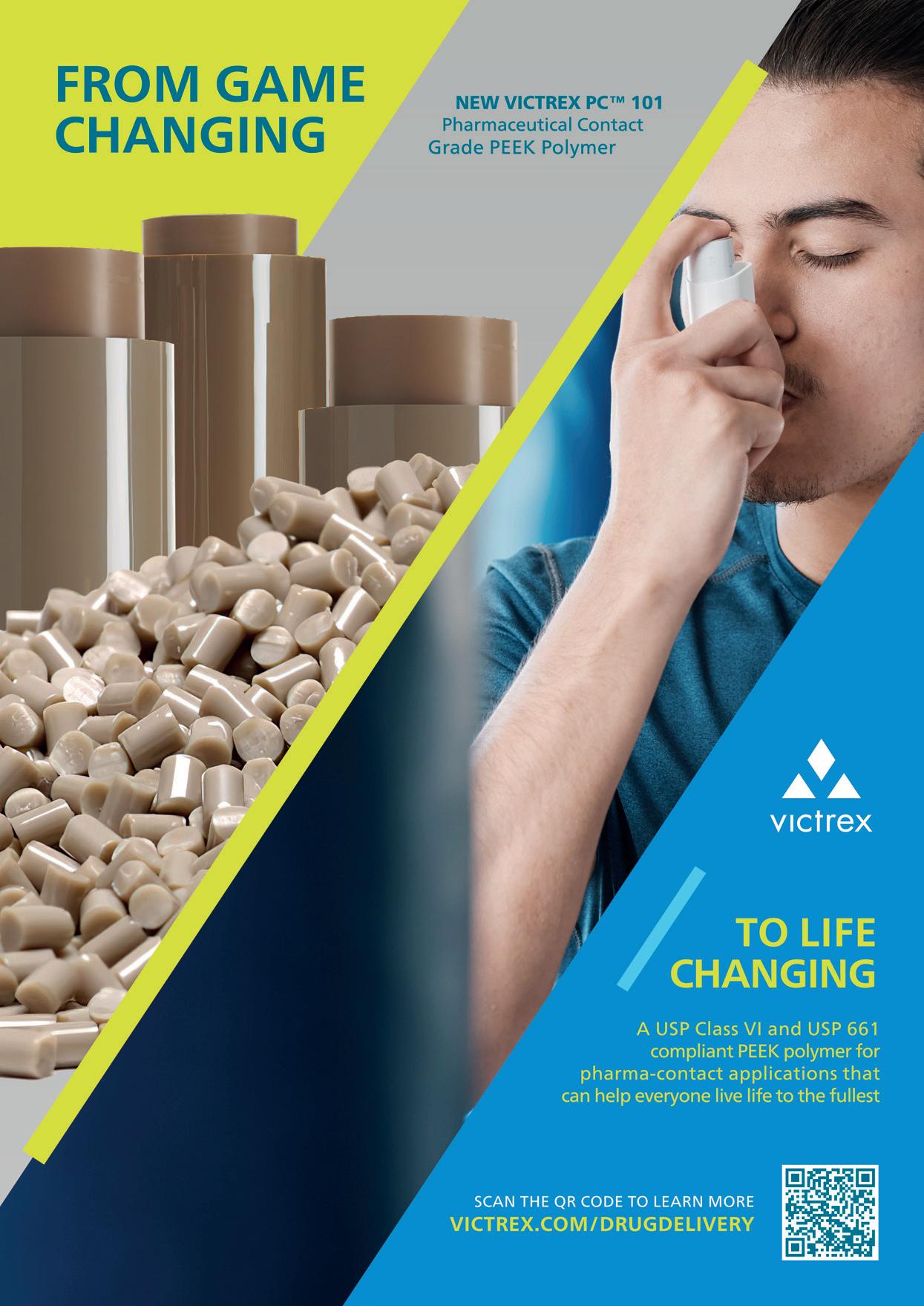
Here, Shai Assia, Head of Medical Devices at Clexio Biosciences, explores the intricate challenge of designing drug-device combination products for self-administration by lay users without medical expertise. Focusing on targeted nasal drug delivery devices, Mr Assia highlights the importance of overcoming user misconceptions and addresses the complexities of assessing usability when users lack prior experience with a unique mode of action.
As advancements in medical treatments continue, targeted nasal drug delivery devices are emerging as an innovative solution for various medical conditions. However, how can their practicality and user-friendliness be effectively evaluated if no one has ever experienced them before? Chances are, that even if someone has never used an inhaler or autoinjector themselves, they have at least seen one or know someone that has. But what is the point of reference for targeted deep intranasal spraying?
From the patient’s perspective, the device constituent of the drug-device combination adds a new parameter to the treatment –the product’s usability. A device needs to be operated, and operated properly.
Delving deeper into the heightened complexity of self-administered devices, the target users are ordinary individuals without a medical background or extensive technical knowledge. They seek simplicity and intuitiveness in their devices, as complex interfaces could hinder their ability to adhere to prescribed treatments.
Despite these complexities, selfadministration has many benefits, including putting the control in the hands of the patients, empowering them to take an
“From
the patient’s perspective, the device constituent of the drug-device combination adds a new parameter to the treatment –the product’s usability.”
active role in their own treatment and potentially improving compliance. It is available to them wherever and whenever they need it, without having to go to the clinic, wait in line or rely on someone else. All this, of course, assumes that they know how to use it.
Here lies the challenge in ensuring that the device is sufficiently foolproof to be intuitive to new users and experienced ones alike, as not all may relate to the same previously familiar mental model.
Put simply, a mental model is a description of one’s thought process relating to a particular subject. It uses our intuitive perception to associate the placement of

Shai Assia Head of Medical Device Development T: +972 53 3326143 E: shai.assia@clexio.com
Clexio Biosciences Ltd 17th Yegi’a Kapayim Petach Tikva 4913000 Israel www.clexio.com

a subject in the real world and relate it to familiar surroundings. Note the key word “perception” – mental models are based on beliefs, not facts; being subject to personal interpretation, beliefs can be misleading.
Clexio Biosciences is developing SPRACISE, the device component of a drug-device delivery system for the treatment of acute cluster headaches by precise deep intranasal spraying.
On top of the challenges already mentioned, SPRACISE faced another obstacle – its indication. Cluster headache is a neurological disorder characterised by recurrent severe headaches. Cluster headaches often go undiagnosed, as most of the general population is unfamiliar with the condition, which affects about 0.1% of people worldwide, despite being referred to as the “most severe pain known to man”.
Clexio’s SPRACISE targets a specific nerve pathway at the sphenopalatine ganglion (SPG), as shown in Figure 1. While such neural modulation has been performed for over 100 years,1 to date, the procedures have only been performed by trained healthcare professionals (HCPs). Due to the explosive nature of cluster headache attacks and the frequency of the attacks during the cluster period, it is reasonable for patients to receive the treatment they desperately need outside of the clinic and right at the onset of an attack.
Since the treatment is used as a relief medication, it must be within reach at all
“Offering a selfadministered SPG-block treatment provides patients with independence and can greatly improve their quality of life.”
times. Offering a self-administered SPGblock treatment provides patients with independence and can greatly improve their quality of life.
This intranasal device involves a new and unusual use case for which lay users have no previous experience, leaving them to make up their own set of beliefs about the nasal environment. It is therefore not just the lack of any familiar mental model that makes the design challenging, but also the need to overcome existing incorrect mental models. For instance, many people perceive the nose as going upwards rather than backwards, making patient education crucial to ensure proper usability.
An interesting example is the covid-19 pandemic leading to a greater awareness of nasal anatomy in respect to respiratory illnesses. Antigen tests for covid-19, which often involved a nasal swab to collect a sample from the back of the nasal cavity, may have had different effects on people’s perceptions of nasal applicators. For some, the unpleasant experience may have led to reluctancy towards nasal applicators in general. For others, the experience may have been less painful than anticipated and more acceptable.
However, that is not the only change covid-19 introduced in this context. The pandemic overwhelmed the alreadybusy healthcare services and made it difficult to give (or receive) in-person treatment, demonstrating just how valuable self-administration is for medication adherence. At the same time, it also created a new standard of care, giving society a nudge forward into the connected and digital era. Tech-averse patients (predominantly in the older population) became accustomed to using remote tools for daily matters. The normalisation of telemedicine, for example, has not only enabled but also created an expectation that more forms of treatment will become available for home-based care as a standard practice.
Several key points should be considered in the design and development process to improve the overall user experience and appropriate usage of a novel device.
The best way to learn about users’ preferences is to ask them directly. However, medical devices are not typical consumer products, and the term “users” may refer to a few different stakeholders – patients, caregivers, general practitioners or clinical experts – all of which have relevant needs. It is important to keep in mind that user experiences are subjective, and each may emphasise different product features as the most important. Clinicians who treat many patients will assist in understanding the common pain points for many patients and can assist in discerning the exception from the rule. It is therefore helpful to include a wide range of users in surveys and interviews, and group them into fields of expertise.
Interviewing users is obvious advice, but it is important to remember that common sense is not always common practice. Many people do not listen with the intention to learn, but rather with the intention to reply. Try this little trick: embrace the awkward silence! Ask a question, listen to the answer, then say nothing. Stare blankly into the eyes of the person in front as if expecting them to continue their sentence. More often than not, they will. By planning not to speak at the first opportunity, the interviewer can resist the urge to drift off and remain a focused listener.
The interviewee will, in turn, fill the void by further elaborating their point. It is a winwin in the game of active listening.
With the information gathered and the design input requirements clearly defined, it is time to move on to the design process itself. Prioritise the wish-list of product features, with the aim of keeping it as simple as possible – more is not always better. The product attributes need to be fit for purpose, otherwise the design reaches diminishing returns.
Ergonomics are often overlooked but have a role to play in self-administered drug delivery systems. Best practices can be found online from principles of hand-held devices and grip indicators to features that provide real-time feedback of proper use. Sophistication in device designs can also mean becoming more forgiving to inevitable human error.
The direct approach to user interviewing is the simplest one, but beware of its caveats. As previously mentioned, mental models can be misleading. One might claim that they understood how to use a device (and in their mind, they do believe this to be true), when in fact they are not operating it correctly. For this reason, it is essential for a trained professional to observe users and pick-up on any non-verbal cues.
Throughout the development of SPRACISE, formative human factors studies (HFSs) were structured in different ways, depending on the main objective at each stage of development.
• Preliminary user preferences: Focusing on product presentation. The test subjects included a mixture of HCPs and patients, who were given low-fidelity mock-ups of widely different design concepts, and were asked for feedback on comfort, intuitiveness and level of trust.
• Design concepts down-selection: After further narrowing of design features, representative semi-functional prototypes of the leading concepts were handed to users to practice the envisioned usesteps on an anatomical model. Users were asked to operate the device on the model, as if performed on themselves, to mimic the device handling, while cameras were used to record close-ups of the administration. The outcome of this HFS was a single design concept selection for detailed development.

“Determining spray deposition in the nasal cavity is challenging due to anatomical variability, variations in airflow patterns and complex fluid dynamics.”
• Usability assessment : With the chosen design concept developed into a functional prototype, users were given the opportunity to practice selfadministration and simulate as many real functionalities as possible. The prototype did not contain any active drug, but did include functional features, as well as tactile and audio feedback. This level of active engagement requires the developer to conduct a risk assessment and ethics review beforehand to ensure the safety of participants.
It is important that HFS participants are recruited from the actual patient population. Especially with a condition as severe as cluster headaches – only those who suffer from the condition can truly represent real users (Figure 2).
Determining spray deposition in the nasal cavity is challenging due to anatomical variability, variations in airflow patterns and complex fluid dynamics. Additionally, the nasal cavity presents numerous obstacles along the fluid pathway; nasal
hairs, turbinate structures and mucosal surfaces can alter the spray’s trajectory and hinder its deposition in specific areas. This makes it difficult to anticipate where the spray will end up and how it will spread on the target.
Artificial 3D-models that are anatomically accurate representations of the target organ can help product design engineers visualise how the device interacts with the subject and empirically assess what interfaces can improve ergonomics, functionality and usability. This empirical approach allows for a more direct and practical assessment of spray performance, considering the actual variability seen in individuals (Figure 3).
Another test model can be based on human cadaver organs, which are more realistic than the 3D models and can be particularly useful when tissue surface plays a significant role and live animal models cannot replicate the relevant topography. While the primary aim of these tests is to assess the device’s technical performance, they also provide valuable insights into its usability and ergonomics. For instance, the ease of device actuation, the force required for operation and the comfort of the

device’s interface with the nasal anatomy can be inferred from these models. These factors are critical for ensuring that the device can be used correctly and comfortably by the intended patient population, including individuals with varying levels of manual dexterity or strength, such as the elderly or those with disabilities.
For patients to take control over their own treatment regime, they must be motivated to do so, as well as educated on the condition, treatment and benefits to them. Providers should not take patients’ co-operation for granted simply because compliance is within their own interest. Training aids include:
• Instructions for use (IFU): One of the key nuances in developing training materials for such products lies in striking a balance between simplicity and detail. While it is essential to provide users with clear, step-by-step instructions, it is equally important not to overwhelm
them with excessive information. Human factors engineering (HFE) experts employ user-centric design principles to create training materials that prioritise the most critical information while minimising cognitive load.
• Instructional videos : Considering the diverse range of users who may interact with these products, training materials must be inclusive and accessible to individuals with varying levels of health literacy and technological proficiency. This may involve employing visual aids, plain language instructions and multimedia formats to enhance comprehension and retention. To help patients comprehend SPRACISE’s delivery method, Clexio combined the
use of a live actor (more relatable) and animation of the internal organ (allowing an “inside” view).
• One-on-one guidance : Useful to evaluate the learning curve and gather unforeseen insights. While printed or digital instructions serve as valuable references, personalised guidance allows for real-time clarification of doubts and tailored assistance based on the individual’s unique needs and abilities. This personalised approach not only fosters a deeper understanding of the product and its usage, but also instils confidence in the user, reducing the likelihood of errors or misuse.
The training material, as well as its effectiveness, could be assessed during one of the HFSs. It is useful to prepare an initial IFU during the early concept design stage, based on the product’s storyboard with illustrated use steps.
The burden on healthcare systems never seems to reduce. As the population continues to age, healthcare services will always have their hands full. Putting treatment in the hands of patients frees their dependence on external factors, and healthcare resources can once again be allocated in new directions.
In the absence of a familiar mental model, HFE plays an ever-more critical role in the development of self-administered products, as it helps bridging the gap between the user’s expectations and the device’s capabilities. By taking into account the needs and limitations of the end-
“Putting
treatment in the hands of patients frees their dependence on external factors, and healthcare resources can once again be allocated in new directions.”
users, manufacturers can create products that are safe, effective and user-friendly. Through iterative testing and evaluation, designers can identify and address potential use errors to ensure that the product is intuitive and easy to use.
Ultimately, a well-designed selfadministered drug-device combination product not only enhances patient adherence but can potentially improve clinical outcomes by ensuring correct operation. In this light, developers of truly innovative products must tailor HFE practices to the particular challenges that novice users may face.
Clexio Biosciences is a multi-asset, central nervous system-first clinical stage pharmaceutical company with a broad and growing pipeline, dedicated to developing novel therapies for patients suffering from neurological and psychiatric conditions. One of the company’s driving principles is to invent new therapeutic modalities and bring them quickly from an idea to proof of concept and then to full clinical development, identifying points of convergence between validated mechanisms of action and technology to generate new patient-centric possibilities.
Shai Assia is Head of Medical Device Development at Clexio Biosciences. He is a product development leader with more than 15 years of experience over a wide range of responsibilities and organisations. Mr Assia leads the medical device design, development and manufacturing for novel combination products and drug delivery platforms. He holds a BSc in Bio-Medical Engineering from Tel Aviv University, Israel, as well as an MSc in Mechanical Engineering and MBA from the Massachusetts Institute of Technology (MA, US), where he received the Leaders for Global Operations Fellowship.
1. Sluder G, “The role of the sphenopalatine ganglion in nasal headaches”. N Y State J Med, 1908, Vol 27, pp 8–13.
BIBLIOGRAPHY
1. Towns JK, “Human factors studies for injectable combination products: from planning to reporting”.
PDA J Pharm Sci Technol, 2014, Vol 68(4), pp 347–361.
2. Bailey R, “Foundational human factors engineering concepts for the design of combination products”. Med Device Online, Feb 2024.
3. Strochlic A, Limpens Y, Larson K, “An introduction to FDA’s Human Factors Engineering Requirements for Drug-Device Combination Products”. Pharma Focus Asia, 2023
4. “Guidance on applying human factors to medical devices”. UK Medicines and Healthcare products Regulatory Agency, Sep 2019.

















In this article, Alain Regard, Technology Product Manager, Raphaële Audibert, Marketing Category Manager – Ear Nose Throat, and Audrey Chandra, Marketing Category Manager, all at Nemera, discuss the advantages of nasal delivery and highlight the challenges of the nose-to-brain pathways.
Injectable forms, including complex molecules such as biologics, have been the standard go-to therapies for decades. However, the overall industry paradigm is shifting to less-invasive delivery routes to allow self-administration in a homecare setting, a shift that occasionally necessitates drug repurposing.
The nasal cavities are highly vascularised and innervated anatomical structures, which present an interesting opportunity to deliver rapid onset therapies with
requires no intervention from healthcare professionals. Nasal administration offers superior bioavailability by bypassing the hepatic first-pass effect often encountered with oral medication.
Nasal devices are needle-free, which fosters patient acceptance, leading to positive therapy outcomes following improved patient adherence and compliance.
Topical therapies still dominate the nasal market to treat allergic rhinitis, sinusitis and nasal congestion. Allergic rhinitis is mostly seasonal and usually relieved by nasal sprays containing topical-acting medications (Figure 1).
1: Nasal cavity zone of interest to address systemic and direct nose-to-brain delivery.

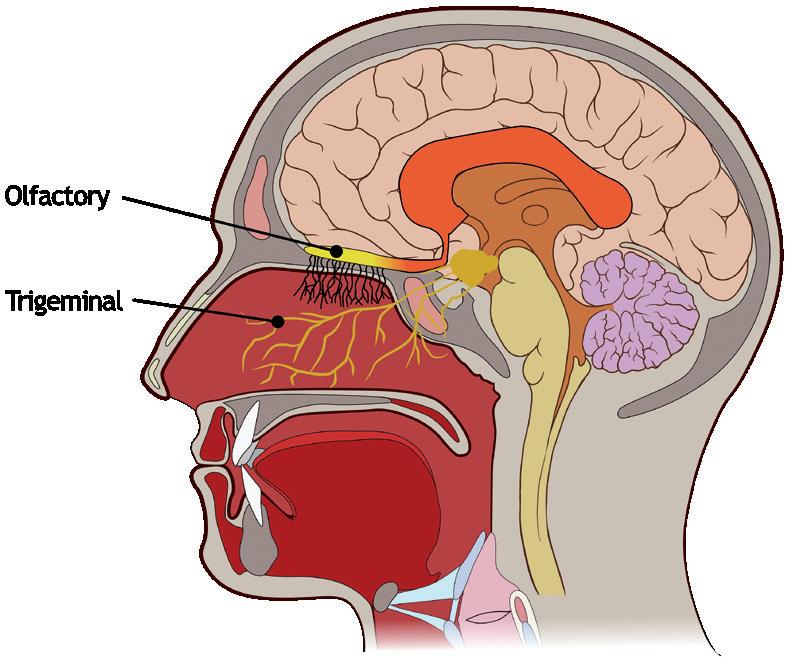
Alain Regard
Technology Product Manager E: alain.regard@nemera.net
Raphaële Audibert
Marketing Category Manager – Ear Nose Throat E: raphaele.audibert@nemera.net
Audrey Chandra
Marketing Category Manager E: audrey.chandra@nemera.net
Nemera 63 Avenue Tony Garnier 69007 Lyon France
www.nemera.net
“Recently, there has been growing interest and further exploration in nasal delivery for systemic-acting drugs by targeting nasal turbinates.”
Recently, there has been growing interest and further exploration in nasal delivery for systemic-acting drugs by targeting nasal turbinates. Highly vascularised turbinates occupy a large surface area of the nasal mucosa, offering a convenient pathway for systemic delivery. Several drug pipelines are targeting diverse therapeutic areas, driving demand for marketed products, particularly in emergency and crisis contexts, often using unit-dose sprays.
Another promising route currently under exploration is the nose-to-brain pathway, which presents opportunities for efficient drug delivery, particularly for central nervous system (CNS) therapies. Traditional treatments for brain disorders are often very invasive, such as subcutaneous or intravenous injections in a medicalised environment targeting the brain and spine. These procedures are often linked with significant side effects adversely affecting patients’ quality of life.
Some CNS therapies are currently administered intranasally to treat potent drug overdoses or migraines (such as naloxone, zolmitriptan, etc) and distributed to the brain via the blood after absorption in the turbinates. Anatomically, the brain is protected by the blood-brain barrier (BBB), which prevents > 95% of molecules entering the CNS through the bloodstream. The ability of certain drugs to permeate the BBB is impeded by their physicochemical properties and only affects small molecules. A limited number of drug candidates can, therefore, enter the brain by crossing the BBB.
Direct intranasal brain delivery avoids the BBB and requires lower doses. This approach reduces toxicity and minimises offtarget effects as the medications mitigate the first-pass metabolism. This path may also allow the delivery of large molecules into the brain. Targeting olfactory and trigeminal nerves through the nasal cavity may be the best route for direct brain delivery. Olfactory nerves are the preferred targeted site as they are concentrated in a small area. Trigeminal nerves are spread over the cavity, and targeting them would mean coating the entire nasal cavity with the formulation, leading to the risk of systemic absorption.

The nose physiology should be considered when developing drug formulations for the direct nose-to-brain pathway as challenges may be encountered:
1. Formulation Development: The limited volume of formulation that can be applied to the nose, mucociliary clearance, the presence of the mucosal layer and local enzymes are some of the factors that can hamper drug absorption through the intranasal route. Metabolic enzymes present in the olfactory mucosa must also be considered when designing a formulation for the nose-to-brain route. Consequently, intranasal formulations must be composed of biocompatible and odourless excipients and avoid rapid elimination due to mucociliary clearance and/ or enzymatic degradation. Furthermore, they must present appropriate viscosity, physiological tonicity and a pH compatible with the nasal mucosa.1,2
Thus, different strategies have been investigated to overcome the challenges of this route of administration. Most of these approaches aimed to enhance molecular absorption and permeability by increasing the time in which the dosage form remains in the nasal mucosa and promoting drug concentration in the CNS.3 These strategies include the use of permeation and absorption enhancers, cell-penetrating molecules, mucoadhesive and mucopenetrating agents, enzyme inhibitors, hydrogel systems, nanoparticulate drug delivery systems or a combination of different strategies.
2. Anatomy Gaps and Variability: In addition to formulation challenges, major anatomical gaps between animal models used in preclinical studies and real human anatomy raise further challenges to mimic relative size, surface–volume ratio and the extent of the innervation network for relevant animal-to-human translation.
Nasal cavity anatomy is subject to interpatient variability, with additional contributing factors such an ethnicity, gender and age. Structural or inflammatory nasal pathologies can also generate some obstruction, and it is important to consider these possibilities when developing and testing new treatments.
3. Olfactory Cleft Target and Drug Efficacy Quantification: The olfactory region represents a small surface area, around 5 cm2 (3,000 cm2 including the microvilli), and is located very deep into the nose, which is extremely difficult to reach with conventional nasal spray devices.4 Monitoring pharmacokinetics in the bloodstream is relatively straightforward; however, quantifying the amount of drug reaching the cerebrospinal fluid or brain tissues in humans remains a challenge.
Nemera is developing a jet-based nasal device that addresses several of the aforementioned challenges. The jet nozzle has been designed to release a narrow and steady liquid flow, as shown in Figure 2.
The tested jet nozzle prototype configurations show promise in delivering liquid formulations to the olfactory area in a targeted manner. Several design configurations have demonstrated high deposition rates in the olfactory area, exceeding 50% on two different nasal casts (Figure 3).

“Further studies are needed to fully characterise the deposition performance of such devices while considering the wide interpatient variability of the nasal anatomy.”
In addition, further studies are needed to fully characterise the deposition performance of such devices while considering the wide interpatient variability of the nasal anatomy. Studying the user/patient interface to ensure the correct usage steps for drug efficacy is essential. For instance, designing an easy-to-use device to reduce administration variability includes nozzle tip insertion depth, orientation of the device, patient position during administration, etc.
Treating CNS pathologies via non-invasive routes, such as the direct nose-to-brain pathway, offers a promising solution from the patient’s perspective as it can reduce the discomfort associated with traditional injection therapies while also limiting the systemic side effects.
Researchers are continuously looking into opportunities to develop both a device and adequate formulations that may target the olfactory cleft to demonstrate drug efficacy and treatment feasibility.
Nemera’s long-standing expertise in developing and manufacturing complex nasal devices encourages the company to continue its efforts in making the drug delivery device solutions of tomorrow better. Nemera believes it is critical to interact with industry leaders and peers to ensure the success of its innovations. It is essential to collaborate and reflect to achieve solid outcomes with neurology and ear, nose and throat (ENT) specialists for complex novel therapies, such as nose-to-brain delivery.5
Nemera specialises in streamlining the integration of the customer’s selected device and drug product to accelerate the development of the combination product and speed to market. Nemera’s comprehensive services cover a wide range of critical areas including:
1. Analytical services and design verification: customised laboratory and testing services for a specific device.
2. Human factors and user experience management: safe and effective devices surrounded by assets to drive engagement.
3. Regulatory strategy and submission authoring: accelerating the path to approval.
4. Drug–device assembly and packaging support: managing the combination product.
Nemera’s expertise enables pharma companies to confidently navigate the complexities of a combination product knowing there is a trusted partner by their side to accelerate the process. With long-standing experience in developing and manufacturing an extensive range of multidose nasal spray pumps, commercialised worldwide for diverse therapeutic areas and applications, Nemera is the ideal partner for direct nose-to-brain projects. To address systemic-acting drugs with a unit-dose spray, the company’s UniSpray system is now commercially available and targets emergency and crisis treatments.
As a world-leading drug delivery device solutions provider, Nemera’s purpose of putting patients first enables it to design and manufacture devices that maximise treatment efficacy. Nemera is a holistic partner and helps its customers succeed in the sprint to market with their combination products. From early device strategy to state-of-the-art manufacturing, Nemera is committed to the highest quality standards. Agile and open-minded, Nemera works with its customers as colleagues. Together, they go the extra mile to fulfil their mission.
1. Costa CP et al, “Intranasal delivery of nanostructured lipid carriers, solid lipid nanoparticles and nanoemulsions: a current overview of in vivo studies”. Acta Pharm Sin B, 2021, Vol 11(4), pp 925–940.
2. Costa C et al, “Nose-to-brain delivery of lipid-based nanosystems for epileptic seizures and anxiety crisis”.
J Control Release, 2019, Vol 295, pp 187–200.
3. Gao H, “Progress and perspectives on targeting nanoparticles for brain drug delivery”. Acta Pharm Sin B, 2016, Vol 6, pp 268–286.
4. Gizurarson S, “Anatomical and histological factors affecting intranasal drug and vaccine deliver”. Curr Drug Deliv, 2012, Vol 9(6), pp 566–582.
5. Radulesco T, Serrano E, Michel J, “The Role of Ear, Nose, and Throat Specialists in the Nose-to-Brain Pathway”. JAMA Otolaryngol Head Neck Surg, 2023, Vol 149(9), pp 769–770.



Alain Regard is Technology Product Manager at Nemera. Mr Regard graduated in Polymer Engineering and Processing from Ecole Supérieure de Plasturgie (ESP) in Oyonnax, France. After gaining extensive experience in design and development in the automotive industry, he joined Nemera in 2010 as Product Development Leader. Mr Regard is currently one of the key technical experts at Nemera, and leads innovation in the field of ENT drug delivery. He is responsible for several of Nemera’s own intellectual property projects, as well as working on the development of key areas of expertise.
Raphaële Audibert is the Marketing Category Manager for the ENT administration route at Nemera. She holds a Biomedical Engineering degree from ISIFC (Besançon, France) and has five years of experience in the medical industry. Ms Audibert joined Nemera in 2016, leading the inhalation and dermal departments in the marketing team before moving to the ENT department. Ms Audibert manages both the existing and future franchise portfolio, building and leading the franchise strategies in line with market demand and evolution.
Audrey Chandra is the Marketing Category Manager at Nemera. Ms Chandra graduated from the Faculty of Medicine Universitas Atma Jaya Indonesia and pursued her master’s degree in Strategy and Business Development at Toulouse School of Management, France. With her dual competence, she leads the dermal department at Nemera and provides strategic support for various other targeted marketing projects for the ENT and parenteral administration routes. She is also involved in diverse content management, along with communication activities co-ordination.



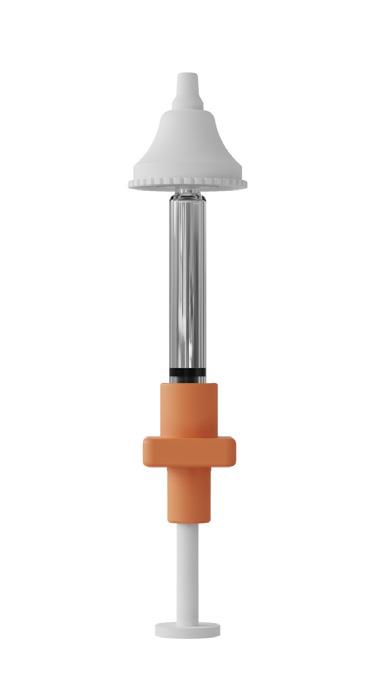
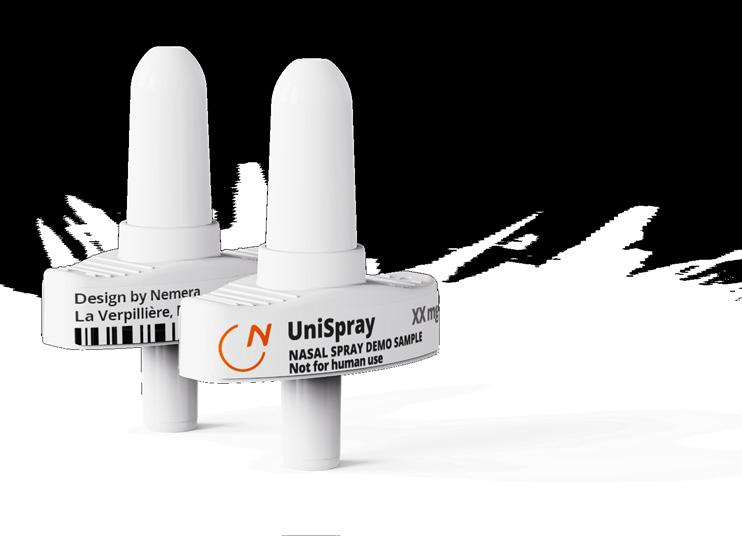
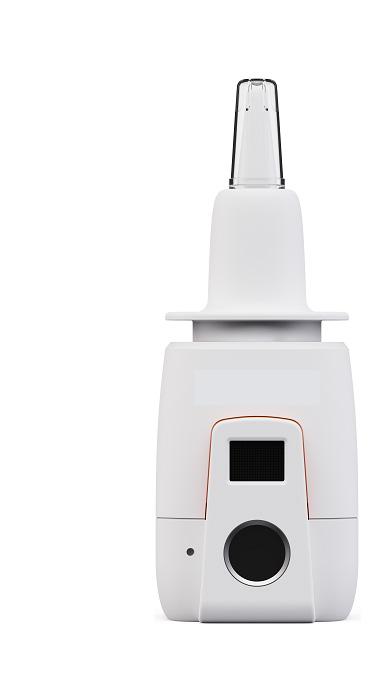
In this interview, Julie Suman discusses nasal casts, their development, applications and significance for nasal drug product development.

Julie Suman, PhD, is the Vice-President of Scientific Affairs for Aptar Pharma. Dr Suman holds a BSc in Pharmacy and a PhD in Pharmaceutical Sciences. She is co-editor for Respiratory Drug Delivery Proceedings, and an Affiliate Assistant Professor in the Department of Pharmaceutics at Virginia Commonwealth University (VA, US). A Past-Chair of the AAPS Inhalation Technology Focus Group, Dr Suman has published in several peer-reviewed journals and presented at numerous international meetings.
QCan you provide an overview of the historical development and evolution of nasal casts? What were the primary motivations and objectives behind their creation?
AThe first nasal casts were modelled directly from cadavers – a logical strategy. The most well-known of these is probably the Koken Co silicone cast, which is still commercially available. It should be noted that casts made from cadavers have a more patent nasal cavity and are not the best representation for studies. Nonetheless, over the years, many such casts have been referenced in the literature, typically developed in-house by individual research groups or companies. The introduction of 3D printing has made it possible to manufacture nasal casts from
images of living patients or volunteers, which is the approach that is now both favoured and increasingly accessible. Computer tomography (CT) or magnetic resonance imaging (MRI) images gathered from the patient population of interest are typically the starting point; beyond which, techniques such as stereolithography enable realisation of a nasal cast with ever greater precision, from a plastic or polymer of choice.
Nasal cast use dates back to the 1990s, and the goal from the outset was simply to gain a better understanding of where in the nose a drug might deposit and how that deposition might vary between and across different patient cohorts. Teams such as that led by Dr Richard Dalby, Professor in the Department of Pharmaceutical Sciences at the University of Maryland School of Pharmacy (MD, US), pioneered the use of
“The introduction of 3D printing has made it possible to manufacture nasal casts from images of living patients or volunteers, which is the approach that is now both favoured and increasingly accessible.”
nasal casts to visualise spray deposition for educative purposes, as well as for product development. The use of coloured sprays and tests where casts have been coated with products such as SarGel®, a white paste that turns purple when in contact with water, produce effects that are both visually arresting and informative; nasal casts have delivered some excellent images for marketing purposes over the years!
QHow are nasal casts used in nasal deposition studies, and what advantages do they offer over alternative methods for studying nasal deposition?
ACurrent regulatory guidance for nasal drug products specifies in vitro techniques that usefully quantify important metrics, such as particle size, spray pattern and plume geometry. These metrics relate to nasal deposition but do not measure it directly.
Direct measurement is possible via in vivo testing with techniques such as a gamma scintigraphy, or using a CT or positron emission tomography (PET) scanner to track the distribution of a radioactive tracer. However, such testing is relatively expensive, time-consuming and inaccessible. Nasal casts essentially bridge the gap between these two approaches. Using them enables the direct study of nasal deposition in the lab, with no requirement to recruit volunteers (and obtain the necessary consent) or have access to CT and PET scanners, which are in near constant clinical use at many hospitals (Figure 1).
QHow do you select a nasal cast? And what about validation?
AIt is important to select a nasal cast that is representative of the patient population that you are targeting –paediatric, adult or geriatric. The physiology of the nasal cavity varies considerably with factors such as age, gender, ethnicity and disease state, so having a cast that is as representative as possible is important. Currently, there is no standardisation for nasal casts, so careful selection and validation are critical.
The other thing to consider is that nasal casts are often sectioned, so make sure you can access the area of the nasal cavity that you are specifically interested in. This might be more difficult if you’re targeting a small region, such as the olfactory region, as is often the case for those working on nose-to-brain drug delivery.
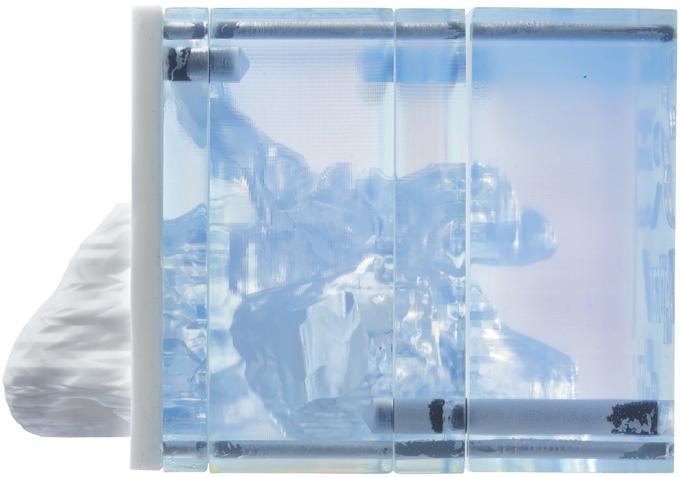
Validation against in vivo data is essential to ensure the relevance of your model and give it weight. Using models that are already validated, via academic collaboration or service providers, can therefore prove both cost and time effective. For example, Aptar Pharma offers access to its Aeronose™ nasal cast, which was developed by Aptar Pharma in collaboration with the University of Tours (France) and has already been validated with both liquid sprays and nasal powders (Figure 2).
QCould you elaborate on the role of nasal casts in predicting in vivo deposition patterns? What insights do they offer that are crucial for understanding how particles or drugs interact with the nasal cavity?
ALooking across different areas of nasal drug product development activities can help to elucidate the need and scope for application for nasal casts; our collective motivation for developing a better understanding of in vivo deposition behaviour is growing. For example, for those working on generics, nasal cast studies inform the closer matching of drug delivery performance and can add further weight to claims of bioequivalence, as exemplified by the contested approval of Sandoz’s (Basel, Switzerland) Mometasone Furoate Sandoz (mometasone furoate) nasal spray, which was supported in the EU by nasal cast data. Currently, the US FDA does not use nasal cast data to make regulatory decisions; it is considered part of the development package.
For systemics, on the other hand, targeted deposition may be essential for therapeutic efficacy. We are some way from robustly understanding where – or indeed how – to target nasal drug delivery to optimise clinical efficacy for different therapies; we still need better nasal deposition data to help us to build the knowledge base. Currently, nasal casts don’t address mucociliary clearance, which could impact absorption.
“For those working on generics, nasal cast studies inform the closer matching of drug delivery performance and can add further weight to claims of bioequivalence.”
However, nasal casts are good first step and potentially a cost- and time-efficient way of obtaining these data.
Focusing specifically on vaccines, these are notably of interest for paediatrics, so we need to understand how deposition is influenced by physiology as it changes throughout a child’s early years. Last, but not least, realistic deposition data is essential for the estimation of off-target delivery to the lungs and the associated safety risks.
QWhat challenges and limitations impact the faithful reproduction of nasal anatomy?
AA well-recognised problem with nasal casts developed from cadavers is that blood loss and tissue retraction


substantially alter the geometry of the nasal cavity. Such casts are routinely reported as having overly wide nasal passageways and large nasal volumes, relative to live subjects, and can consequently produce results that are poorly representative of in vivo behaviour.
While, with modern techniques, more representative casts can be produced, there are still limitations. It is not straightforward to translate a CT or MRI scan into a 3D print, though know-how is improving, and with a high-performance CT/MRI scanner and 3D printer, the nasal anatomy can now be reproduced in fine detail. That said, material choice can be tricky, with most casts significantly removed from the flexibility and surface texture of human anatomies. Truly faithful re-creation of the nasal cavity is always going to be complex, given its highly convoluted geometry and many nooks and crannies.
QIn what practical applications are nasal casts most useful?
ANasal casts are a great R&D tool for tasks such as ranking formulations or refining device design. They can help you to better decide which candidate formulation is most likely to be successful and to understand how to improve a device to target a specific deposition profile or achieve parity between a reference and test product. Such tests have been helpful, for example, for exploring the regional
deposition disparities associated with liquid and dry powder nasal delivery, adding to the weight of evidence that powders offer enhanced delivery to the olfactory region (Figure 3).
Instructions for nasal product use tend to be relatively vague but, with nasal casts, we can investigate the effect of patientuse parameters, such as spray orientation, insertion depth and inspiratory flow rate. We can use these results to offer more definitive advice on product use and assess the benefits of design features such as nasal guides. We can also assess performance for different patient groups, including paediatrics of different ages, provided we have appropriate casts.
The bottom line is that nasal cast experiments are quick and relatively easy. With a validated cast, stepping through a battery of alternative options to determine the best path forwards is straightforward and inexpensive and can really help to accelerate progress.
QCan you summarise the key strengths and weaknesses associated with using nasal casts as research tools? Are there any ongoing innovations or developments that will address them?
AThe primary value of nasal casts lies in their utility for rapid screening, for education and for device and formulation selection. We know that nasal casts can provide a good prediction of in

“The primary value of nasal casts lies in their utility for rapid screening, for education and for device and formulation
selection.”
vivo behaviour, and that they can therefore provide clinically relevant information for the population of physiologically based pharmacokinetic (PBPK) models. The ability to visualise spray deposition is also extremely valuable.
With respect to limitations, individual nasal casts are unable to capture intersubject differences in anatomy that may be relevant to therapeutic efficacy. They are also static devices with no ability to mimic the dynamic behaviour of the nose with respect to the changes in geometry associated with inhalation and exhalation and, critically, the effect of mucociliary clearance. The other key drawback is that, in the absence of standardisation, comparing results obtained with different nasal casts or across multiple labs is not feasible.
Regulatory requirement would be a game changer for nasal cast use and would likely help to address the issue of standardisation. FDA grants to Virginia Commonwealth University to develop adult and paediatric nasal models to capture nasal deposition profiles signals an awareness of this issue, and views from a US Pharmacopoeia expert panel have now been published as well. These highlight the potential to use nasal casts for the direct assessment of in vivo nasal deposition and to more realistically assess the risk of off-target delivery to the lung, concluding with a recommendation to examine nasal casts for regulatory use.
Standard nasal casts for specific patient populations made using prescribed methods would allow inter-study, interlab data comparison and support more rapid development of nasal drug delivery
“Regulatory requirement would be a game changer for nasal cast use and would likely help to address the issue of standardisation.”
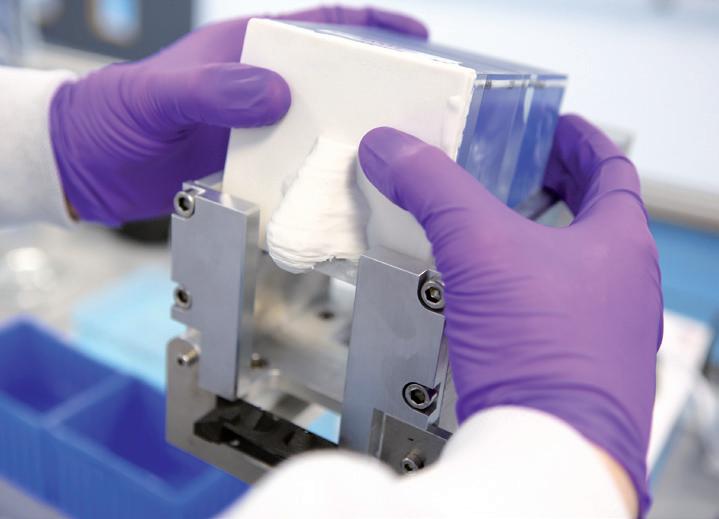
knowledge. Such developments, in combination with steadily improving in silico skills, notably with respect to PBPK modelling, could reduce our reliance on animal testing – a major gain. The development of representative non-human primate nasal casts would be an important step in this regard (Figure 4).
There are also moves to further enhance the clinical relevance of nasal casts. The use of artificial mucus and coatings, humidification and flexible nose pieces are noteworthy, and we’ve also seen researchers combine in vitro RPMI 2650 nasal cell culture models into 3D models to study permeation alongside deposition.
I’ll be really interested to see where we’re at with nasal casts in 5 to 10 years. Growing interest in intranasal drug delivery, the potential for regulatory change and rapidly advancing PBPK modelling skills could combine to substantially impact how we carry out in vitro testing and its value. I’m sure nasal casts will become increasingly routine as we work out how to minimise the cost and time associated with developing and commercialising a steadily diversifying array of nasal drug products.
For pharma customers worldwide, Aptar Pharma is the go-to drug delivery partner, providing innovative drug delivery solutions across a wide range of delivery routes, including nasal, pulmonary, ophthalmic, dermal and injectables. Aptar Pharma Services provides early stage to commercialisation support to accelerate and de-risk the development journey. With a strong focus on innovation, Aptar Pharma is leading the way in developing connected devices to deliver digital medicines. With a global manufacturing footprint of 15 GMP sites, Aptar Pharma provides securityof-supply and local support to customers. Aptar Pharma is part of AptarGroup, Inc., a global leader in the design and manufacturing of a broad range of drug delivery, consumer product dispensing and active material science solutions.
Dr Julie Suman
Vice-President, Scientific Affairs
T: +1 410 455 5909
E: julie.suman@aptar.com
Aptar Pharma
250 North Route 303 Congers New York 10920 United States
www.aptar.com/pharmaceutical

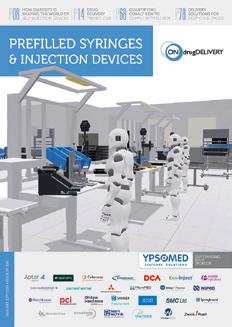





In this article, Nia Stevens, PhD, Consultant Mechanical Engineer at Team Consulting, discusses the potential benefits of developing vaccines for intranasal administration with a suitable drug delivery device, as well as the challenges associated with this delivery route.
Over the past couple of years, there has been considerable interest in developing intranasal covid-19 vaccines, with several in clinical development globally and a small number approved in countries such as India and Russia. New data have shown the potential for greater efficacy with an intranasally delivered covid-19 vaccine, compared with the standard delivery route of intramuscular injection.
This trend is not surprising, considering that covid-19 is a respiratory tract infection, and intranasal vaccination provides targeted local delivery to the upper respiratory airway mucosa. Building immunity directly in the nasal mucosa also offers better potential to prevent disease transmission, as the nasopharynx is the body’s first encounter with infectious aerosols. Early clinical data for intranasal vaccines suggest that they also avoid the side-effects, such as “flu symptoms”, associated with existing covid-19 vaccines.
This growth in interest for nasal covid19 vaccine delivery follows a wider trend of intranasal flu vaccine development. One vaccine, FluMist/Fluenz Tetra (AstraZeneca), has been available to patients in the US and EU markets for several years now. If a covid-19 intranasal vaccine is successful in reducing transmission rates, where the current intramuscular vaccines cannot, this may become the delivery route of choice in the future of vaccine development, particularly for respiratory tract infections.
There are several other key benefits of intranasal vaccination, including it being a pain-free delivery option that can be administered at home. Providing an at-home administration option for vaccines would help to avoid exposing patients to the risks of sharing a closed space with other potentially infected people, among the other downsides associated with attending health clinics, such as the inconvenience or accessibility barriers of travel. Individuals with needle phobia (or other anxieties about the perceived invasiveness of an injection) may also be more likely to accept an intranasal vaccine.
“Providing an at-home administration option for vaccines would help to avoid exposing patients to the risks of sharing a closed space with other potentially infected people.”
While the benefits are clear, numerous challenges remain. One important question for vaccine developers is “How do you choose the right device to deliver your intranasal vaccine?” To answer this, it is important to first consider the challenges that intranasal delivery brings.
Despite its advantages, intranasal vaccine delivery introduces several challenges compared with injection. To begin with, there are several compliance and adherence challenges around the use of a nasal vaccine during a pandemic. For example, if users are given an intranasal vaccine to administer at home, how can public health authorities be confident that the vaccine was taken and that an efficacious dose was delivered?
In addition, there is a need to develop ways of measuring the local immune responses in the nasal cavity to evaluate vaccine efficacy. This is because immune responses in the blood plasma, normally used to assess vaccines, are typically low for intranasal vaccines and are not the most relevant or important efficacy measure for an intranasal vaccine. Rather, the level of intranasal immunity is more important with regards to preventing infection by or transmission of a disease. This requirement for such novel methods increases development costs and timescales, and also adds to a project’s technical risks.

Dr Nia Stevens
Consultant Mechanical Engineer
T: +44 1799 532700
E: nia.stevens@team-consulting.com
Team Consulting Abbey Barns
Duxford Road
Ickleton Cambridge CB10 1SX
United Kingdom
www.team-consulting.com

“Intranasal vaccine delivery introduces a comparatively high dose variability, resulting from the challenge of delivering the dose into the nasal cavity through the narrow nasal valve.”
Another key challenge, from a medical device perspective, is dose delivery. Intranasal vaccine delivery introduces a comparatively high dose variability, resulting from the challenge of delivering the dose into the nasal cavity through the narrow nasal valve. Factors such as droplet size, plume shape and velocity, length of actuation stroke, angle and depth of insertion into nasal cavity, as well as nasal cavity geometry and mucociliary clearance rates, all impact the delivered dose.
The nasal lymphoid tissue (NALT) is generally considered to be the primary target for intranasal vaccine delivery.1 This comprises an area of lymphoid follicles at the back of the nasal cavity near to where it meets the oropharyngeal cavity. One key challenge with intranasal delivery is that mucociliary clearance can typically clear the cavity over the course of around 20 minutes, which means any vaccine has a limited time to work; to combat this, mucoadhesive excipients are often used in
nasal formulations to improve retention in the nasal cavity. Another approach is to increase the viscosity.
Traditional nasal sprays deliver a dose to the front of the turbinates, which is then transported by mucociliary clearance to pass by the rest of the nasal turbinates and the NALT (Figure 1). Mucociliary clearance is, therefore, both friend and foe in intranasal delivery. To ensure delivery to the internal nasal cavities, including the turbinates and NALT, the dose needs to pass through the narrow nasal valve opening. Any dose deposited outside of the nasal valve will drain back through the nares (nostrils) and be lost.
Droplet size has a big impact on where the dose is deposited.2,3 For example, droplets smaller than 10 µm may pass through the nasal passages to the lungs, where they may contribute to local, unwanted side-effects. Meanwhile, droplets around 10 µm in size deposit evenly across the turbinates, although there is an additional concentration of dose at the front of the nasal cavity with some lost through the nasal valve. Increasing droplet size to 50 µm, for example, shows increased concentration at the front of the turbinates, but also a loss through the nares.
In addition to droplet size, the spray plume angle will affect the dose delivered through the nasal valve into the nasal cavity, meaning this also needs to be taken into consideration when selecting or developing a nasal delivery device.2,3 The orientation of the spray nozzle in relation to the nasal valve – the angle of insertion – has been shown to have an impact on the dose delivered to the nasal cavity.2,3 If the nozzle is out of alignment with the nasal valve, a greater proportion of the dose is lost by draining back through the nares.
Lastly, the impact of fluid shear on any vaccine potency should be carefully considered and evaluated to maximise the efficacious dose. High fluid shear rates can damage delicate biological entities, such as vaccines.
Various device options exist for intranasal delivery that could feasibly be used to deliver vaccines, with aerosolised liquid spray pumps currently dominating the market. Most relevant to vaccine delivery are unitand bi-dose (one for each nostril) formats that typically deliver a pre-metered dose. Other options include dropper, pressurised gas canister and dry powder devices.
Most nasal pumps deliver a polydisperse spray with a median droplet size of around 30–80 µm, which is delivered to the nasal valve area and the front of the turbinates.3
The spray is typically formed via either a plain nozzle orifice or swirl atomisation. The nozzle orifice and swirl chamber geometry all play an important role in controlling the spray formation and its characteristics. It is worth noting that both the device and formulation viscosity will affect the droplet size and the resulting deposition patterns. The addition of mucoadhesive or other excipients that increase the viscosity will result in larger droplets and a reduction in the dose delivered to the nasal cavity. A trade-off therefore exists between mucoadhesive properties and deposition.
Soft mist nasal delivery devices can deliver well-controlled, small, slow-moving droplets using a technology originally developed for lung delivery. Soft mist inhalers refer to technologies generating smaller, slower droplets either via a colliding jet or passing the fluid through an array of micro-orifices. The micro-orifice array delivery system is available as an intranasal format. This generates well-controlled droplet sizes at low fluid velocities, allowing for a more even deposition across the intranasal cavity. Additionally, this lower energy droplet generation method is low shear, which may be beneficial in protecting the vaccine from damage and degradation.
For example, one study comparing a version of this soft mist technology for inhalation delivery, with standard jet and vibrating mesh nebulisers, resulted in less damage to the SARS-CoV-2 mRNA vaccine when delivered using the soft mist device.4 It is possible that such advantages may translate to vaccine delivery using a soft mist device compared with intranasal spray pumps.
The form of the nozzle stem is also critically important, since this influences how well the spray orifice is aligned with the nasal
“It may also be beneficial to evaluate deposition within a nasal cast either via experiments, CFD modelling or both.”
valve in the nostril. The stem must be sufficiently long and narrow to fully enter the nostrils, but not so long and narrow that there is a risk of it being placed in the nasal valve itself. To tackle this, it is important to design a suitable ergonomic stem and provide adequate user information on dosecritical steps, such as angle of insertion.
There are several methods available to evaluate intranasal device performance for delivering a vaccine. Droplet size can be measured using laser diffraction, a lightscattering particle measurement technique. Meanwhile, spray plume shape can be evaluated using laser imaging of the spray, normally carried out in axial and transverse planes for plume angle and spray pattern measurements. Alongside shot weight (measured gravimetrically), these are all mandatory tests for intranasal products for regulators such as the EMA and US FDA.5
It may also be beneficial to evaluate deposition within a nasal cast either via experiments, computational fluid dynamics (CFD) modelling or both. This test is not formally required by regulators, but provides valuable information about the distribution of the vaccine dose within the nasal cavity and distribution across different regions, such as the nasal valve, turbinates and NALT.
The impact of nozzle alignment and insertion depth on dosing can also be evaluated. For example, this may be done in conjunction with user studies to evaluate nozzle insertion for a representative user group. CFD enables researchers to gather detailed information that is not provided
by experiment, whilst experimental data can help validate the CFD model.
For a vaccine, potency evaluations will also be required. For an intranasal vaccine, the potency of the vaccine following delivery will need to be evaluated and any impacts of the delivery device on potency understood and controlled. Finally, CFD can help to evaluate fluid shear rates during delivery to select a low-shear device or optimise device design to minimise shear.
The challenges of intranasal vaccine delivery open up a number of opportunities. For example, ergonomic device features could help to reliably control angle and depth of insertion into the nostril. Targeting a reduced droplet size of around 15–30 µm may help to reduce dose loss through the nares. Design innovations could also support patients in actuating a full stroke and delivering a full dose, while ensuring consistency of delivery velocity. As is the case for injection and pulmonary drug delivery devices, onboard digital sensors may also open up valuable opportunities to track patient compliance and confirm if a dose has been delivered correctly.
Developing an intranasal covid-19 vaccine could bring considerable benefits, if it can be shown to reduce disease transmission in a way that intramuscular injections cannot. It goes without saying that this breakthrough would bring high potential payback for investments in these endeavours.
To boost the chances of a positive outcome in intranasal vaccine clinical trials, it is important that they are supported
by suitable delivery devices. Applying the right device test programme and, if needed, design modifications, can maximise the chances of success.
Team Consulting is a world-class partner in drug delivery technology design and development. For over 35 years, Team has helped its clients create elegant, sustainable solutions to complex healthcare challenges. The company’s multidisciplinary team of experts bring a unique blend of humancentred design, engineering, science and regulatory expertise to every project, with an unparalleled track record in
drug delivery technology development. Working with leading pharma companies to emerging start-ups, Team empowers its clients to create high-quality products that improve patients’ lives.
1. Ramvikas M et al, “Chapter Fifteen - Nasal Vaccine Delivery” in “Micro and Nanotechnology in Vaccine Development” (Skwarczynski M, Toth I, eds). Elsevir, Micro and Nano Technologies, 2017.
2. Tong X et al, “Effects of nasal drug delivery device and its orientation on sprayed particle deposition in a
realistic human nasal cavity”. Comput Biol Med, 2016, Vol 77, pp 40–48.
3. Kimbell JS et al, “Nasal steroid spray simulations using measured spray characteristics in healthy and rhinitic nasal passages”. J Aerosol Sci, 2023, Vol 174, Article 106246.
4. Van Rijn CJM et al, “Low energy nebulization preserves integrity of SARS-CoV-2 mRNA vaccines for respiratory delivery”. Sci Rep, 2023, Vol 13(1), Article 8851.
5. “Guidance for Industry: Nasal Spray and Inhalation Solution, Suspension and Spray Drug Products-Chemistry, Manufacturing, and Controls Documentation”. US FDA, Jul 2002.
Nia Stevens, PhD, is a Consultant Mechanical Engineer at Team Consulting, where she applies her extensive experience developing and applying mathematical models within the pharmaceutical industry to a variety of projects. Dr Stevens came to Team following a decade working for GSK in inhaled and intranasal product development. Through roles in device development and inhaled delivery science, she took a lead role in the development of scientific understanding and in silico modelling techniques. She is a Chartered Mechanical Engineer and also completed a GSK-sponsored PhD in modelling dry powder inhaler flow.
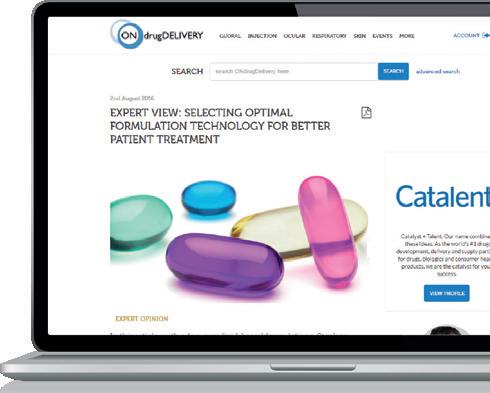

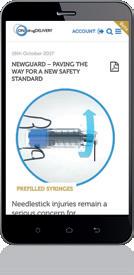

In this article, Eric Kaneps, Vice-President of Sales & Marketing at Renaissance Lakewood, discusses the benefits of nasal drug delivery compared with other administration routes – and the challenges in R&D and clinical manufacturing.
Offering non-invasive delivery and ease of use, fast onset of action and improvements in bioavailability, nasal administration is experiencing increased demand across many different indications. The nasal drug delivery market was worth US$19 billion (£15 billion) in 2022, according to Clearview Healthcare Partners, and is expected to reach $30 billion by 2030. Nasal administration is a promising delivery route for formulations containing new chemical entities (NCEs) and also the repositioning of already approved therapies through the 505(b)(2) regulatory pathway. Although nasal administration has the potential to deliver innovative products, challenges remain in nasal product R&D and clinical manufacturing. The pharmaceutical industry must address these challenges, building the foundation for product scaling and commercialisation and unlocking the full potential of nasal drug delivery.
The emergence of more research studies and clinical data has increased the understanding of nasal drug delivery, opening it up to different types of drug products.1 This has transformed it from an administration route predominantly used in local treatments for rhinitis and decongestion to a delivery method explored across many different applications. Intranasal delivery is now being explored
“The emergence of more research studies and clinical data has increased the understanding of nasal drug delivery, opening it up to different types of drug products.”
in Parkinson’s rigidity, migraine, panic attacks, Alzheimer’s disease, multiple sclerosis attacks and cardiovascular events.2 The advantages of nasal drug delivery compared with other administration routes include:
• Rapid delivery, both locally and systemically: Nasal administration offers a rapid onset of action for both local and systemic delivery. Acting locally, drugs can be delivered directly to the brain from the nasal cavity. As it is highly vascularised and rich in immune cell populations, the nasal mucosa can also help with rapid delivery and high systemic availability.3 Nasal drug delivery avoids first-pass metabolism as it bypasses the liver, which allows drug products to be absorbed directly into the systemic circulation and increases bioavailability.3 In the example of inhaled vaccines, the increased numbers of immune cells result in a rapid immune response and quick onset of action.
• Non-invasive and easy-to-use self-administration: An improved patient experience is one of the main benefits of nasal drug delivery. Nasal products are relatively easy to administer and the delivery route through the nasal cavity offers non-invasive administration. Both of these aspects mean that nasal drug delivery can offer non-invasive and easy-to-use self-administration, an advantage over other administration routes, such as injection.
• Reformulation of existing drug products: Aside from the formulation of NCEs, nasal drug delivery is also being explored for the repositioning of approved therapies with reformulation through the 505(b)(2) regulatory pathway. Repositioning has the potential to expand applications of drugs already on the market, while also delivering the additional benefits of nasal administration. Emergency injectable drugs and vaccines are examples of therapy types that could benefit from reformulation.

Eric Kaneps Vice-President of Sales & Marketing E: info@renpharm.com
Renaissance Lakewood, LLC 1200 Paco Way Lakewood NJ 08701 United States www.renpharm.com
Nasal drug delivery is also being explored for the treatment of mental health disorders, such as depression, anxiety and schizophrenia, where it can provide local administration by directly targeting the brain through the nasal cavity. Mental health treatments can often include controlled substances, which means that nasal drug developers and the final products require Drug Enforcement Administration (DEA) compliance.
Drug developers are increasingly investing in nasal drug delivery, choosing it as an administration route over oral or parenteral routes more often. However, challenges remain in nasal drug delivery R&D and clinical manufacturing that pharmaceutical companies first need to navigate to deliver the full potential of nasal administration. Specifically, nasal drug developers must overcome device and formulation challenges, ensure flexibility in clinical manufacturing and scale products to meet demand on the path to commercialisation.
As they are drug/device combinations, the final design of nasal drug products needs to be taken into account during R&D and formulation development. Nasal drug products use a spray to deliver the formulation into the nasal cavity and onto the site of action. This creates challenges in the R&D of nasal products. Both the spray device-drug formulation interactions and the formulation of the APIs themselves need to be considered. Ensuring that both the formulation and the spray device work together in combination is essential to produce a safe and effective final product.
To help ensure the safety and effectiveness of the final product, nasal drug developers should aim to perform all product development studies at the same time during R&D. Studies are required to gain insight into pre-formulation and
“The final design of nasal drug products needs to be taken into account during R&D and formulation development.”

Figure 1: It is important to understand what could affect how readily the formulation atomises when it is released from the device.
formulation development, nasal spray device selection and spray method development. Specifically, a thorough understanding of the physicochemical properties of the API and the parameters that could affect how readily the formulation atomises when it is released from the device (including viscosity, surface tension and density) helps developers understand how the final drug product will perform (Figure 1).
Nasal product developers are increasingly turning to CDMOs to help overcome the formulation challenges in R&D. Outsourcing to CDMOs can help to streamline R&D by performing preformulation, formulation, nasal spray selection and spray method development studies in unison, at the same site.
The formulation activities that developers need to perform in nasal product R&D include:
• Solution development: Determining the solubility of the drug substance and the choice of aqueous suspension, hydroalcoholic or co-solvent formulations, or non-aqueous systems.
• Excipient selection : Selecting the appropriate excipients and preservatives required to produce stable and effective formulations.
• Dose development: Defining the number of doses of the formulation that can be delivered per final device.
• Spray characteristic development: Priming, pump delivery, droplet size distribution and spray pattern, which could affect the performance of the final product.
Step 2: Overcoming Bioavailability and Solubility Issues
Although nasal administration avoids first-pass metabolism, a growing number of APIs in development have poor solubility, creating a challenge for bioavailability that must be overcome.4 Adding excipients to formulations can help with solubility and bioavailability, increasing the stability and shelf life of the final drug product. However, it can be challenging to determine the most appropriate excipients to add to a formulation.
Excipients that act as penetration enhancers or mucoadhesives can increase the contact and residence times of liquid nasal sprays in the nasal cavity, thereby enhancing permeability and increasing absorption. However, as APIs continue to increase in complexity, the choice of excipients becomes more challenging. Increasingly, novel excipients are being explored to help with more complex APIs, but developers need to ensure that excipients are safe, high quality and regulatory compliant, which is more challenging for novel excipients as they have not been used previously.
After drug developers have navigated the challenges in nasal product R&D, the next step on the journey to commercialisation is successfully navigating clinical manufacturing (Figure 2). The main challenge in clinical manufacturing is having the flexibility to meet the demands of the product. The clinical manufacturing needs of nasal spray products vary depending on the scale and scope of the project but generally include:
• Adapting to small and large batch size demands
• Preventing product wastage with limited API supplies
• Manufacturing with different devices and containers
• Sticking to stringent product development timelines
• Handling controlled substances.

Partnerships with nasal expert CDMOs can provide the flexibility required for successful clinical manufacturing. By investing in cutting-edge technologies and carefully designing manufacturing facilities, CDMOs can help to support the unique clinical manufacturing needs of nasal products. Dedicated clinical manufacturing and multiple lines can help to prevent delays and support unit dose, bidose and multidose nasal spray formulation, filling and assembly.
Other flexible clinical manufacturing services include DEA Class I–V storage, quality control and analytical testing, and
cold chain storage capabilities. Updates to facilities and processes, along with increasing nasal product knowledge, also help to ensure that CDMOs can provide long-term support to nasal drug delivery developers.
Compliance and Commercial Success
Successful R&D and clinical manufacturing build a solid foundation for the scaling of nasal drug products and commercialisation in the future. Drug developers need to carefully consider how R&D and clinical manufacturing can impact product scaling
“Drug developers need to carefully consider how R&D and clinical manufacturing can impact product scaling and commercialisation.”
Eric Kaneps is the Vice-President of Sales & Marketing at Renaissance Lakewood. He has more than 25 years of experience in sales, business development, and account management in the pharmaceutical industry. Mr Kaneps worked at DPT Laboratories as the Director of Business Development from 2001–2016. In this role, he transitioned the over-the-counter (OTC)/consumer health business towards pharmaceutical-based nasal and injectable products, which became the foundation for the new, renamed entity Renaissance Lakewood. In between his roles at the Lakewood site, Mr Kaneps was Senior Vice-President of Business Development for Pharma-Tech Industries, a contract manufacturing organisation that specialises in prescription and OTC ingestible and topical products. Mr Kaneps holds a BS BA in International Business & Economics from The Ohio State University (OH, US).
and commercialisation. Taking a proactive approach to solving challenges early in product development, and partnering with CDMOs when necessary, can help to ensure success.
Compliance with stringent regulatory guidance is a critical part of product scaling and commercialisation, ensuring the quality of the product on the journey to clinic and beyond. Nasal drug products need to comply with evolving regulatory standards, with a focus on safety that will also accelerate the path to commercialisation.
Partnerships with CDMOs can provide valuable insights, the services and capabilities required for R&D, the flexibility to navigate clinical manufacturing and support when scaling products for commercialisation. Bringing services together all under one roof helps with communication and collaboration, streamlining the approach to overcoming challenges. Ultimately, succeeding in R&D and clinical manufacturing helps to successfully develop innovative nasal drug products and deliver them to the patients who need them.
Renaissance Lakewood is a global CDMO for pharmaceutical and biotech companies. With more than 20 years of experience in nasal sprays and sterile injectable dosage forms, Renaissance has an unparalleled track record of providing exceptional service and resources to clients from the development stage through to commercial launch.
1. Vargason AM, Anselmo AC, Mitragotri S, “The evolution of commercial drug delivery technologies”. Nature Biomed Eng, 2021, Vol 5(9), pp 951–967.
2. Touitou E, Illum L, “Nasal drug delivery”. Drug Deliv Transl Res, 2013, Vol 3(1), pp 1–3.
3. Lim ST et al, “Physiological factors affecting nasal drug delivery” in “Enhancement in drug delivery” (Touitou E, Barry BW, eds). CRC Press, 2007.
4. “CPHI experts: 90% of current pipeline APIs are poorly soluble”. GlobalData Healthcare, May 10, 2018.



